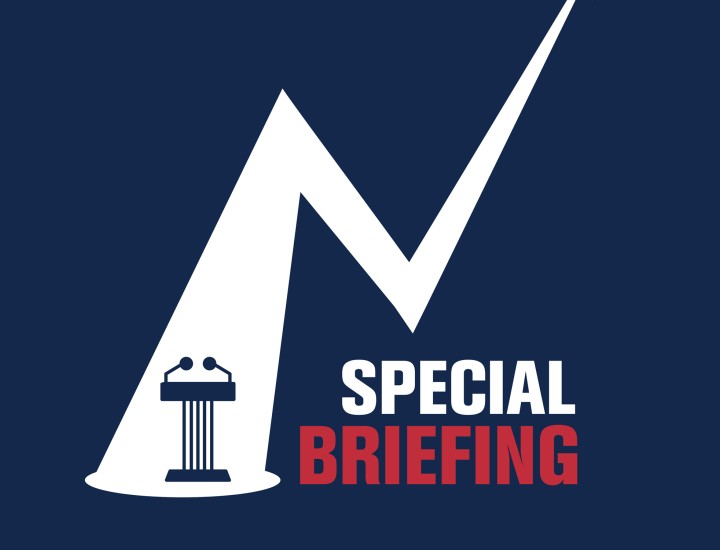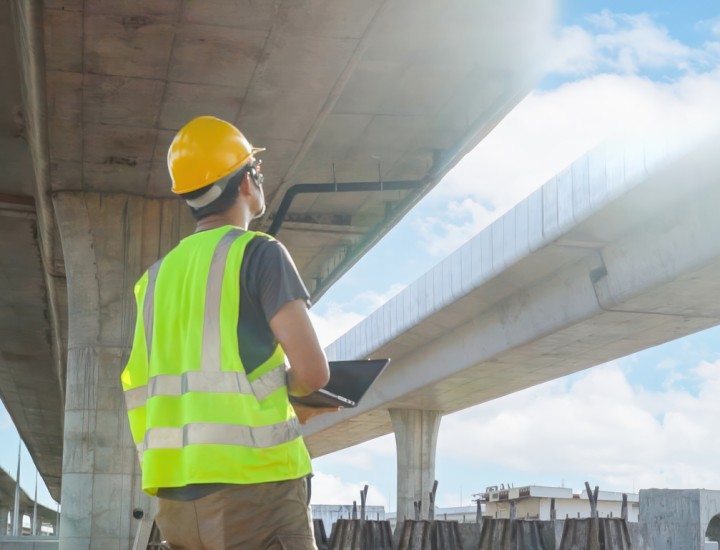Meeting the Trillion-Dollar Challenge: Case Studies
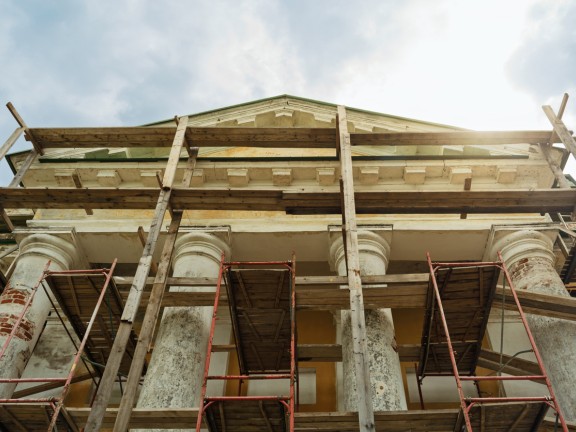
Deferred Infrastructure Maintenance Practices Across Ten States
EXECUTIVE SUMMARY
Publicly owned infrastructure in the US is in a poor state of repair, with an estimated $1 trillion in accumulated deferred maintenance across states.1 Budget constraints and competing priorities often lead government agencies to postpone or delay planned maintenance to make funds available for other pressing needs. This failure to keep up with repairs results in increased long-term maintenance expenditures, and, in some cases, compromises public safety and health. Despite the growing concern, few states report deferred maintenance needs in their capital budgeting documents, and no comprehensive statewide system exists to assess, value, and fund the infrastructure gap.
However, nine states—Alaska, California, Hawaii, Idaho, Illinois, Massachusetts, Montana, Oklahoma, and Pennsylvania—have implemented statewide efforts to assess and address deferred maintenance. This study explores their policies and methodologies for reporting, valuing, and funding their deferred maintenance needs. We also examine policies in Tennessee, which has reported infrastructure needs for decades, including new construction and deferred maintenance. While it does not provide a specific estimate for its deferred maintenance exposure, Tennessee is included as a case study because of its potential to inform future assessment efforts in other states.
Policies developed by states such as these to identify, quantify, and fund their deferred infrastructure maintenance needs are especially important today. As the White House and Congress shrink programs and funding benefiting all fifty states, the states will need to become more self-reliant in areas directly affected by infrastructure policies, including public health, education, transportation, and disaster prevention and mitigation. Allowing deferred infrastructure maintenance shortfalls to widen will only present challenges for the funding and delivery of critical public services across the board.
This report, the first in a series of three published concurrently, compares varying definitions of maintenance and deferred maintenance, policies enabling statewide assessment and reporting, and processes used to assess deferred maintenance needs. It also summarizes accumulated deferred maintenance needs and associated funding allocations, and reviews state strategies to address current gaps and prevent future backlogs. In the other two reports we present (a) toolkits for policymakers and advocates across the US who may wish to emulate the reforms adopted by the nine selected states; and (b) a review of deferred infrastructure maintenance disclosure—or lack thereof—in capital budgets and centralized capital improvement plans across all fifty states.
Definitions of Deferred Maintenance and Maintenance
Most states analyzed use the terms deferred maintenance, deferred maintenance needs, deferred maintenance costs, deferred maintenance deficiencies, and deferred maintenance backlogs interchangeably, with a few referring to them as critical repairs. Three common elements emerge in the states’ definitions of deferred maintenance:
FRAMING THE DEFINITION. Deferred maintenance is generally described as maintenance that is postponed, delayed, or underperformed. The concept of maintenance in analyzed states often refers to repairs that are recurrent and scheduled to maintain, preserve, and extend the functionality of the infrastructure.
CLARIFYING THE POINT AT WHICH MAINTENANCE IS REGARDED AS DEFERRED. A certain amount of maintenance should be provided in a given period. Maintenance becomes deferred if not conducted by the end of this period. Only two states define this period explicitly: Hawaii, according to the repair and maintenance cycle; and Alaska, according to the budget cycle.
SPECIFYING THE SCOPE AND OWNERSHIP OF THE INFRASTRUCTURE. Hawaii and California specify the types (e.g., building, facility, or other improvement) and ownership (typically state-owned) of infrastructure covered in their deferred maintenance assessments.
Alaska, Idaho, Illinois, and Oklahoma also provide reasons for postponing maintenance activities in their definitions. The most common is insufficient funding, followed by perceived lower priority. Last, while definitions of maintenance are included in state statutes, definitions of deferred maintenance typically appear only in documents reporting on that topic.
Policy at the State Level Enabling Deferred Maintenance Assessment and Reporting
Statewide assessment of deferred maintenance requires policy direction from legislation or the governor to guide the process and delineate responsibilities of state agencies involved. These policies are important to align efforts from all state agencies and to ensure compliance. Of the ten states analyzed, Hawaii, Alaska, Idaho, Massachusetts, Montana, and Tennessee provide explicit guidance for assessing and reporting deferred maintenance or infrastructure needs. Pennsylvania refers to deferred maintenance in statutes, though public information on assessments, needs, and funding is limited. California, Illinois, and Oklahoma report deferred maintenance needs and allocate funding to them. California and Illinois lack a statewide policy, however, and Oklahoma only recently adopted one.
Policies typically designate a lead state agency—often the department or office in charge of budgeting and finance or administration—to collect, store, and report deferred maintenance information or infrastructure needs. Policies also determine the responsibility of other state agencies, either by requiring or encouraging them to provide information on deferred maintenance or infrastructure needs to lead agencies.
Policies in Hawaii, Alaska, and Idaho also require a plan to address deferred maintenance needs. The plans generally include an inventory or list identifying deferred maintenance pro-jects; a schedule for addressing deferred maintenance needs; criteria for prioritizing projects; and available funding sources to address deferred maintenance needs.
Assessing and Budgeting for Deferred Maintenance Needs
The process for assessing deferred maintenance needs and budgeting for them varies among analyzed states and depends largely on the types of infrastructure considered in the assessment. Most analyzed states limit assessment to buildings; California and Hawaii assess a broader range of infrastructure, including transportation assets. These considerations may be narrowed further by type of ownership (e.g., state, local); funding source (e.g., general and unrestricted funds), or cost thresholds (e.g., assets with certain replacement values).
Assessment processes also differ according to their scope. States assessing a broader range of infrastructure often use a decentralized approach, relying on separate state agencies to perform assessment tasks; those focused on buildings typically use a centralized approach and a designated lead state agency. The process is generally consistent across state agencies, including developing inventories; conducting facility condition assessments with regular physical inspections of the infrastructure to assess condition and identify deferred maintenance needs; and storing information in asset management systems for ongoing upkeep, monitoring, and sharing purposes.
Estimating Deferred Maintenance Needs
Comparing deferred maintenance needs in the analyzed states is challenging because of differences in the types of infrastructure included in their assessments. Of the nine analyzed states reporting deferred maintenance needs, only six disclose a total estimate amount for the assets they consider (see table 1). In these states, the largest contributors to deferred maintenance needs are the departments of education (including the school system and the college and university systems), corrections, and human services. Massachusetts and Oklahoma currently report only on the needs of education systems.
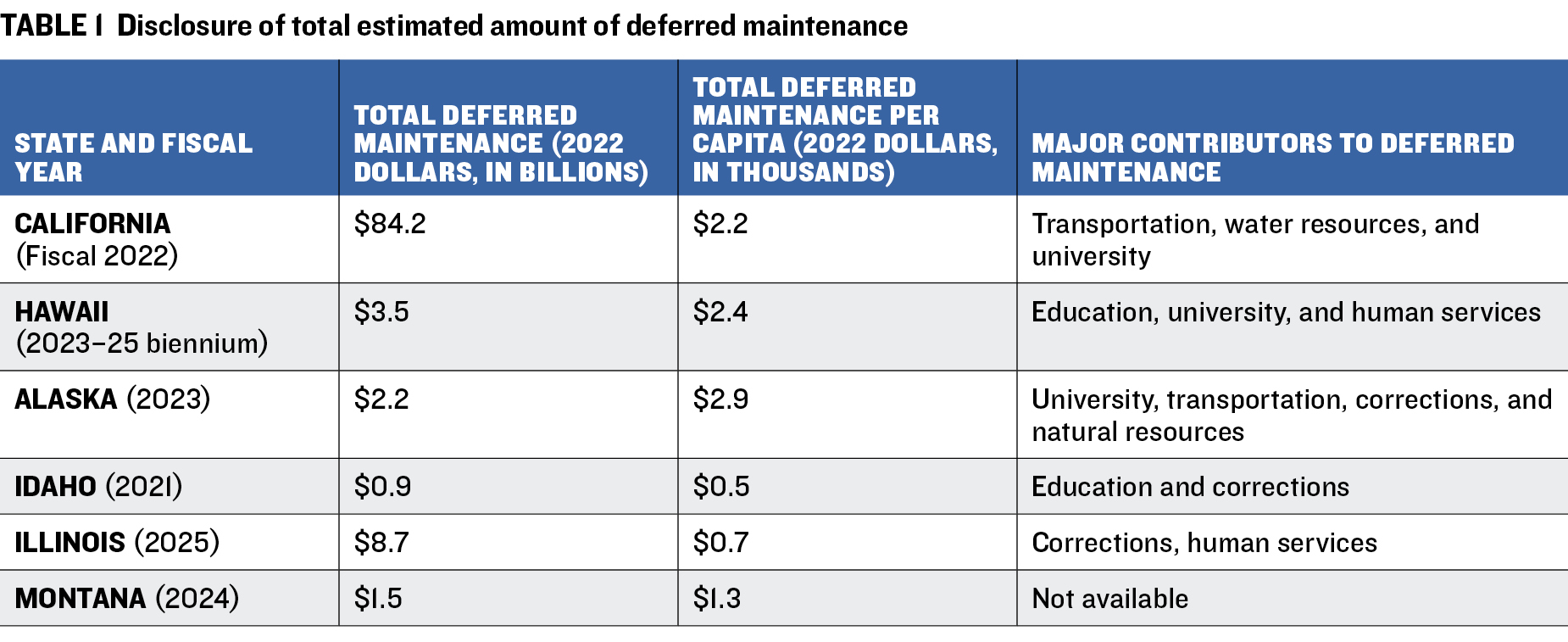
While not reporting deferred maintenance needs specifically, Tennessee estimates and reports its total infrastructure needs at $68.3 billion (in 2022 dollars) for 2022–27. Primary contributors include the state’s transportation, education, and water and wastewater departments.
Prioritization of Deferred Maintenance Projects
With limited funding to address pressing infrastructure needs, some analyzed states have developed processes to prioritize deferred maintenance needs. These processes vary in approach, methods, and metrics. California and Hawaii, which consider broad types of infrastructure, prioritize deferred maintenance projects primarily at the agency level. States focused on buildings, such as Alaska, Idaho, Massachusetts, Montana, and Oklahoma, take a two-step approach: Individual agencies submit their priorities, and the lead agencies prioritize projects according to statewide goals.
States also use different methods—from a data-driven approach that uses the facility condition index (FCI) as a metric, to a consensus-driven one that subjectively assesses a need’s criticality or urgency within the system with metrics such as the mission alignment index (MAI) and the system factor. They may also take a hybrid route that combines elements of various methods. Other metrics include funding leverage, legal obligation, mandates, and phases of the project already funded.
Funding Allocations for Addressing Deferred Maintenance Needs
Seven analyzed states rely on a mix of funding sources to address deferred maintenance needs; the primary sources are general funds, followed by special funds (see table 2). A few states have also issued bonds to finance deferred maintenance. All analyzed states report the total amount of funding requested to address deferred maintenance needs in budget documents and line items of the amounts of funding appropriated to address these needs in appropriation bills. Only two states, California and Alaska, report both the total deferred maintenance backlog and the aggregated total amount of funding appropriated in a single report.
Funding appropriations in analyzed states typically cover less than 4 percent of identified deferred maintenance needs. For example, pre-2020 allocations in Alaska and California covered, on average, about 4.5 percent and 0.6 percent of needs, respectively.
Current and Future Plans for Addressing Deferred Maintenance
While all the analyzed states plan to continue their current efforts to address deferred maintenance backlogs, few have determined next steps or areas for improvement in their processes. Key strategies identified include:
EMPHASIZING EARLY INVESTMENTS IN PREVENTIVE MAINTENANCE TO AVOID DEFERRED MAINTENANCE. In a slide deck prepared for a 2022 presentation to the Alaska House Finance Committee, state Office of Management and Budget Director Neil Steininger and Director of Facilities Services Melanie Arnolds said that while there is “no one definitive rule on the level of preventive maintenance necessary to avoid deferred maintenance,” they reported that a 2012 National Research Council publication cites “a range of 2-4 percent of replacement cost value.”2 Analyzed states that provide information invest less than this amount.
IMPLEMENTING TARGETED PLANS TO REDUCE EXISTING DEFERRED MAINTENANCE COSTS. Such plans focus on prioritizing and investing in deferred maintenance and often involve creating dedicated capital budget categories for deferred maintenance projects to distinguish them from other capital projects; and requiring state agencies to prioritize deferred maintenance and preventive maintenance over new capital projects (one state is considering establishing a facility condition index threshold for existing facilities for state agencies to meet before embarking on new capital projects).
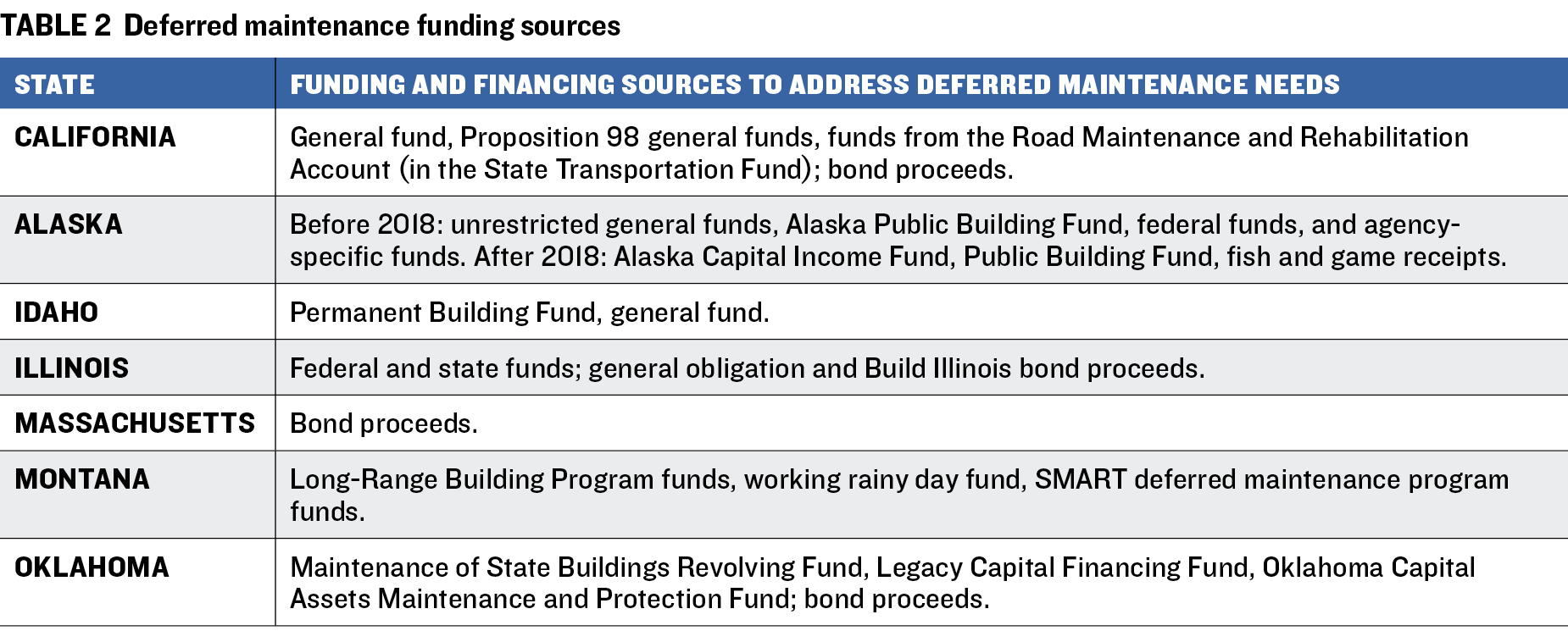
They also include temporarily increasing or establishing a consistent funding stream that provides ongoing funding to address current backlogs.
INTRODUCTION
From the deteriorating Gowanus Expressway in Brooklyn, New York, to the aging dams that supply about 70 percent of California’s water, America’s public infrastructure is badly in need of rehabilitation.3 The nation is estimated to have accumulated about $1 trillion in deferred infrastructure maintenance4—broadly defined as recurrent and scheduled repairs that were postponed in favor of more pressing spending needs. Although such delays are viewed as saving money in the short run, they generally result in higher long-term maintenance expenditures and compromise public safety and health. And unlike financial liabilities such as bonded debt, pension obligations, and retiree health benefits, which state (and local) governments are required to disclose in standardized formats, deferred maintenance backlogs are rarely incorporated into capital budgets, annual comprehensive financial reports, or infrastructure needs assessments. This omission obscures the full scale of fiscal risk and hinders informed decision-making about infrastructure investment and public asset management.
Addressing this backlog is critical for the health of America’s $24 trillion economy.5 While Congress authorized $550 billion in new federal infrastructure outlays in 2021 as part of a broader post-COVID-19 economic recovery package,6 the primary responsibility for infrastructure investment continues to lie with state and local governments, which account for 79 percent of the nation’s public infrastructure.7 In light of constraints on federal funding and program support, state and local governments will continue playing a leading role in the upkeep and modernization of the infrastructure necessary to meet the evolving demands of the twenty-first century.
Recognition of the urgency around deferred maintenance is gradually spreading across the country. Nine states—Alaska, California, Hawaii, Idaho, Illinois, Massachusetts, Montana, Oklahoma, and Pennsylvania—have made a constructive start on easing the trillion-dollar infrastructure crisis by implementing statewide efforts to assess and address deferred maintenance. In addition, Tennessee has for almost three decades provided an example for other states by conducting periodic statewide inventories of infrastructure needs, a critical first step for valuing and funding capital investment backlogs.
In this working paper, we examine the assessing, valuing, funding, and reporting of deferred maintenance in these ten states. Our discussion includes an explanation of the difference between ongoing and deferred maintenance, policies enabling statewide assessment and reporting, and processes used to assess deferred maintenance needs. We also provide updated summaries of the analyzed states’ accumulated deferred maintenance needs and associated funding allocations, including a review of their strategies to address current gaps and prevent future backlogs. Accompanying this study, we offer (a) a tool kit for governors, budget directors, legislators, and other stakeholders who may wish to address deferred maintenance gaps in their own states; and (b) a review of deferred infrastructure maintenance disclosure—or lack thereof—in capital budgets and centralized capital improvement plans across all states.
METHODOLOGY
This study involves a qualitative research approach. The research team conducted case studies on ten geographically diverse states to understand the policies, processes, and plans to assess and address deferred maintenance needs. Alaska, California, Hawaii, Idaho, Illinois, Massachusetts, Montana, Oklahoma, Pennsylvania, and Tennessee were selected for in-depth analysis because they already conduct statewide efforts to assess and address their deferred maintenance needs or produce statewide infrastructure inventories that could contribute to the assessment of deferred maintenance as identified in America’s Trillion-Dollar Repair Bill: Capital Budgeting and the Disclosure of State Infrastructure Needs.8 This is not a representative sample, as states were chosen based on their leadership in this area.
Researchers studied key data points to understand how deferred maintenance needs are assessed and addressed: policies that enable statewide deferred maintenance assessment and reporting; definitions of current and deferred maintenance; processes to assess deferred maintenance needs, including agencies leading the efforts; state agencies involved in the assessment process or from which information on deferred maintenance needs are required; the type of assets included in the assessment; and the planning and budgeting for deferred maintenance needs. As part of the review, researchers also examined accumulated deferred maintenance needs and funding allocations to address them. Last, they looked at strategies that states undertook or considered for implementation to address current and prevent future deferred maintenance needs.
The study involved two phases. In the first phase, the research team reviewed documents available online to gain an initial understanding of states’ policies and processes. They scrutinized policy documents such as executive orders, senate and house bills, statutes; budgetary guidelines and directives; budget handbooks and instruction letters; and documents such as executive, capital, and operating budgets; and longer-term plans such as capital improvement plans (CIPs) and infrastructure plans. Statewide reports about deferred maintenance were also reviewed.
In the second phase, the team conducted interviews with state officials involved in the deferred maintenance assessment process. They included budget directors, directors of a fiscal division, budget analysts, financial administrators, research directors, research analysts, and legislative budget analysts in California, Hawaii, Idaho, Massachusetts, Montana, and Tennessee. Researchers interviewed seventeen state officials in seven individual and group sessions. Interviews were conducted from May 2024 to February 2025. State officials from Alaska did not participate in interviews but provided responses to inquiries via email. Analyses of states where interviews were not conducted were based on reviews of official documents.
In this paper, the researchers present findings about states ordered by the type of infrastructure considered in the deferred maintenance assessment. They first discuss findings from states that consider a comprehensive list of assets (California and Hawaii), followed by those that focus on a subset, such as buildings (Alaska, Idaho, Illinois, Massachusetts, Montana, Oklahoma, and Pennsylvania). Findings from Tennessee are presented at the end, as they focus broadly on infrastructure needs, extending beyond deferred maintenance.
FINDINGS
Definitions of Maintenance and Deferred Maintenance
Defining “maintenance” and “deferred maintenance” is crucial to provide clarity and avoid misunderstanding among stakeholders involved in assessing deferred maintenance needs. Table 3 presents the definitions used in the analyzed states. It is worth noting that most states use the terms deferred maintenance, deferred maintenance needs, deferred maintenance costs, deferred maintenance deficiencies, and deferred maintenance backlog interchangeably. A few states refer to deferred maintenance as critical repairs. For purposes of uniformity, we use the term “deferred maintenance needs” throughout the analysis in this report; only when discussing specific aspects do we adopt the state’s terminology.
The definitions of deferred maintenance used by the analyzed states have three common elements:
FRAMING THE DEFINITION. All states refer to deferred maintenance as maintenance that is postponed, delayed, or underperformed. This requires reviewing the definition of maintenance to have a better understanding of the concept. Among analyzed states, the concept of maintenance generally refers to infrastructure repairs that are recurrent and scheduled to maintain, preserve, and extend its functionality. Alaska highlights efforts to keep infrastructure “operational and in a continuous state of readiness,” while California stresses efforts to keep infrastructure “in an acceptable and operable condition.” Hawaii is particular in defining deferred maintenance as the cost of catching up with maintenance that was delayed, which acknowledges additional costs incurred for not performing it on time.
CLARIFYING THE PERIOD IN WHICH MAINTENANCE BECOMES DEFERRED. A certain amount of maintenance should be provided within a given period, and maintenance becomes deferred if not completed in that time frame. Two of the ten states specify such a period. In Hawaii, it is the repair and maintenance cycle; in Alaska, it is the state’s annual operating budget cycle.
SPECIFYING THE TYPES OF INFRASTRUCTURE CONSIDERED AND THEIR OWNERSHIP. Two states refer to the type of infrastructure in their definition of deferred maintenance. Hawaii cites “state-owned building, facility, or other improvement,” while California pinpoints “state-owned facilities.” Both specify the state as the owner of the infrastructure. California Senate Bill 1, enacted in 2017, provides deferred maintenance guidance for state and local highways, roads, and streets, including the types of infrastructure considered. In their definitions, four states—Alaska, Idaho, Illinois, and Oklahoma—provide reasons for postponing maintenance.
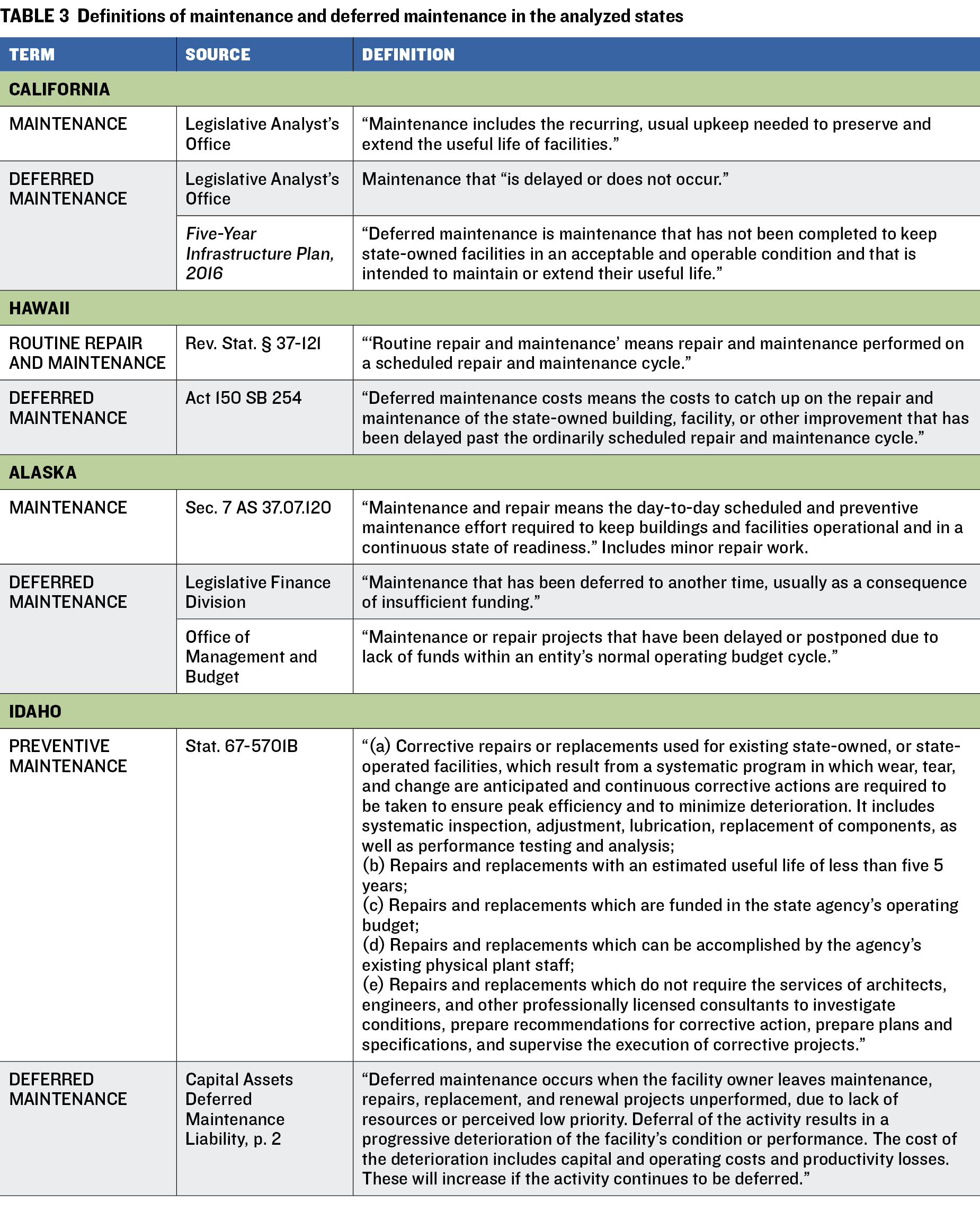
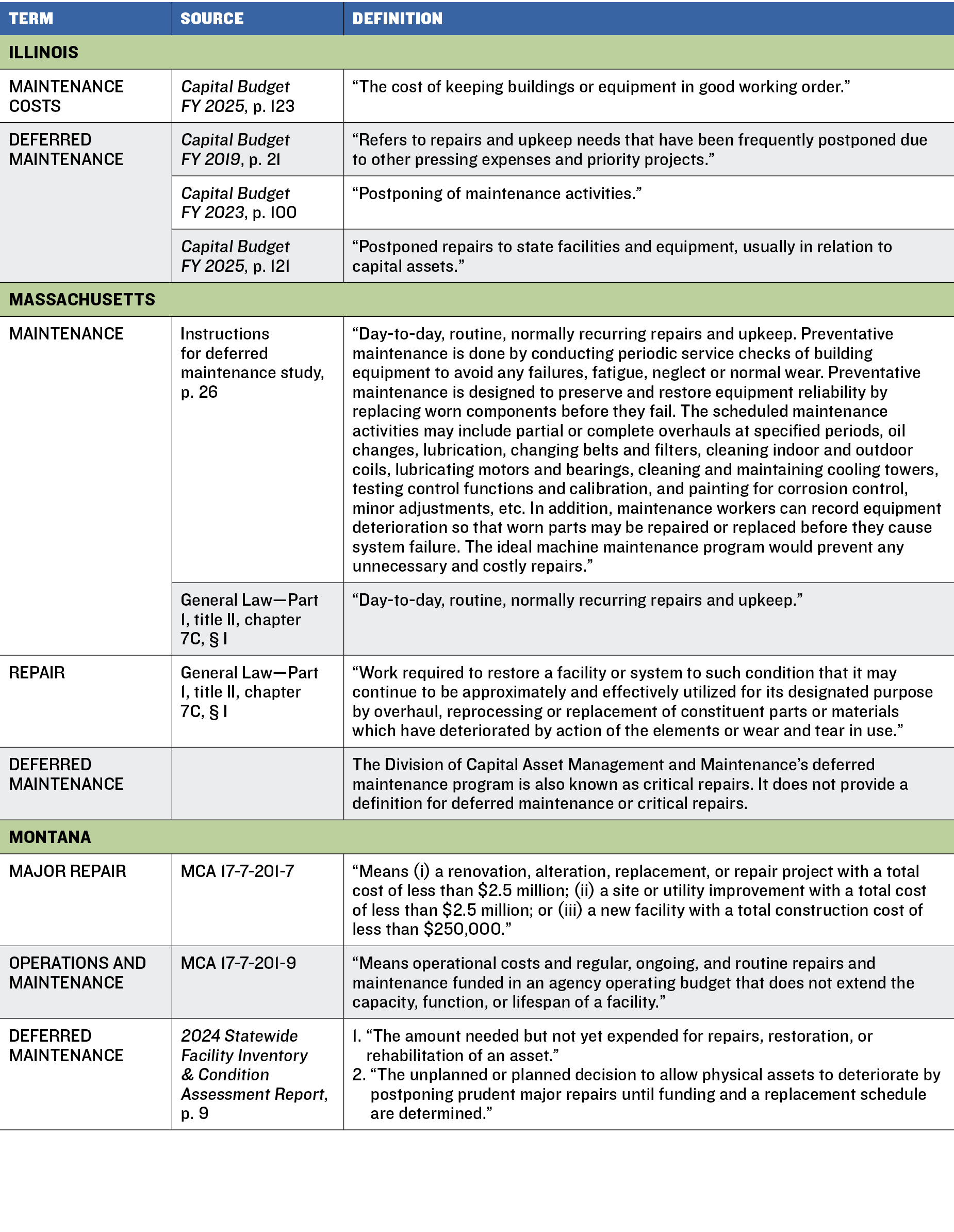
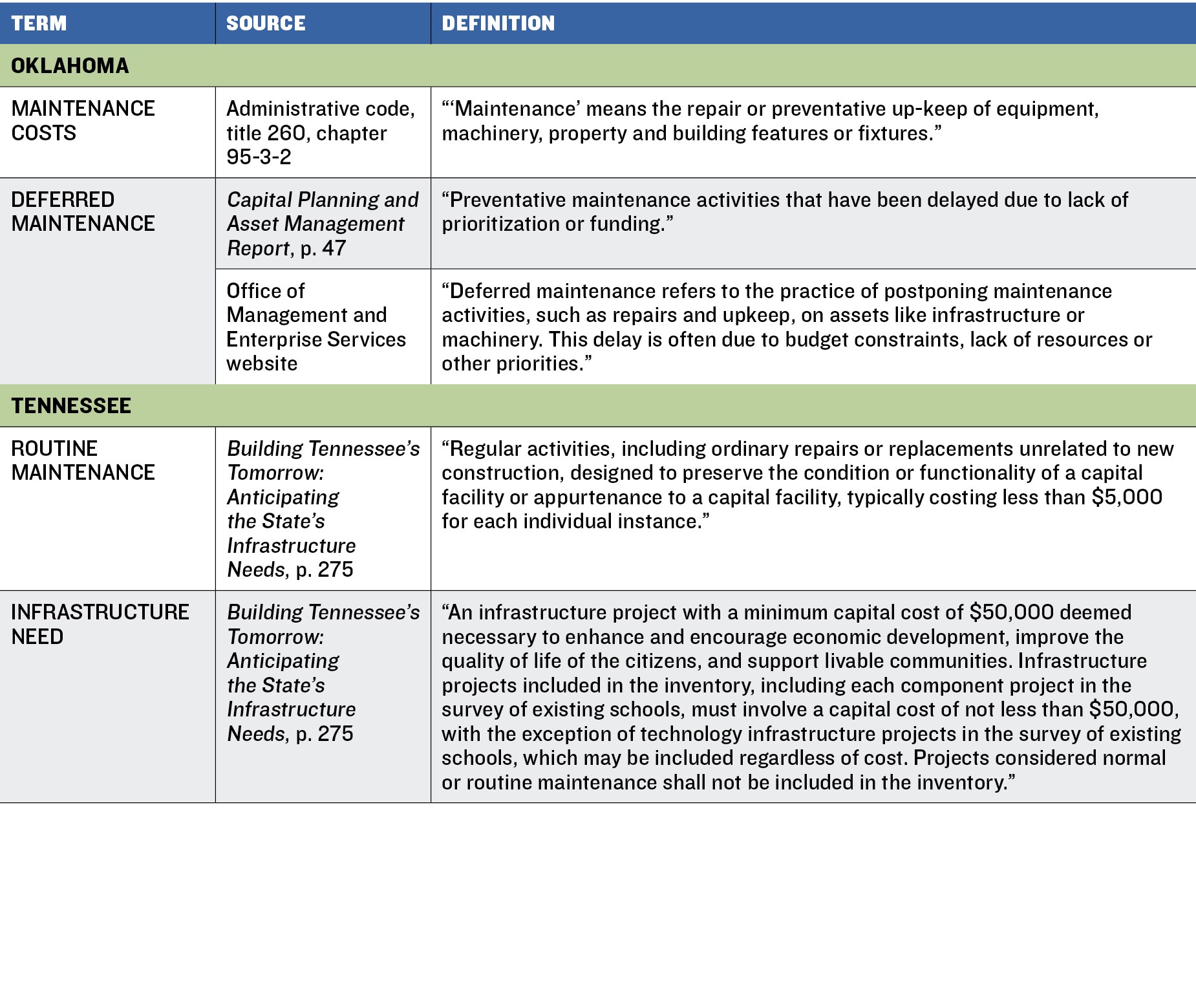
These include insufficient funding (Alaska, Idaho, and Oklahoma), or perceived low priority (Idaho, Illinois, and Oklahoma). Although reasons for postponing maintenance are not included in its definition of deferred maintenance, California’s infrastructure plan and Legislative Analyst’s Office reports also refer to such reasons. They include insufficient funding, diversion of funding to other operational purposes, and poor facility management practices.9
DEFINING DEFERRED MAINTENANCE. While the definition of the word maintenance is generally included in state statutes, the definition of the term deferred maintenance is often included only in documents specific to the topic. Before adopting a definition of deferred maintenance, states often use a definition provided by another organization. In Alaska, for instance, the definition provided by the Federal Accounting Standards Advisory Board was recommended.10 Similarly, in Idaho, executive order No. 2021-10 required adoption of a statewide definition of deferred maintenance to quantify deficiencies. The definition was taken from a report issued by the National Association of State Facility Administrators.11
Policies at the State Level Enabling Deferred Maintenance Assessment and Reporting
Statewide assessment of deferred maintenance requires legislative or executive policies that provide guidance on the process and delineate responsibilities of state agencies. These policies are important to align efforts from all agencies and ensure that they comply with them. Among analyzed states, Hawaii, Alaska, Idaho, Massachusetts, and Montana provide explicit guidance for assessment and reporting of deferred maintenance, and Tennessee for infrastructure needs. Pennsylvania also refers to deferred maintenance in statutes but has limited public disclosure of assessments, accumulated needs, and funding. Oklahoma adopted policies that formally discuss deferred maintenance in 2024, but the state budgeted and funded deferred maintenance needs before that. By contrast, California and Illinois do not have a policy that explicitly requires deferred maintenance assessment or reporting. Both states report deferred maintenance needs and have funding appropriations to address them, however.
The analyzed policies typically designate a state agency to lead the collection and reporting of deferred maintenance information or infrastructure needs. The Department of Budget and Finance in Hawaii, the Office of Management and Budget (OMB) in Alaska, the Department of Administration (DOA) in Idaho, the Division of Capital Asset Management and Maintenance in Massachusetts, the Architecture and Engineering Division in Montana, and the Tennessee Advisory Commission on Intergovernmental Relations (TACIR) undertake these efforts.
Typically, other entities provide these agencies with data on deferred maintenance or infrastructure needs. Some policies require these entities to provide such information. In Hawaii, executive agencies responsible for operating or maintaining a state-owned building, facility, or other improvements must provide deferred maintenance estimates. Some policies encourage collaboration between entities. Idaho’s DOA works in partnership with the Permanent Building Fund Advisory Council and other necessary parties to develop a deferred maintenance report. And some policies authorize leading entities to request information but do not mandate that other entities submit it. In Tennessee, for instance, TACIR consults with state and local officials and can request infrastructure needs from state agencies.
In Hawaii and Alaska, the policies require a plan to address deferred maintenance needs. In Hawaii, the plan is required from the governor; in Alaska the OMB develops the plan, and the DOA administers it. In Idaho, the policy requires a series of steps to report on deferred maintenance needs, but these are similar to those identified in the other states. These plans have four common components. First, they all require an inventory of deferred maintenance projects (Tennessee’s infrastructure needs inventory provides a comprehensive example of efforts to consider and carry out.) Second, the plans of Idaho and Hawaii require identifying a timeline or schedule to address deferred maintenance needs. Third, the plans of Idaho and Alaska require criteria for project prioritization. Finally, the plans consider funding for deferred maintenance needs.
The following paragraphs provide details on the existing policies that enable deferred maintenance assessment and reporting for each state selected as a case study.
California
Although California does not have a statewide policy that explicitly requires deferred maintenance assessment or reporting, the state does report deferred maintenance in its infrastructure plan. The California Infrastructure Planning Act (CIPA) requires the governor to submit an updated five-year infrastructure plan to the legislature annually in conjunction with the governor’s budget. The plan must contain information concerning infrastructure needed by state agencies, schools, and postsecondary institutions; set out priorities for funding; and identify funding for the needed infrastructure.
The infrastructure plan provides information on statewide deferred maintenance needs in “Maintaining Existing Infrastructure.” The section offers a definition of deferred maintenance, reports the estimates of statewide deferred maintenance needs for the year, and identifies funding and financing opportunities. It also provides information on the governor’s proposed onetime resource allocation in the executive budget for addressing deferred maintenance needs each year.
In addition to the CIPA, Following passage of Senate Bill 1 (Chapter 5, Statutes of 2017), California established its Road Maintenance and Rehabilitation Program to address deferred maintenance on the state highway and local road system. It requires the California Transportation Commission to adopt performance criteria consistent with the asset management plan to ensure efficient use of resources and provides additional funding for deferred maintenance projects.
Hawaii
Act 150 (SB 254—June 26, 2015) requires that each executive agency responsible for operating or maintaining a state-owned building, facility, or other improvements provide the Department of Budget and Finance with an estimate of the deferred maintenance costs for the building, facility, or other improvements. The department is not required to ensure the accuracy of the information in the reports (Haw. Rev. Stat. § 37-122). The act also requires a summary of deferred maintenance costs collected by the director of finance to be included in the multiyear program, financial plan, executive budget documents, and supplemental budget. The multiyear program, financial plan, and executive budget are submitted to the legislature before the regular session in each odd-numbered year. The supplemental budget is submitted to the legislature before the regular session of each even-numbered year.
Senate Bill 719 (Jan. 20, 2017) found the extent of the state deferred maintenance backlog to be substantial and requires the governor to prepare a deferred maintenance plan12 to gradually eliminate the gap for state-owned buildings, facilities, and other improvements. According to the legislation, the act was found necessary to preserve facilities for public use or benefit, decrease future unfunded state obligations, preserve public resources by making maintenance investments instead of incurring expensive capital replacement or renewal costs, and promote transparency.
SB 719 provides the characteristics that should be included in the plan for it to be a guide for eliminating deferred maintenance costs. These include a target date and alternatives to the target date to address and eliminate the accumulated deferred maintenance costs; standards and criteria, as well as the designation of a state executive agency responsible for calculating deferred maintenance costs; an estimate of the total amount of funds necessary to eliminate deferred maintenance costs; and a proposed schedule and alternatives to the proposed schedule to eliminate deferred maintenance costs. The bill also requires the governor to update the plan annually.
Alaska
Although not enacted into law, House Bill 364 (July 1, 2002) proposed authorizing the Department of Administration to implement a plan developed by the Office of Management and Budget to undertake and finance deferred maintenance for state-owned capital facilities. The proposed plan would be required to identify capital projects to be addressed and their deferred maintenance costs, and prioritize projects based on available resources and emergent needs.
Idaho
Executive order no. 2021-10, “Transparency in Budgeting,” highlights the importance of estimating the cost of deferred infrastructure maintenance liabilities for state capital assets to further transparency in budgeting and ensure the state is properly investing in preventive maintenance.13 The order tasked the Department of Administration with developing a report on deferred maintenance liabilities in collaboration with the Permanent Building Fund Advisory Council14 and any other necessary parties. The order called for development of a consensus definition of the term “deferred maintenance” to improve measurement and enable better comparisons among state agencies and institutions; inventorying of the current cost of deferred infrastructure maintenance liability for the state’s capital assets by agency or institution, type of maintenance needed, and timeline necessary to address the maintenance; recommendation of best practices in funding deferred maintenance needs; and establishment of criteria for prioritization of project funding based on the criticality of the deferred maintenance.15
Illinois
Although the state does not have a statewide policy that explicitly requires deferred maintenance assessment or reporting, it does report deferred maintenance in the annual capital budget. The Governor’s Office of Management and Budget (GOMB) Act requires all state agencies to prepare and submit annual long-range capital expenditure plans (20 ILCS 3005/). These plans should include details of each project for the next three fiscal years, as well as project costs in current dollars, future maintenance costs, expected lifespan, and impacts on the agency’s annual operating budget.
According to the Illinois Capital Budget Act, the OMB is responsible for coordinating preparation of five-year capital improvement programs, which are updated annually, and yearly capital budgets in cooperation with all state agencies requesting a capital appropriation. The programs inventory the state’s capital assets; assess needs and resources; plan for capital investments and maintenance of existing facilities; and analyze the relationships between capital, maintenance, and operating spending. Each capital improvement program should include a needs assessment of the state’s capital facilities outlining the inventory; age; condition; use; sources of financing; past investment; maintenance history; trends in condition, financing, and investment; and projected dollar amount of need in the next five- and ten- year periods.
Massachusetts
The Division of Capital Asset Management and Maintenance (DCAMM)—created by the legislature in 1980 and within the Executive Office for Administration and Finance—is responsible for administering all capital planning, major public building construction, and facilities management activities for state-owned buildings (Office of the State Auditor, 2018). According to Chapter 7C, Section 2 of the General Laws, the commissioner of Capital Asset Management and Maintenance is required to carry out the systematic review of capital assets, scheduling of routine and scheduled maintenance repairs, tracking of deferred maintenance needs of capital assets, and coordinated planning of capital facilities in relation to the programmatic needs of state agencies.
According to Chapter 7C, Section 9 of the General Laws, the commissioner should prepare an analysis of the projected annual maintenance costs of each state building for which the final design was completed in the prior year. The projections are made over the useful life of buildings that are estimated to cost more than $5 million. In subsequent fiscal years, maintenance costs estimated in this analysis are to be included by the agency responsible for the operation and upkeep of the building in its annual budget request, along with revisions to the maintenance costs originally projected by the commissioner.
The commissioner is also responsible for preparing and revising a proposed capital repair and maintenance plan for state buildings subject to the jurisdiction of DCAMM. This five-year capital investment plan should include an analysis of costs and benefits of continuing minor repairs versus costs and benefits of major renovation, rehabilitation, or replacement of the state buildings. This report must be submitted each February to the House and Senate Ways and Means committees and the chairs of the joint committee on state administration and regulatory oversight.
Montana
In 2017, the legislature passed Senate Bill 43 to reduce the increasing deferred maintenance backlog of state-owned buildings. The resulting law required the Department of Administration’s Architecture and Engineering (A&E) Division to establish a facility condition assessment (FCA) program to evaluate building conditions and to track and address the backlog over time.16 The bill amended two sections of the state’s annotated code, § 17-7-201 and § 17-7-202.
MCA § 17-7-202 provides that each state agency and institution shall submit a proposed long-range building program (LRBP) to A&E. The division must compile and maintain a statewide facility inventory and condition assessment that includes state-owned buildings and buildings eligible for an LRBP.
Among other provisions, for each state-owned building, A&E must identify the location and total square footage; identify the agency or agencies using or occupying the building; list the building’s current replacement value (CRV) in its entirety and for each agency’s portion of the building; and identify if the building is LRBP-eligible. A&E is not required to include a state-owned building with a CRV of $150,000 or less in the facility inventory and condition assessment.
For LRBP-eligible buildings, A&E must include an FCA and an itemized list of the building’s deficiencies and also compare its current deficiency ratio to that in the previous biennium.
For the statewide facility inventory and condition assessment, A&E may contract with a private vendor to collect, analyze, and compile the information required. The division is required to provide the facility inventory and the condition assessment, along with the calculation of the deferred maintenance backlog and overall building deficiency ratio of the building eligible for a long-range building program, to the Office of Budget and Program Planning and the legislative finance committee by Sept. 1 of the year preceding a legislative session.
Oklahoma
In 2012, Senate Bill 1052 recognized that steps must be taken to change the process of decision-making on capital facilities, which at the time was done individually by over 160 state agencies.17 In particular, the bill provided specific requirements for planning, budgeting, and developing an annual capital plan. Previously, the state had only a four-year capital improvement plan. The bill also required the Office of Management and Enterprise Services (OMES)18 to produce a report with recommendations for integrating and consolidating management of capital assets, including construction, maintenance, and real property management processes. In providing the recommendations, OMES suggested including deferred maintenance as part of capital budgeting.
The legislature finally passed the Oklahoma Capital Assets Maintenance and Protection Act in 2024 (Stat. § 73-188). The act authorized the Oklahoma Capitol Improvement Authority to provide funding for repairs, refurbishments, deferred maintenance, and improvements to property.
Pennsylvania
Title 8 § 1309 of the Consolidated Statutes of Pennsylvania indicates that the budget should provide for deferred maintenance. According to the statute, the budget must be as comprehensive and precise as available information will permit. In addition to expenditures proposed for the current fiscal year, the budget should also include a sum sufficient to cover any existing indebtedness and ordinary operating expenses for the subsequent year. It may also include funds to provide, in whole or in part, for any deferred maintenance, depreciation, and replacements.
Tennessee
In 1996, the Public Infrastructure Needs Inventory Act directed the Tennessee Advisory Commission on Intergovernmental Relations19 (TACIR) to compile and maintain an inventory of infrastructure needs. (Tenn. Code Ann. § 4-10-109). The data from the inventory are deemed necessary to support efforts by state, county, and municipal governments in developing goals, strategies, and programs to provide adequate and essential public infrastructure.
The law also delineates information and processes, including definitions and types of public infrastructure facilities that, at a minimum, must be included in the inventory; data collection guidelines; stakeholders to consult in compiling the information; and presentation requirements. Among the law’s provisions are rules for:
ASSESSING PUBLIC INFRASTRUCTURE FACILITIES. These includes facilities that enhance and encourage economic development; improve the quality of life of residents; and support livable communities within each municipality, utility district, county, and development district region of the state. The inventory must also cover needs for transportation, water and wastewater, industrial sites, municipal solid waste, recreation, low- and moderate-income housing, telecommunications, public buildings (including city halls, courthouses, and K–12 educational facilities), and other public facility needs deemed necessary by TACIR. Infrastructure needs projects included in the inventory should not be considered routine maintenance and should involve a capital cost of at least $50,000.
FOLLOWING DATA COLLECTION GUIDELINES. The inventory must be taken using standard statewide procedures determined by TACIR to facilitate ease and accuracy in summarizing needs and costs. To complete the inventory, the commission can contract for services of the state’s nine development districts, an agency, or an entity of state or local government or higher education, and request needs from various state agencies. TACIR must collect and report on the infrastructure, urban services, and public facilities needs contained in the growth plans of cities and counties that have adopted such plans.
CONSULTING WITH STAKEHOLDERS. TACIR should consult with each county and local mayor, local planning commission, utility district, county road superintendent, and other appropriate local and state officials. Consultations concern planned or anticipated public infrastructure needs over the next five-year period, their estimated costs, and when the infrastructure would be needed within the time frame.
FOLLOWING PRESENTATION REQUIREMENTS. The public infrastructure needs inventory must be completed by agencies and submitted to TACIR each June 30. Information must be compiled by county and be presented to the General Assembly at its next regular annual session after completion of the inventory.
Assessing and Budgeting for Deferred Maintenance Needs
The process of assessing and budgeting for deferred maintenance needs varies in the analyzed states, largely according to the types of infrastructure considered in the assessment. California, Hawaii, and Tennessee consider a broad range of infrastructure types. In these states, individual state agencies are responsible for assessing their own deferred maintenance needs (or infrastructure needs in Tennessee) and submitting the information to a designated state agency that consolidates and reports the information. In contrast, Alaska, Idaho, Illinois, Massachusetts, Montana, and Oklahoma consider only buildings. In these states, a designated state agency is responsible for standardizing the assessment and consolidating the report of deferred maintenance needs.
Some states evaluate items such as ownership, source of funding, or cost restriction in the types of infrastructure they consider. In the first case, some limit the assessment to state-owned infrastructure (Hawaii, Idaho, and Montana). In the second, some limit it to infrastructure funded with state general funds (Montana). Finally, some limit the assessment to infrastructure with a certain value. For example, in Tennessee, included infrastructure must involve a capital cost of at least $50,000; and in Montana it must have a current replacement value of $150,000. Table 4 presents features of deferred maintenance in the analyzed states.
The process of assessing deferred maintenance needs is generally consistent across state agencies. It typically involves regular physical inspections of infrastructure assets to evaluate their condition and identify needs. Assessment information is then stored in software for ongoing upkeep, monitoring, and sharing purposes. In states focusing on building infrastructure, the lead agency often outsources the initial process to ensure that all buildings are assessed using the same standards, and individual agencies are responsible for regularly updating the assessment. In states that consider a broader range of infrastructure, individual state agencies take responsibility for the process. Some build in-house capacity to perform the assessment, while others contract it out. In most cases, individual state agencies are tasked with maintaining the assets.
The coverage of deferred maintenance in budget documents depends on the magnitude of the need. Smaller needs are usually included in the operating budget, while more costly ones are part of the capital budget.
The following section discusses in detail the assessment and reporting process for deferred maintenance needs used in each state that is a case study.
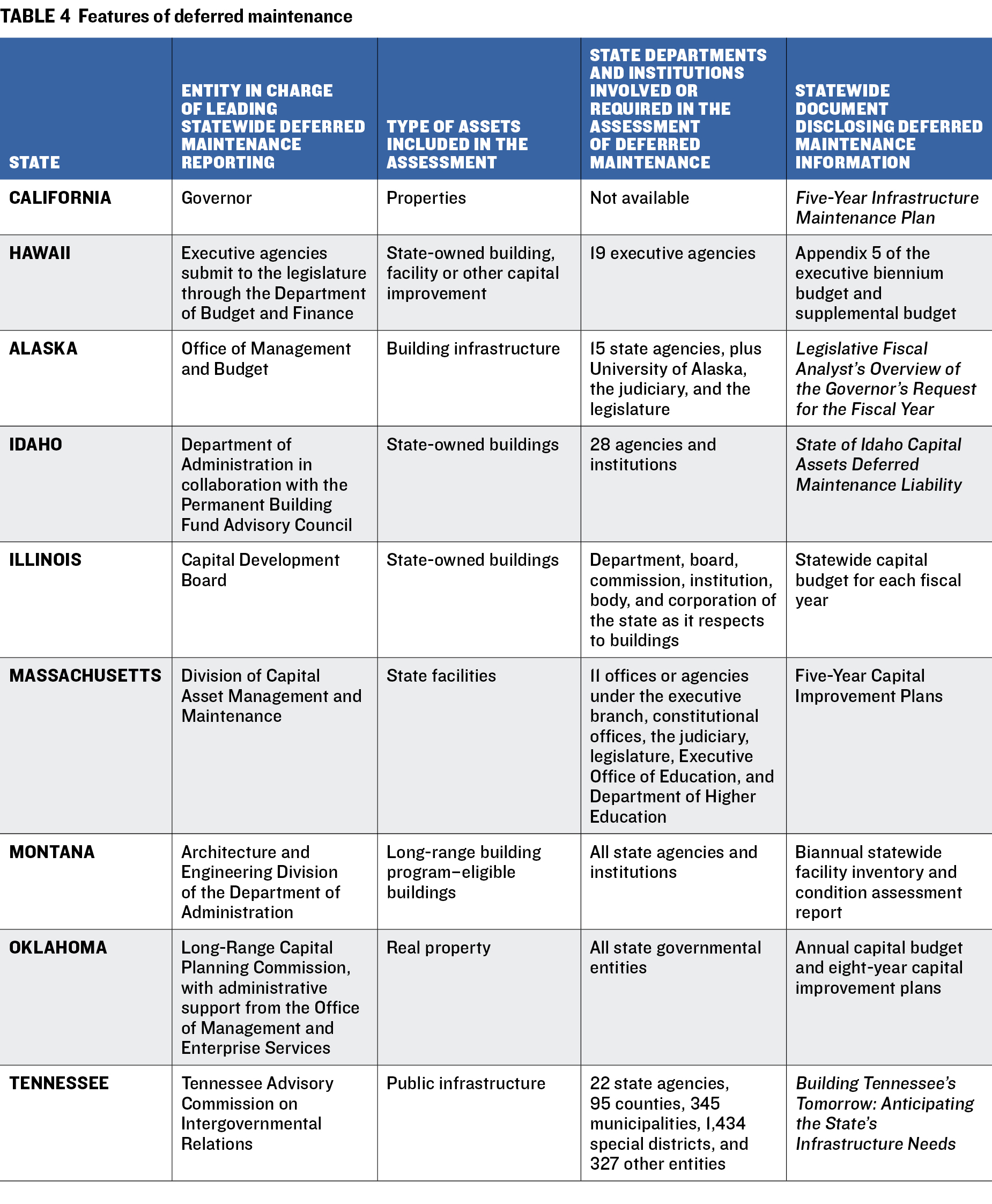
California
Though the state’s infrastructure plan began referring to deferred maintenance needs of the University of California (UC) system in 2008, it did not emphasize the statewide maintenance backlog until 2014. The infrastructure plan that year recognized the failure of previous ones to discuss the costs of upkeep for capital investments and of deferred maintenance. It aimed to correct those shortcomings and make the plan more relevant.20 Addressing the backlog of deferred maintenance was crucial to keep assets functioning longer and to reduce the need for expensive new infrastructure.
The Legislative Analyst’s Office (LAO) viewed the governor’s initiative to address deferred maintenance as an important need but highlighted several issues that required legislative deliberation.21 In particular, the proposal lacked critical details about the projects, did not provide a clear methodology for establishing funding levels, and failed to address the underlying causes of the backlog. The office also found the process to identify deferred maintenance projects to be inadequate.
To address these concerns, the LAO issued a list of recommendations in 2016 concerning additional reporting required for deferred maintenance projects. These requirements include requiring each department to provide a list of proposed projects to be funded. The departments would also be obliged to detail in budget the causes of maintenance backlogs and their plan to address them. The LAO further recommended adjusting departmental funding levels based on legislative reviews of project lists, and requiring the projects approved by the legislature to be listed in the Supplemental Report.
The LAO gave the legislature additional recommendations in 2019, including requirements that departments receiving funding report at budget hearings their approaches to prioritize deferred maintenance projects, as well as specific projects they plan to undertake; that the Department of Finance report on which projects departments undertook with the funds provided (no later than Jan. 1, 2023); and that departments experiencing growth in deferred maintenance backlogs identify the reasons and the specific steps they intend to take to improve ongoing maintenance practices.22
Infrastructure considered in the assessment includes property, “including land and improvements to the land, structures and equipment integral to the operation of structures, easements, rights-of-way and other forms of interest in property, roadways, and water conveyances” (2009 Government Code § 13100–104).
Individual state agencies have their own approaches to identify deferred maintenance projects, prioritize them, and select them for the proposed funding.23 As such, the assessment and the methodologies used vary. For instance, UC uses its Integrated Capital Asset Management Program to identify, prioritize, and track deferred maintenance projects.24 Staff members physically inspect facilities to identify deferred maintenance and capital renewal and replacement projects. Infrastructure components inspected include roofs, building exteriors, elevators, heating and ventilation equipment and distribution systems, electrical and fire protection equipment, interior finishes, vertical and horizontal elements, site development, and utility systems. UC deferred maintenance projects cost more than $5,000; smaller projects are funded with regular maintenance funds.
Hawaii
The Department of Budget and Finance (DB&F) shares with other state agencies a memorandum containing policies and guidelines to prepare the Executive Budget Request for the biennium. This document also contains additional requirements for completing and submitting a deferred maintenance costs form with a cover letter. In reporting deferred maintenance costs, departments must provide information, including the organization code of the program that would be responsible for the cost, the location of the deferred maintenance (island), type of asset (building, facility, or improvement), description of the deferred maintenance, estimated amount, and any additional comments.25 The DB&F compiles information from state departments and prepares budget documents, including an appendix with estimated deferred maintenance cost information.
Infrastructure considered in the assessment includes assets such as a “state-owned building, facility, or other improvement” “owned by a state executive agency; provided that a building, facility, or other improvement shall not be deemed ‘owned’ by a state executive agency if leased by the agency to a person” (Senate Bill 719). In the 2023–25 biennium budget, all executive departments,26 including the University of Hawaii (UH), and the offices of the governor and lieutenant governor reported deferred maintenance information.
Hawaii Department of Education and the University of Hawaii
Alaska
The state started to centralize its deferred maintenance approach in 2015.30 At that time, most agencies managed the preventive and deferred maintenance of their facilities. This made the process of identifying the costs of deferred maintenance in Alaska very difficult. With the use of multiple and redundant systems, each with their own interfaces and capabilities, the Division of Facility Services (DFS)—part of the Department of Transportation and Public Facilities (DOT&PF)—recognized the need for a centralized system to provide a consistent framework for assessing and prioritizing deferred maintenance needs. The administration formed the Facilities Council in 2016 and in 2017 designated the DOT&PF the lead agency to consolidate statewide maintenance functions.31
Setting a statewide deferred maintenance system involved several steps:32 inspecting facilities to develop a facility condition index (FCI) with the aim to provide a holistic view of state building assets, setting a baseline condition of the assets, and analyzing deferred maintenance needs; developing a deferred maintenance framework to provide procedures and metrics to measure progress; and implementing a computerized maintenance management system (CMMS) to provide long-term management, tracking, and reporting capabilities for all state-owned real estate.33 Implementation of the system began in early 2019 and all departments with facilities or leasing components are advised to use the system to assist with streamlining and automating processes.
The Alaska OMB currently facilitates the collection of all deferred maintenance needs across all state agencies. Once these are compiled into a list, it is sent to the Facilities Council, which reviews and prioritizes deferred maintenance projects in executive branch agencies (see prioritization process description in 3.4 ). Members of the council conduct several workshops in February and May to discuss all projects on the list. Once the review and prioritization processes are completed, the council approves a statewide prioritized list of deferred maintenance projects and provides it to the OMB in June.34 The office uses the list to inform recommended allocations for deferred maintenance needs.
The governor submits to the legislature an annual capital budget, which includes deferred maintenance appropriations. The Finance committees in both chambers review, vote on, and approve capital project submissions.35 Projects included in the budget are often large or of critical need. But deferred maintenance capital projects are occasionally funded through the operating budget, and Capital Improvement Project receipts are used to reflect those expenditures.
Infrastructure considered in the assessment includes buildings, including storage facilities.36 Deferred maintenance documents refer to state-owned facilities, which generally means properties and buildings owned, managed, or controlled by the state, including public buildings, transportation infrastructure, and other facilities used for state operations.37
Agencies involved in the deferred maintenance assessment, in addition to the University of Alaska, include the judiciary and the legislature. In all, fifteen state agencies may receive deferred maintenance funding and are required to report on the progress of their respective projects.38
Idaho
The Department of Administration’s Division of Public Works (DPW) initially used capital budget information to assess deferred maintenance needs but realized that the reported information underestimated the state’s accumulated deferred maintenance.39 In particular, state agencies and institutions submit a section for alteration and repair projects as part of their annual capital budget request to the Permanent Building Fund Advisory Council (PBFAC). The section includes projects that are typically related to an agency’s deferred maintenance deficiencies. Agencies generally submit a few top-priority projects as the PBF has limited resources and cannot cover all requests.
Concerned with potential inaccuracies, the Department of Administration (DOA) implemented a vendor-sourced facility condition assessment system (FCAS) for deferred maintenance needs.40 According to PBFAC, having a single vendor handing the FCAS for all agencies ensures a consistent and comparable approach. The FCAS contributes to maintaining a comprehensive inventory of state capital assets (storing asset information such as location, size, acquisition date, replacement value, and the costs of maintenance deficiencies) and their deferred maintenance costs.
Executing the FCAS required contracting with Gordian to implement the assessments. This included on-site inspections to determine and document the condition of a facility and identify repair, rehabilitation, and replacement needs and costs; populating the FCA software;41 and calculating the facility condition index.42 The firm began working in July 2021 with FCAs at the Capitol Mall and Chinden Campus; it later started working with state agencies and institutions to perform the statewide FCA in June 2022 and was expected to assess about 30 million square feet across the state.
By May 2024, the firm had completed about 90 percent of the statewide assessment and was expected to have a complete assessment by December 2024.43 The data gathered during the assessment is organized in the software and is provided to each agency and institution as their portion of the assessment is completed. State agencies and institutions can use it to identify deferred maintenance and plan for maintenance replacements. Once the firm completes the assessment, each agency and institution will be responsible for updating their information and adding new facilities to the database.
Infrastructure considered in the assessment includes the so-called vertical portfolio of the state administered by the Division of Public Works, mostly office buildings.44 This includes building interior structures and systems as well as exterior features such as roofs, walls, and windows. For campus-type facilities such as a university, the division administers infrastructure including roads and water and sewer systems.
Idaho’s 2021 preliminary report on deferred maintenance includes estimates from twenty-eight of the state’s sixty agencies and institutions.45, 46 Idaho Statute 67-5711 exempts the DOA from the review of public buildings, except for administrative office buildings and associated improvements, under the jurisdiction and control of the Board of Regents of the University of Idaho, Idaho Transportation Department, Department of Fish and Game, Department of Parks and Recreation, Department of Lands, and Department of Water Resources and Water Resource Board.
Illinois
The state Capital Development Board (CDB)47 reports deferred maintenance needs for state facilities. The CDB is the state’s vertical construction management agency and is responsible for overseeing the design, construction, renovation, and rehabilitation of state-owned buildings48 (20 ILCS 3105/). The CDB engages architects and engineers to perform high-level facility condition assessments for selected state-owned facilities and to identify state facilities as priority assets.49 The assessment includes inventory, visual inspections, quality assurance, and reporting; it involves teams that inspect facilities identified as priorities to evaluate the remaining life cycle of major asset systems, identify deferred maintenance requirements, and document deferred maintenance deficiencies. The inspection should include the architectural, mechanical, electrical systems, and other specific site systems provided by the CDB. The architects and engineers provide assessment data in an Excel file, with each building component assigned a condition, installation date, quantity, and replacement cost. In addition to condition assessments, architects and engineers provide inspection categories and a rating system to interpret assessment data. These data are used for calculating the building condition index, system condition index, and facility condition index ratings.
The CDB annually submits the list of projects to be included in the statewide capital budget. This budget includes deferred maintenance as one of the five major initiatives to address. The Office of Management and Budget (OMB) works with state agencies—including the CDB—to review potential capital investments and projects. Other agencies with large capital programs include the Department of Transportation, Environmental Protection Agency, Department of Commerce and Economic Opportunity, and Department of Natural Resources. In developing the capital budget proposal, OMB considers the impact of deferred maintenance and whether investments would prevent the need for more expensive repairs in the future.51 Other considerations include whether the investments support the government’s strategic priorities, meet program needs, save future operating costs, and maximize use of available funds from federal, local, or private sources as well as bond offerings.
The governor annually submits the capital budget to the House and Appropriations Committees and the Commission on Government Forecasting and Accountability.
Infrastructure considered in the assessment for the CDB include office buildings, health care facilities, secured facilities, state fairgrounds, laboratories, correctional centers, residential care facilities, garages, state parks, and historic buildings.52
Every state agency in Illinois that proposes to adopt new building or construction requirements, or amendments to existing requirements, reports that proposal to the CDB (20 ILCS 3105/3 & 19b). For this purpose, state agencies include each department, board, commission, institution, body, and corporation. This does not include the Illinois Department of Transportation,53 Department of Natural Resources, or Environmental Protection Agency, except in regard to buildings used by the department or agency for its officers, employees, and equipment, and for capital improvements related to those buildings. Similarly, state agencies do not include the Illinois Housing Development Authority or Illinois Finance Authority.
Massachusetts
The Deferred Maintenance Program of the Division of Capital Asset Management and Maintenance (DCAMM) is dedicated to preserving capital assets of state facilities.54, 55 The program, also known as critical repairs, was initiated about fifteen years ago and has undergone three significant changes to enhance reporting processes and efficiency in the use of resources.56 Initially, state agencies submitted annual deferred maintenance funding requests to DCAMM, which evaluated and prioritized the requests for submission to the governor and legislation for approval.
Due to limited funding—and to reduce wish list items—DCAMM revised the process. This change included state agencies’ submitting projects to their respective oversight body.57 These entities reviewed the requests and identified priority projects for consideration in the fiscal year. The overseers list of projects was then evaluated and prioritized by DCAMM and submitted to the governor and legislature for approval.
In 2019, DCAMM initiated a pilot program with the Executive Office of Education, the Department of Higher Education, and University of Massachusetts (UMass) Office of the President, to develop an effective process for making capital investment decisions for colleges and universities. This project aimed to address one of the common complaints to DCAMM from state agencies: not knowing the amount of funding they would receive over time.58 Currently, the state places a high priority on critical repairs and critical infrastructure. As of 2025, DCAMM has committed to provide a determined amount of funding every year under the critical repairs program for departments of corrections, sheriff’s offices, police, trial courts, health and human services, and the military.59 In addition, in terms of higher education, the capital plan prioritizes critical repairs and infrastructure and provides additional funding so that leaders can focus resources on programmatic priorities without compromising infrastructure needs.60, 61
State agencies submit deferred maintenance funding requests to DCAMM each May62 through the Capital Asset Management Information System (CAMIS) database.63 These submissions are supported with documents and other information rationalizing requests.64 These include cost quotes, work orders, preventative maintenance records, and code violation documents, incident and accident reports, and photographs. Additionally, state agencies must provide details about the project, such as life safety risks, shutdown threats, further damage, potential penalties, resiliency, accessibility, age of the equipment, expected remaining life and repair costs in the last five years. This input increases the likelihood a project will get funding.
All deferred maintenance requests are compiled and submitted to the governor every year for approval and to be included in the five-year Capital Investment Plan.65 This plan is presented to the legislature to vote on bond bills to fund capital projects and programs, including the deferred maintenance program. These bills are reviewed by the Joint Committee on Bonding, Capital Expenditures, and State Assets and the respective Ways and Means committees before enactment by the House and Senate.
After funding is approved, state agencies are required to complete a certifiable study for each deferred maintenance project with an estimated construction cost (ECC) of $300,000 or higher.66 This study should follow DCAMM’s deferred maintenance study template67 and include an investigation of existing conditions, a summary of codes and regulations, options and proposed solutions, a cost estimate summary, proposed schedule, and appendices. The study must be performed by a so-called House Doctor and submitted to DCAMM for certification before an agency can receive funds for design and construction to proceed. House Doctors are licensed architects or engineers who can investigate a problem, identify options, offer solutions, and provide design services through the Designer Selection Board. A House Doctor can be a nondesign consultant with appropriate expertise or a qualified staff at the requesting agency.
Deferred maintenance projects with an ECC below $300,000 do not need a study. This threshold applies for all projects, regardless of the funding source, and even if the project has an emergency waiver. The certification of the study includes reviewing it for completeness and conformity with long-range capital plans, determining that sufficient funds are available for design and construction, and recommending it to the DCAMM commissioner for certification.
Additional requirements exist when the requesting agency manages a project.68 Deferred maintenance projects may be funded and managed in one of three ways:
DCAMM funds the project and transfers the money to the requesting agency, while the agency contracts for the study (if needed), solicits contractor bids, and manages the project.
The requesting agency funds the project, contracts for the study (if needed), solicits contractor bids, and manages the project.
DCAMM funds the project and contracts for the study (if needed), solicits contractor bids, and manages the project for the requesting agency.
For the first two approaches, the requesting agency must be granted delegation authority from DCAMM’s commissioner if the project has an ECC of $250,000 or greater. Additionally, for projects with an ECC of over $5 million ($10 million for UMass) and involving structural or mechanical work, DCAMM is responsible for the control and supervision of design and construction projects.
Once deferred maintenance projects are approved for funding, requesting agencies are required to submit a cash projection for the project on CAMIS and update it quarterly.69
Over time, making documentation available and providing proper training for state agencies has been key to the success of the deferred maintenance program.70 DCAMM makes instructional material, study templates, and webinars available through its website and ensures that these are regularly updated with the latest system changes. These resources are available for state agency staff to:
Guide submissions of deferred maintenance funding requests through CAMIS;
Enhance understanding of the prioritization process; and
Emphasize the importance of submitting complete information to ensure a comprehensive and efficient prioritization process.
These materials also outline the requirements necessary for funding disbursement.
Assets considered for the deferred maintenance program include state facilities. The term capital facility is defined in the General Laws (Part I, Title II, Chapter 7C § 1) as “a public improvement such as a building or other structure; a utility, fire protection, and other major system and facility; a power plant facility and appurtenances; a heating, ventilating, air conditioning or other system; initial equipment and furnishings for a new building or building added to or remodeled for some other use; a public parking facility; an airport or port facility; a recreational improvement such as a facility or development in a park or other recreational facility; or any other facility which, by statute or under standards as they may be prescribed from time to time by the commissioner of capital asset management and maintenance.”
The definition also provides that highway, transportation, and information technology improvements are not considered capital facilities. The deferred maintenance program addresses the capital repair needs of these facilities, including boiler repair or replacement; heating, ventilation, and air conditioning repairs or replacement; plumbing repair or replacement; exterior envelope repair (roofing, windows); interior repairs; fire alarm and security systems; electrical systems, elevator repairs or replacement; and accessibility improvements.71
DCAMM is responsible for facility planning, project delivery, property management, and real estate services for executive branch agencies, constitutional offices, the judiciary, and the state house.72 Entities under DCAMM authority include the Office of Administration and Finance, Executive Office of Public Safety and Security (EOPSS), Executive Office of Health and Human Services (EOHHS), Executive Office of Energy and Environmental Affairs, Executive Office of Labor and Workforce Development, Secretary of State, Executive of Veterans Services, and Executive Office of the Trial Court (EOTC). DCAMM also collaborates with the Executive Office of Education, the Department of Higher Education and UMass, under a strategic framework for long-term capital investment decisions, including critical repairs.73
In addition to overseeing the Deferred Maintenance Program, DCAMM has occasionally performed a facility condition assessment (FCA) of state-owned buildings, facilities, and sites.74 In June 2019, DCAMM issued a request for proposal to conduct an FCA at a variety of state-owned buildings, including higher education facilities, general-purpose administrative and recreational facilities, hospitals, clinics, laboratories, and residential health care facilities under the EOHHS; public safety and correctional facilities under the EOPPS; and courthouses under the EOTC.75 By December 2022, the FCA was in progress for 259 state-owned buildings and grounds occupied by nine state universities and fifteen community colleges.76 These assessments would be made available to agencies for strategic planning and investment, thus reducing the deferred maintenance backlog. As of January 2025, DCAMM had not conducted FCAs for all facilities in the state.
Montana
The Architecture and Engineering (A&E) Division is responsible for the facility inventory, oversees facility condition assessment (FCA), and manages the long-range building program (LRBP) major repair account.
To develop a statewide facility inventory following adoption of Senate Bill 43 in 2017, A&E used preexisting data from the Risk Management and Tort Defense (RMTD) Division of the Department of Administration.77 RMTD maintained the only central listing of state-owned facilities for insurance purposes. State agencies self-report facility details including the area, construction type, and location and update the information annually to ensure proper insurance coverage. Since 2017, A&E has maintained the facility inventory and receives the list of buildings from the RMTD database each year.
The current facility inventory is being adjusted to include a complete list of facilities and their information.78 The statewide facility inventory contains all state-owned facilities from the RMTD database, including state-owned buildings with a current replacement value (CRV) of $150,000 or less. Uninsured facilities are absent from the inventory. In addition, A&E is working with state agencies to record buildings that are not listed in the inventory. Location data for some buildings are inaccurate or incomplete, especially multibuilding campuses or remote locations managed by the Fish, Wildlife, and Parks or Transportation departments. A&E plans to geolocate all buildings over time using latitude and longitude coordinates.
Other information needing adjustment includes buildings’ CRV and eligibility for the long-range building program (LRBP).79 Currently, buildings’ assigned CRV may be different from their actual value. As state agencies do not assign a current replacement value to their buildings, Risk Management and Tort Defense determines an insured valuation. For buildings valued at less than $1 million, RMTD generates an insured current replacement value on a cost-per-square-foot basis. For buildings valued over $1 million, RMTD generates the insured CRV through an appraisal conducted about every five years.
The actual total project replacement cost is typically higher than the insurance-appraised CRV. In addition, the RMTD uses a factor (provided by their underwriters) to adjust each building’s CRV every year. Similarly, the LRBP-eligibility determination is made via a manual process whereby state agencies determine which of their buildings are LRBP-eligible according to the definition in Montana Code Ann. § 17-7-201.
LRBP-eligible buildings with a CRV over $150,000 require a periodic FCA.80 The assessment helps identify building deficiencies and provides a facility condition index (FCI), the deficiency ratio the state uses. The FCI is a calculation that compares the costs of deferred maintenance to a building’s replacement value and is defined as follows:
FCI = (Renewal needs and deferred maintenance/Current replacement value) x 100
FCI values under 5 percent are considered “good,” 5–10 percent “fair,” 10-30 percent “poor,” and over 30 percent “critical.”
A&E aims to assess each facility once every four years (A&E Division, 2024, Montana Code Ann. § 17-7-202). The industry standard is to conduct building assessments every three to five years, and A&E decided on a year in the middle, as it aligns with two rounds of the budget cycle and provides ample time for decision-making between assessments. A&E also acknowledges that achieving this goal is a challenge because of the size of the inventory and the limited number of assessors. In August 2024, 562 of the 1,050 LRPB-eligible buildings required an FCA.
While A&E initially conducts baseline facility assessments for all state agencies, the agencies are responsible afterward for maintaining accurate facility data and incorporating data into daily operations.81 Given that some agencies may lack the staff expertise and time to conduct facility evaluations, the division requested $1.5 million for the LRBP project to conduct baseline assessments for all of them. An architecture firm will perform those, ensuring consistency and a lack of bias. The assessments were scheduled to be completed by the fall of 2025.82
A&E also plans to conduct training to ensure consistency in future assessments.83 State agencies with qualified staff will probably manage their own assessments, while agencies without such resources will have a consultant or an A&E staff member assigned to conduct them. This will ensure that all state-owned facilities are accurately evaluated and documented within the system.
A&E uses Archibus,84 a commercially available property and inventory management system. The goal is to use the tool for data collection, analysis, and management across all state agencies and help reduce long-term maintenance costs.
In its assessments, Montana defines “buildings” as facilities or structures constructed or purchased wholly or in part with state money, located at a state institution, or owned (or to be purchased) by a state agency, including the Department of Transportation (Montana Code Ann. § 17-7-201-1). The term does not include buildings, facilities, or structures owned by a county, city, town, school district, or special improvement district, or a facility or structure used as a component part of a highway or water conservation project.
An LRBP-eligible building is defined in Montana Code Ann. § 17-7-201-6 as a, facility, or structure eligible for major repair account funding that:
Is owned or fully operated by a state agency and whose operation and maintenance are funded with resources from the state general fund; or
Supports academic missions of the Montana University System (MUS) and whose operation and maintenance are funded with current unrestricted university funds.
The term excludes buildings, facilities, or structures owned or operated by a state agency and whose operation and maintenance are entirely funded with state special revenue, federal special revenue, or proprietary funds, or that support nonacademic functions of the university system and whose operation and maintenance are funded by nonstate and nontuition sources.
All state departments, agencies, and institutions, including the university system, are involved in the deferred maintenance assessment.85
State agencies fund major repair and capital development projects through the LRBP.86 Deferred maintenance projects are part of this program. State agencies submit their request by July 1 of the year preceding a legislative session using the LRBP submission portal. After that, A&E works with the Office of Budget and Program Planning (OBPP) to review and evaluate project requests for feasibility, agency needs, and changes in operating costs. These requests are compiled in a single list of prioritized statewide projects and submitted for review to the governor, who submits the requests in a comprehensive long-range proposed building program as part of the executive budget. A&E is also required to provide a facility inventory, condition assessment, and calculation of the deferred maintenance backlog to the OBPP and the Legislative Finance Committee to inform decision-making.
Oklahoma
As part of Senate Bill 1052, the Division of Capital Assets Management (DCAM) issued a capital planning and asset management report in 2012 recommending a course of action for the streamlining, integration, and consolidation of state construction, maintenance, and management.87 One of the recommendations was that each agency develop a three-component budget comprising operations and maintenance, capital improvement (including deferred maintenance), and capital development. The capital improvement component covers major deferred maintenance, equipment replacement, and restoration or minor renovation costing between $50,000 and $2.5 million. In addition, such components should be developed using data collected during assessment, life-cycle analysis, and master planning. The initial recommendation was for capital investment planning to have a five-year time span, but an eight-year period was selected.
Another recommendation was to standardize the planning methodology into several phases.88 Following are aspects of the first four phases relevant to assessing and budgeting for deferred maintenance needs:
Phase 1—ORGANIZE: Gather information required by House Bill 2392,89 including a comprehensive inventory of capital facilities; estimates of mandatory, essential, desirable, and deferrable repair, replacement, and expansions; and recommendations on the maintenance of physical properties and equipment of state agencies. The Office of Management and Enterprise Services (OMES) is required by the Oklahoma State Government Asset Reduction and Cost Savings Program (Okla. Stat. § 62-908) to publish an annual report containing an inventory of all state-owned property. This inventory includes buildings and other structures, as well as land and mineral assets. In addition, OMES is required to list the five percent most underused state-owned properties. Findings from the State Government Asset Reduction and Cost Savings Program must be included in capital planning according to the State Capital Improvement Planning Act (Okla, Stat. § 62-901).
Phase 2—ASSESS: Create a baseline for the facility condition index (FCI), analyze and synthesize data, establish reporting methodologies, and determining the FCI and fit for use conditions. The outcome of this phase is the creation of a facility condition assessment and life-cycle cost analysis (LCCA) for each state building.
Phase 3—DEVELOP THE PLAN: The plan Includes ranking projects according to the scoring metrics (described in the Prioritization of Deferred Maintenance section of this report).
Phase 4—IMPLEMENT: Develop pilot Capital Facility Plans for selected small, medium, and large state agencies and submission of capital improvement and capital development projects to the Long-Range Capital Planning Commission (LRCPC).90
State agencies submit their requests for LRCPC consideration through Oklahoma’s online budget system between April and July each year.91 The commission reviews and submits the final draft of the requests to the legislature in December, which reviews the project list and votes on it within 45 days of submission.
The state defines “real property” as “land, and generally whatever is erected, growing upon or affixed to land; also, rights issuing out of, annexed to, and exercising in or about land.”92
According to the State Capital Improvement Planning Act, all state governmental entities as defined in Okla. Stat. § 62-695.3 are required to participate in the capital improvements plan process.
In addition to these efforts, the legislature in 2024 passed the Oklahoma Capital Assets Maintenance and Protection Act (Okla. Stat. § 77-188). This act mandated the creation of the Oklahoma Capital Assets Maintenance Protection (OCAMP) Board, which is tasked with developing a five-year plan for maintaining and repairing all state-owned properties and buildings. The act also provides for OMES, with the advice and assistance of the Oklahoma Capitol Improvement Authority, to provide staffing for the board and other assistance required.
In the capital budget for fiscal 2026, the LRCPC recommends that the legislature evaluate the scope of the OCAMP Board alongside that of the LRCPC to avoid duplication of effort.93 The commission suggests that there is an opportunity to consolidate the mission, responsibilities, and revenue streams of these two entities. In addition, it recommends strong communication between the staff of the LRCPC and OCAMP Board to ensure that redundancies in project funding do not occur.
Tennessee
The creation of a public infrastructure needs inventory involves multiple sources of information.94 The Tennessee Advisory Committee on Intergovernmental Relations (TACIR) gathers infrastructure needs anticipated for the following twenty years from state and local sources annually. For state-level needs, TACIR receives state agencies’ capital budget requests from the Department of Finance and Administration. These are incorporated in the inventory database and sent back to the contact in each agency to verify data, update the status of other infrastructure needs projects already identified in the inventory, and provide additional infrastructure needs that are not already included. Some infrastructure needs will come directly from state agencies. For instance, bridge and road needs come from project listings provided by the Tennessee Department of Transportation and needed capital projects from the Tennessee Board of Regents. All this information is compiled directly by TACIR staff.
For local needs, the staff of each Tennessee development district surveys public officials within their jurisdictions, following TACIR’s directions. Local needs are gathered through two inventory forms covering school facility needs and general public infrastructure needs. The development districts’ staff contact representatives of municipalities, counties, utility districts, school districts, water districts, special districts, and other entities to request that they complete the surveys, update the status of other infrastructure needs projects already identified in the inventory, and identify anticipated needs for the next twenty years. Then, the development district staff enters information into the inventory database.
State and local officials are also asked to update information for each project and identify the stage of development of each project in each year including conceptual, planning and design, and construction.
TACIR has implemented standardized procedures to ensure data quality and report consistency. These procedures involve two phases: quality control (QC) and post-QC.95 In the QC step, tools that flag inconsistencies are built into software used for the inventory. These include comparing estimated costs over time and noting unusually large increases or decreases, calling out projects that are entered as completed but were never included in the inventory as a need, and identifying duplicated projects. In the post-QC phase, the reports may be by county, type of infrastructure, or stage of project.
While the inventory is broad, it may not fully capture all the state’s infrastructure needs. The 2022–27 inventory includes about 15,000 infrastructure projects from almost 100 percent of state agencies and localities.96,97 But an inventory is not required of state or local officials, who may decline to participate or provide only partial information.
Since the first inventory was taken in 1998, relationship-building and consistent communication with state and local stakeholders have been crucial for its development. Staff highlights the importance of having all stakeholders involved in the process and understanding the significance and usefulness of the information gathered for a comprehensive inventory.98 Further, participants become more supportive of the inventory as they grow familiar with the process.
The infrastructure needs inventory is accessible to all government agencies and has been useful for planning, informing decision-making, increasing awareness of infrastructure needs, and fostering communication and collaboration among agencies and decision-makers. As the inventory is not limited to needs that can be funded in the short term, it promotes long-range planning and matches critical needs to funding opportunities.
Tennessee considers public infrastructure for its infrastructure needs assessment. Public infrastructure is defined as capital facilities and land assets under public ownership or operated or maintained for public benefit.99 To be included in this inventory, infrastructure projects must involve a capital cost of at least $50,000 and must not be considered routine maintenance.
In addition to the infrastructure needs inventory, TACIR provides an infrastructure needs report. While the inventory covers infrastructure needs over twenty years, the report focuses on the first five years of that period. The report includes the estimated costs of any infrastructure needs in the five-year period, including those that began before it and those that will not be finished within it.100 The report is structured to organize public infrastructure needs in the following categories: transportation and utilities; education; health, safety, and welfare; recreation and culture; general government; and economic development.
The report has undergone several changes since it was first published in 1998. Initial reports put higher emphasis on education-related infrastructure needs, while most recent reports present needs on a broader range of assets. Recent reports include a summary of infrastructure needs by county, each with its own top three needs. Although not required by statute, reports also highlight the funding that has been identified to address infrastructure needs.
Estimation of Deferred Maintenance Needs
This section presents estimated shortfalls in deferred maintenance needs over time. Patterns vary as the analyzed states consider different types of infrastructure and are at different stages in their assessment (see figure 1).
In California and Hawaii, which consider a broad range of infrastructure types, deferred maintenance needs per capita are on average between $2,000 and $3,000 (in constant 2022 dollars). In both states, deferred maintenance needs per capita remained relatively unchanged from 2015-23, although Hawaii experience a spike between 2019-22. Across states that consider only building infrastructure, deferred maintenance needs per capita have higher variability, as some states are in the early stages of their assessment process and the definition of what constitutes infrastructure for the assessment may differ. For these states, deferred maintenance needs per capita range between $500 and $3,000 (constant 2022 dollars).
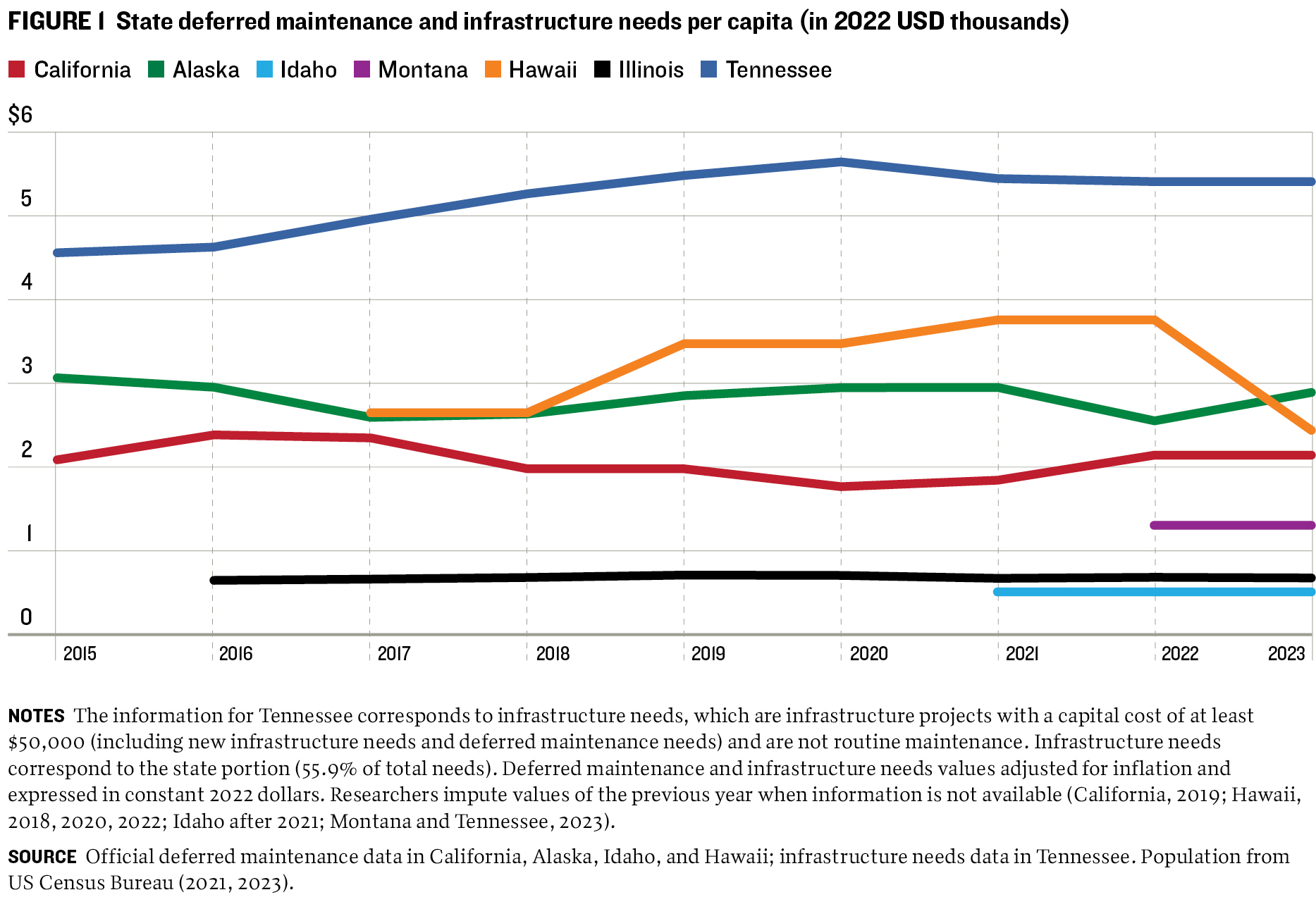
Figure 1 also shows five-year per capita state infrastructure needs in Tennessee, which are about $5,500 (constant 2022 dollars). This represents infrastructure improvements that should be in some stage of development in the five-year period. Tennessee experienced significant increases in these needs in 2017–18, with growth rates of 7.4 percent and 6.3 percent, respectively. Since then, needs have remained relatively stable.
The following section provides detailed information on the estimated deferred maintenance needs for each state selected as a case study and on infrastructure needs in Tennessee.
California
The total amount of deferred maintenance accumulated in California was estimated at $84.2 billion in 2022 (see figure 2)—estimated because the state does not have a comprehensive inventory of the condition of its infrastructure.101
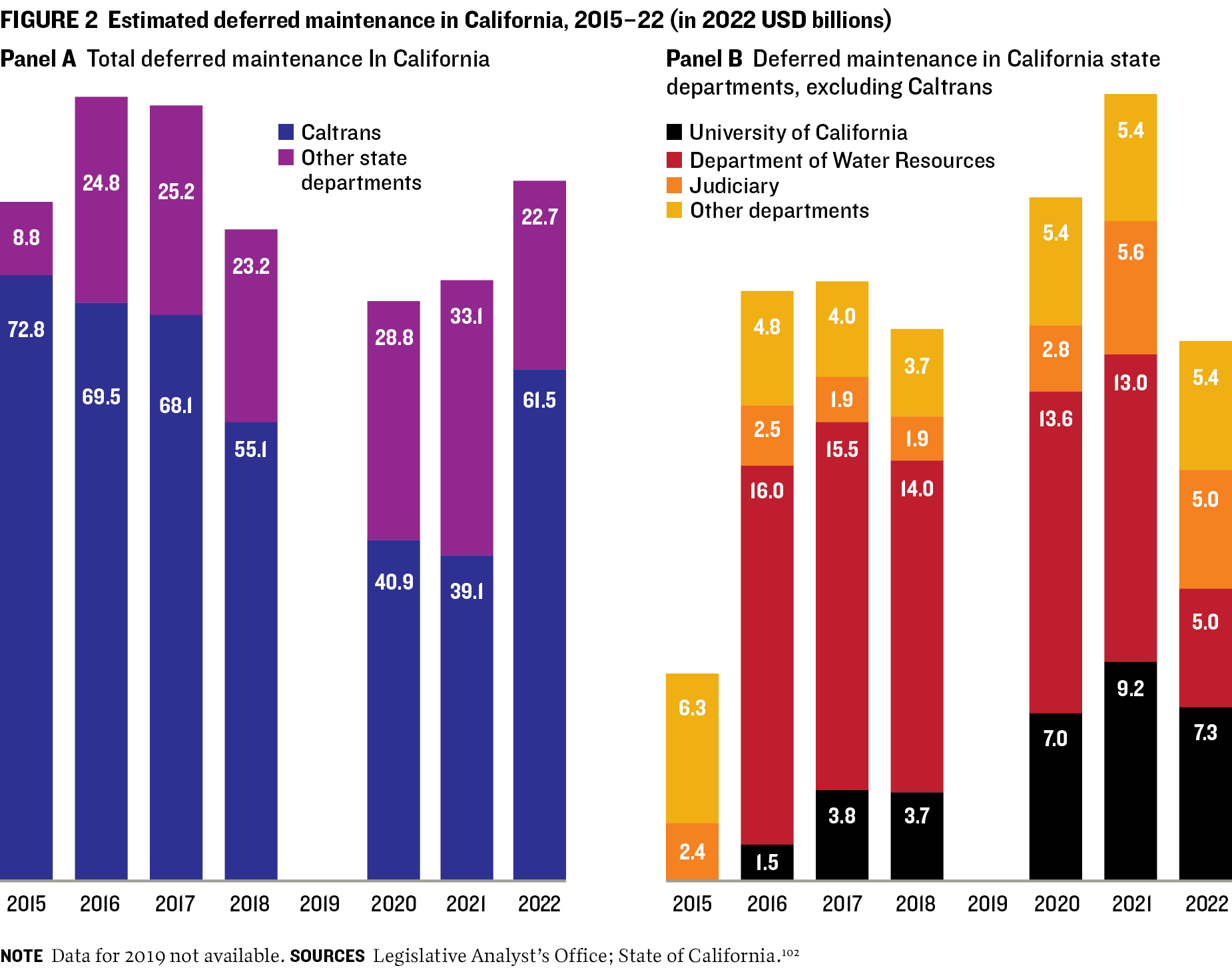
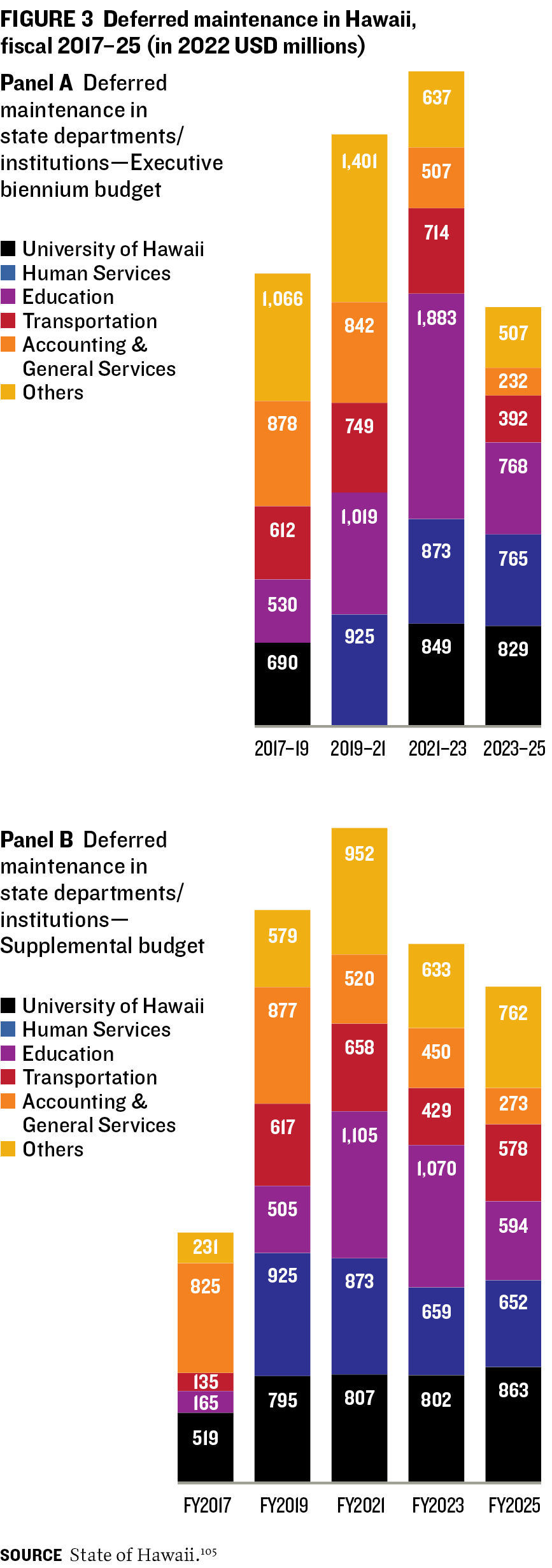 For 2015–22, the deferred maintenance at the Department of Transportation (Caltrans) accounted for an average of 70.3 percent of the total amount of deferred maintenance, while the Department of Water Resources stood at 13.5 percent and the University of California was at 6.0 percent).
For 2015–22, the deferred maintenance at the Department of Transportation (Caltrans) accounted for an average of 70.3 percent of the total amount of deferred maintenance, while the Department of Water Resources stood at 13.5 percent and the University of California was at 6.0 percent).
In 2015–20, total deferred maintenance (in constant 2022 dollars) decreased at an annual average rate of 3.2 percent, mostly because additional funding provided by the Road Maintenance and Rehabilitation Program103 allowed Caltrans to address its needs at an accelerated rate. Overall, it is estimated that the agency was able to reduce its deferred maintenance by 36 percent in fiscal 2017–21.104
Hawaii
Hawaii identifies in budget documents a deferred maintenance total of $3.5 billion in the 2023–25 biennium (figure 3). Between the 2017–19 and the 2023–25 bienniums, the education department’s deferred maintenance accounted for an average of 22.8 percent of the state’s total, followed by the University of Hawaii (19.2 percent) and the Department of Human Services (18.9 percent).
Alaska
The nation’s largest state by area accumulated $2.2 billion in 2023 (constant 2022 dollars; figure 4). In 2015–23, the deferred maintenance at the state university represented an average of 65.6 percent of the total, followed by the Department of Transportation and Public Facilities (18.3 percent) and Departments of Corrections and Natural Resources (around 3.3 percent each).
Total deferred maintenance in Alaska decreased at an average annual rate of 8.1 percent between 2015 and 2017 due to a gubernatorial initiative to appropriate a consistent amount of funding to address the backlog.
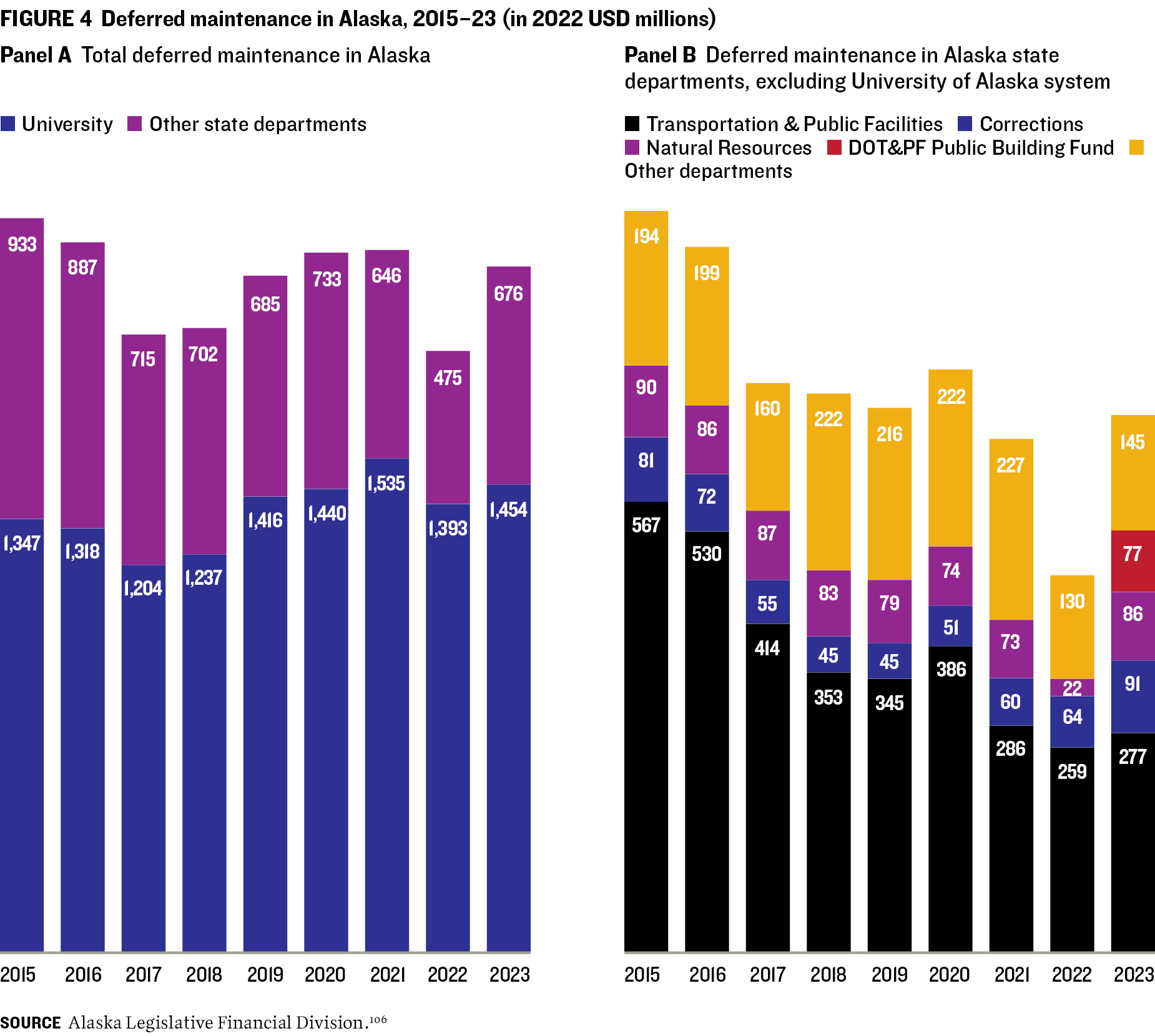
But the gap widened again by an annual average of 3.3 percent in 2018 because appropriations for deferred maintenance had declined starting in 2016.107 Although the number of projects did not increase significantly, costs did—significantly in some cases.108 Inflation, the location of some ventures in rural districts, and price hikes during the state’s severe winter weather spurred the rise in expenses.109
By department, the state university’s deferred maintenance remained relatively constant until 2018 and increased in 2020–21, during the COVID-19 pandemic. Funding for the University of Alaska’s backlog is not included in the governor’s budget. Instead, the system typically allocates a portion of its operating budget to deferred maintenance and the legislature often supplements that funding to address the backlog.110 But funding for deferred maintenance as unrestricted general fund operating support of the university decreased.111 In addition, capital appropriations for the university vary widely from year to year, which affects the deferred maintenance backlog. For instance, $30 million was appropriated for deferred maintenance in fiscal 2015, while appropriations in fiscal 2020 and 2021 were $5 million and $2 million, respectively.112
Idaho
The Department of Administration in 2021 identified $911.9 million in deferred maintenance (or about $984.9 million in constant 2022 dollars).113 According to the report, these are preliminary estimates and significantly underestimate the true backlog. The deferred maintenance backlog was self-reported by the agencies and institutions, and in some cases, their figures were based on facility condition assessments that were up to a decade old. Based on preliminary estimates, 71.7 percent of deferred maintenance needs are from the State Board of Education, followed by the Department of Correction (13.4 percent; figure 5).
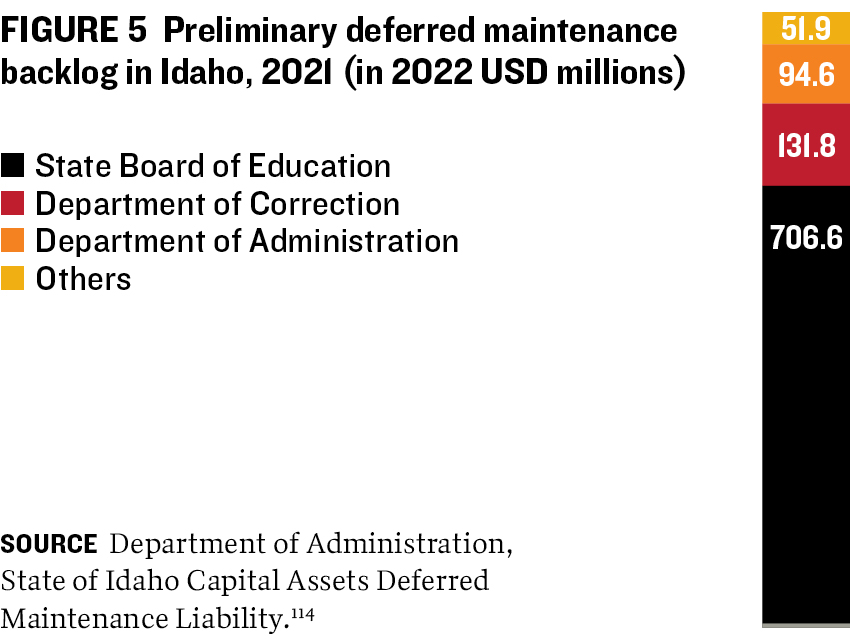
In May 2024, the state did not show an updated deferred maintenance backlog; officials were still conducting an assessment.115
Illinois
Estimated deferred maintenance needs of the Capital Development Board (CDB; for state facilities) totaled $8.9 billion (in constant 2022 dollars) in 2025. In fiscal 2017–25, deferred maintenance needs averaged $8.8 billion, with an average annual growth of about 2 percent (figure 6). Most of the deferred maintenance needs occur in facilities that house people 24 hours a day, seven days a week. The Department of Corrections (DOC) and the Department of Human Services (DHS) had the highest needs, at an average of 28 percent and 26 percent of the total, respectively, followed by Central Management Services, at an average of 14 percent.
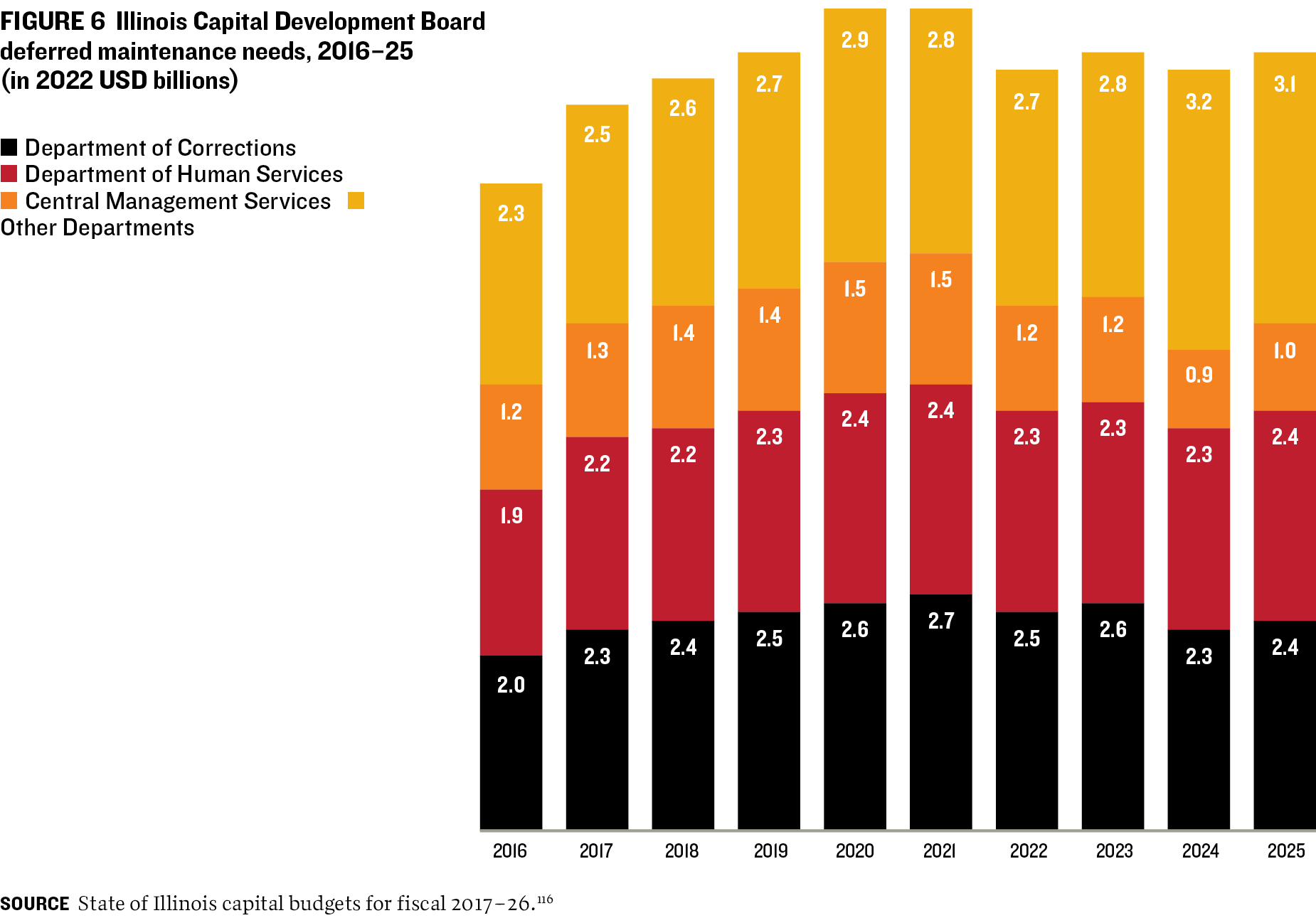
The CDB’s deferred maintenance needs increased in 2017–21, mostly driven by the rise in needs of the DOC and DHS. In particular, the corrections department’s deferred maintenance needs rose because of the number of facilities approaching or surpassing the age of 100.117 Most of these reached a point where routine maintenance practices were not sufficient to close long-term gaps.
Deferred maintenance needs began to decline in 2022 because of additional funding from Rebuild Illinois. The program had started in 2019, but decreases in the accrual of deferred maintenance began a few years later as projects released in the first years of Rebuild Illinois reached completion.118
The statewide capital budget also includes needs for other state institutions. For instance, the Illinois Board of Higher Education and the Illinois Community College Board provide annual estimates of their total needs, while the Illinois State Board of Education provides biennial figures (table 5). Similarly, the Rebuild Illinois Capital Plan reported that state road and transit systems had $30 billion in deferred maintenance needs in 2019.119

Massachusetts
The Division of Capital Asset Management and Maintenance (DCAMM) has not performed a condition assessment for all state facilities and therefore does not have its total deferred maintenance need. Based on the Capital Plan of the University of Massachusetts for fiscal 2024–28, the deferred maintenance for the UMass system reached $4.8 billion.121 But based on the facility condition assessment for the institutions of higher education, which represent 50 percent of the buildings in the state,122 these institutions have a total of $5.57 billion in deferred maintenance needs.123,124 More than half of those needs are for the UMass campuses ($3.03 billion); followed by community colleges ($1.32 billion); and state university campuses separate from UMass ($1.23 billion).
Montana
Once a full cycle of facility assessments is completed, the Architecture and Engineering Division can calculate the actual total deferred maintenance backlog for the entire long-range building program (LRBP)-eligible inventory.125 Meanwhile, assessment data from Montana State University (MSU) is used to calculate a per-square-foot backlog, which is later multiplied across the inventory of LRBP-eligible buildings.
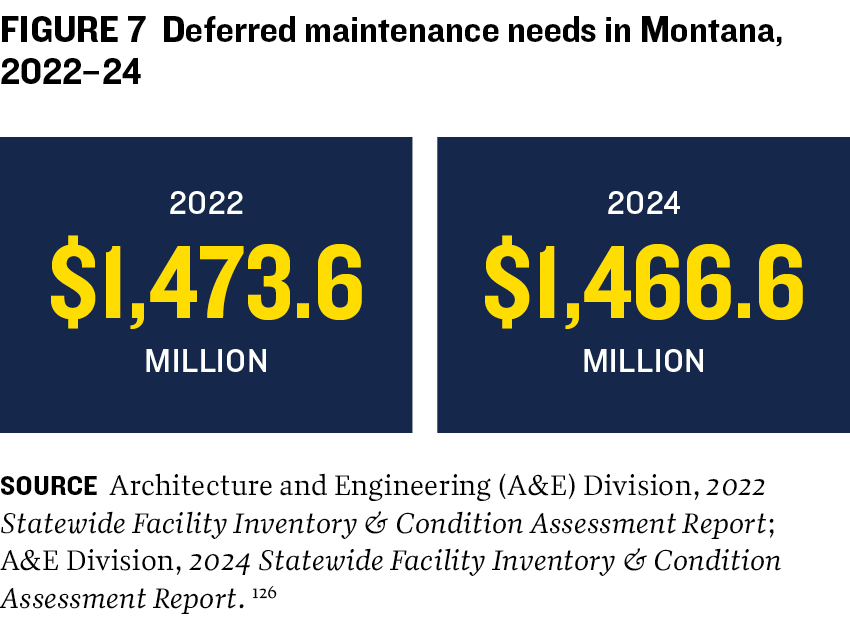
MSU has been conducting regular facility assessments; its data is known to be reliable and accurate. In 2024, estimated state deferred maintenance needs were $1.5 billion, according to MSU data (figure 7). Although LRBP-eligible buildings make up only 20.8 percent of the state’s total vertical inventory, they account for 50.9 percent of its total square footage and 61 percent of its total building infrastructure value.
Oklahoma
The only publicly available estimates for statewide deferred maintenance needs are for state colleges and universities. According to an interim study by the House Higher Education and Career Tech Committee in 2023, estimated needs for these institutions totaled $1.5 billion.127
Tennessee
Tennessee reported infrastructure needs of $68.3 billion for 2022–27 (figure 8). The figure includes deferred maintenance needs, but their value is not broken out. Statewide assets represent 55.9 percent of total infrastructure needs, counties 20.5 percent, cities 18.9 percent, and federal and jointly held 4.7 percent.128
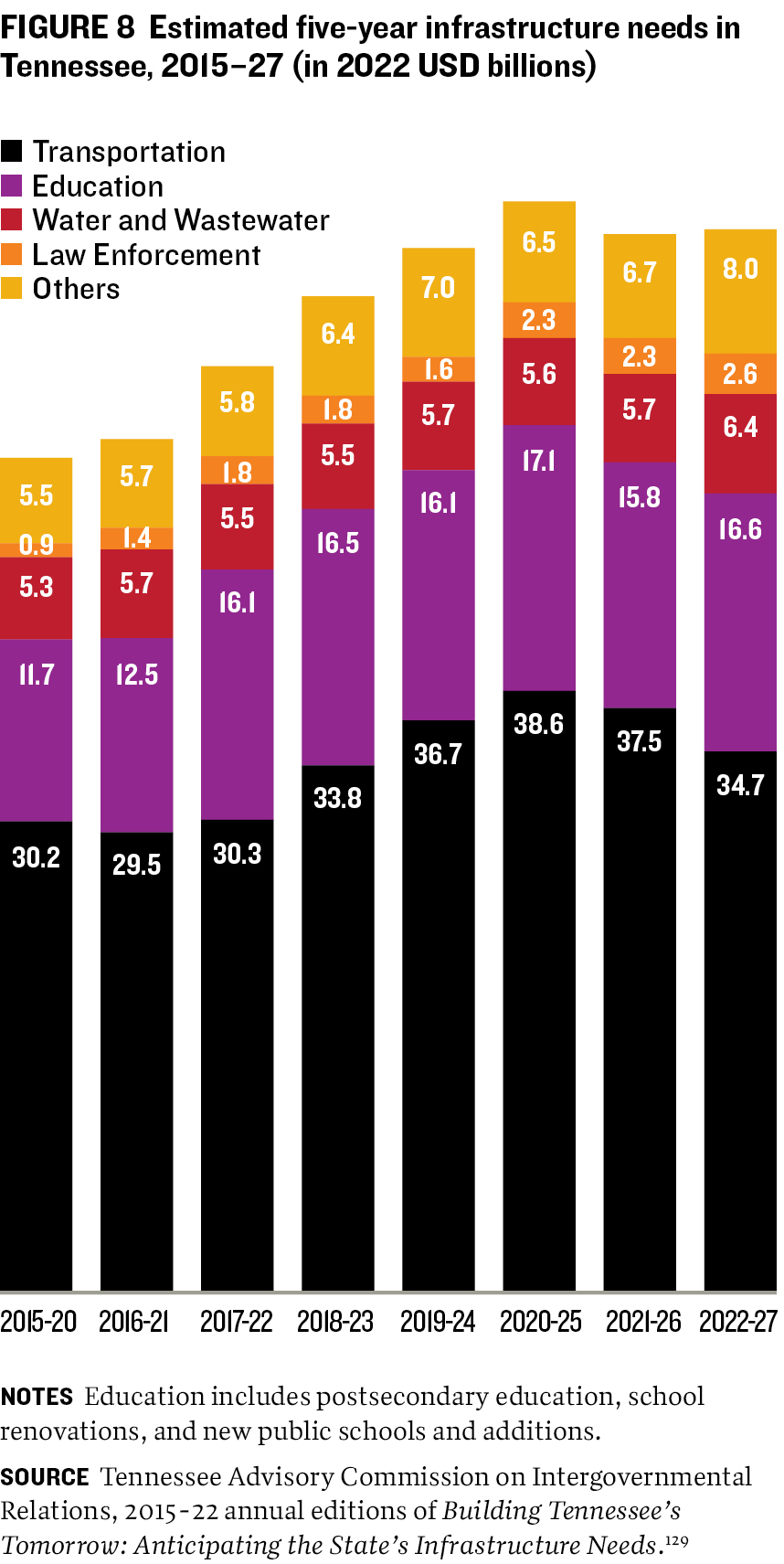
In the five-year survey periods starting with 2015-20 and ending with 2022-27, the Tennessee Department of Transportation accounted for an average of 53.7 percent of the state’s total infrastructure needs, followed by Education (which includes postsecondary education, school renovations, and new public schools and additions) at 24.2 percent, and water and wastewater at 9.0 percent.
Tennessee’s infrastructure needs rose at an annual average rate of 3.6 percent over the period covered by the 2015-22 surveys. Needs increased every year as state and local officials updated infrastructure needs information, including adjusting estimated costs as projects moved forward, and identifying new gaps. But these increases were offset by project completions or terminations, as they then no longer appeared in the inventory.
Prioritization of Deferred Maintenance Projects
Some states have designed and implemented a prioritization process for deferred maintenance needs. These processes vary in approach, methods, and metrics used in the analyzed states. In California and Hawaii, prioritization of deferred maintenance projects occurs primarily at the state agency level; Alaska, Idaho, Massachusetts, Montana and Oklahoma follow a two-step approach in which individual agencies submit priorities and the lead agency then ranks projects according to statewide goals following a centralized approach. States take varying approaches to setting priorities, including use of a facility condition index (FCI), subjectively assessing the urgency and critical nature of the need, or a combination of techniques.
The following paragraphs discuss the prioritization process for deferred maintenance projects used in each state. It is worth mentioning that the Tennessee Advisory Commission on Intergovernmental Relations maintains only the inventory of infrastructure needs used to inform decision-making; project prioritization is not the commission’s responsibility.
California
The budget approach for addressing deferred maintenance gives individual state agencies discretion over how and when to select specific projects.130 While some departments, such as the University of California, have identified a methodology for prioritizing projects, others have yet to identify the processes and criteria to use in their decision-making processes.
At the university system, which serves almost 300,000 students, deferred maintenance projects are prioritized, in the following order, according to the following criteria:131
CURRENTLY CRITICAL: Needs that significantly impact the mission of the institution and require immediate action. Special attention is given to needs that pose a significant risk to health and safety.
POTENTIALLY CRITICAL: Needs that will become critical within a year if not corrected.
NECESSARY, NOT YET CRITICAL: Needs that will become Currently Critical or Potentially Critical within the next ten years but do not at this time significantly impact the mission of the institution.
Hawaii
The Department of Budget and Finance does not have centralized prioritization criteria for deferred maintenance projects.132 Prioritization of deferred maintenance projects occurs primarily at the state agency level.
At the state Department of Education (DOE), prioritization of Capital Improvements Program (CIP) and deferred maintenance program projects follows Board Policy 301-10, Equitable Allocation of Facilities Resources.133 The DOE uses a scoring matrix to rank over 200 CIP and deferred maintenance projects and identify the highest-ranking ones for inclusion in the biennium budget. The ranking considers the following: health and safety, condition, compliance, building capacity, instructional impact, schools eligible for Title I funding, schools identified for comprehensive support and improvement, and shared use.
The University of Hawaii (UH) uses the facility condition index to determine the condition of a facility. The index is calculated using the following formula.134
FCI = Deferred Maintenance Backlog (DMB)/Current Replacement Value (CRV)
DMB refers to the deferred maintenance backlog inflated at 5 percent per year that the university expects over a ten-year period.135 CRV is the current cost to replace a building of similar size and usage, including construction and related costs excluding land or site improvements. Facilities with a higher FCI are given increased priority, and older buildings typically have higher FCIs. In 2019, the UH system had a FCI of 0.1 (meaning 10 percent of the university’s spaces were in need of repair), while the various campuses have index levels of 0–1.13.
Alaska
The Facilities Council manages the prioritization of deferred maintenance projects under the Office of Management and Budget. The council uses the project index value (PIV) formula for project prioritization.136
The higher the PIV, the greater the priority of the deferred maintenance project. The formula is composed of three main metrics that help the state define which deferred maintenance projects are of most important need. The first metric is the mission alignment index (MAI), whose scale runs from 0.0 to 0.9 and represents four categories:
CRITICAL (0.75–0.90): Agency cannot meet its mission without the facility. Examples include correctional centers, schools, and key maintenance stations.
IMPORTANT (0.50–0.74): Availability of the facility would impact the agency’s mission. Examples include certain building facilities to provide services.
SUPPORTIVE (0.25–0.49): Availability of the facility would possibly impact the agency’s mission, but other options are available.
NON-MISSION CRITICAL (0.00–0.24): Facility’s availability would not affect the agency’s mission. Examples include certain warehouses or storage facilities.
The MAI also considers the facility’s ability to deliver services, the number of people that it impacts, and the availability of other facility options at the location. Each agency determines its projects’ MAI and revisits them periodically.
The second metric is the system factor, which emphasizes a specific system’s impact on the building. This metric ranges from 0.25 to 1.0 and provides a numerical value for the type of asset in the facility. Table 6 provides categories associated with the system factor. 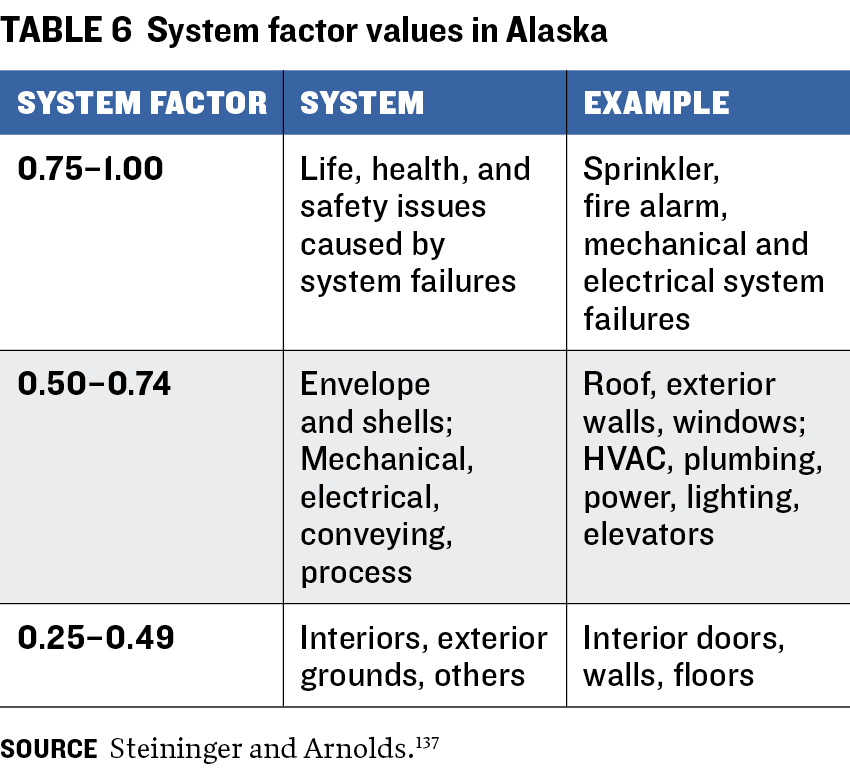
The third metric is need, scored from 5 to 3 according to the urgency of the repair.
CRITICAL (5): Corrects critical life safety or code hazard. Requires immediate action.
IMPORTANT, NOT YET CRITICAL (4): Corrects deterioration or potential safety hazards. Requires action within five years.
NECESSARY (3): Requires appropriate attention to prevent deterioration.
Members of the Facilities Council determine the second and third metrics using available information, including condition assessment, maintenance records, engineering reports, and evaluations by architectural and engineering professionals. Overall, this type of process allows the council to weigh agency and statewide priorities.
The council may consider other factors in prioritizing deferred maintenance projects, such as the anticipated return on investments and any matching funds. These variables have not been included in recent prioritizations amid turnover in council members and efforts to educate new ones on the main prioritization method.
Idaho
Idaho considers several inputs when deciding to maintain, repair, or replace an asset. Life-cycle costing and cost-benefit analysis play a key role in decision-making.138
Primarily, the Division of Public Works (DPW) uses the facility condition index (FCI), which is calculated for each asset indicating the condition of the property. The FCI is calculated using the following formula:
FCI = $ value of maintenance, repair, and deficiencies / $ replacement value of the facility
The lower the value, the better the condition of the building. The DPW decided to use an approach in which the FCI is calculated using deferred maintenance costs that would be required over a five-year period. This approach was chosen because of the length of funding cycles. The condition levels associated with ranges of FCI are excellent (0.0–10.0 percent), good (10.1–20.0 percent), fair (20.1-60.0 percent), and poor (over 60.0 percent).
When the asset condition is poor, the cost of replacing major systems or performing maintenance may be excessive. At this point, the agency should perform a life-cycle analysis to determine whether to perform deferred maintenance repairs or replace the building.
Other factors considered in the decision-making process include:
If an asset is near or beyond its expected life;
If repair or refurbishment costs exceed the life-cycle cost of an asset replacement;
If the asset’s performance has been unacceptable and corrective maintenance measures will not lead to acceptable performance;
If additional asset capability is required;
If existing equipment is technologically obsolete, spare parts are expensive or hard to get, or skilled repair or maintenance expertise is difficult to find;
If existing equipment poses an unacceptable security, health, safety, or environmental risk and the cost to mitigate the risk exceeds the asset life cycle replacement cost; and
The impact of moving; the ability to fund new construction; and the location and impact of the facility on the local economy.139
The Department of Administration also recommends that two measures in addition to the FCI be considered for project prioritization: priority and category. Priority indicates the urgency, severity, and ideal time frame for correction. Four categories are recommended, with lower values indicating higher urgency:
Value of 1. Potentially critical for projects that need to be addressed within 12 months;
Value of 2. Necessary, but not yet critical for projects that need to be addressed within 13–24 months;
Value of 3. Recommended for projects that need to be addressed within 25–72 months; and
Value of 4. Not time-based for projects that need to be addressed within more than 72 months.
Category, meanwhile, indicates the cause of the deficiency. They may include integrity, or life cycle, reliability; regulatory (such as safety, accessibility, or compliance with the building code); and optimization (including capacity, mission, maintenance, and sustainability).
In addition to these recommendations, the DPW is reviewing alternative methods to prioritize projects, such as the mission alignment index (MAI) developed by Alaska. The MAI is used to assist agencies in identifying the importance of a facility in relation to its mission.
Massachusetts
Massachusetts follows a two-step approach to deferred maintenance. Once deferred maintenance requests are submitted by state agencies, the list is provided to the respective secretariats to review and identify a reduced list of priority projects.140 This list is then reviewed by the Division of Capital Asset Management and Maintenance (DCAMM).
DCAMM uses evaluation criteria to prioritize deferred maintenance projects (table 7). Staff representing DCAMM offices are invited to review the list of deferred maintenance projects and the information submitted through the Capital Asset Management Information System and score them again using the evaluation criteria.141 Those invited include the offices of accessibility, planning, and construction. They meet to score all projects on all factors considered in a range of 0–9 and reach a consensus score. Projects with higher scores are prioritized for funding. Overall, DCAMM prioritizes funding to favor deferred maintenance requests that address life safety and facility shutdown risks, which are the factors assigned higher weight.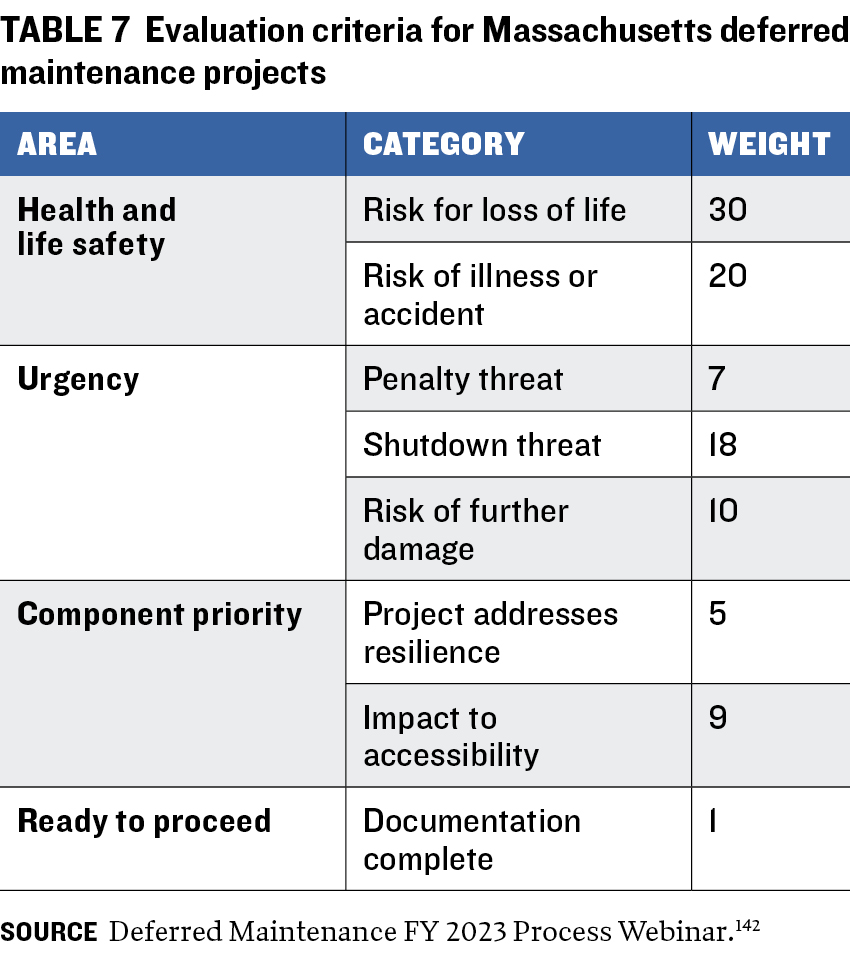
In recent years, decarbonization has become a factor influencing the approval of deferred maintenance projects. DCAMM works with the Department of Energy Resources to design standards for each project, with a particular focus on high-performance structures, reduction of on-site fossil fuel use, and strategic electrification of building systems. These standards are aimed at meeting the statewide goal of reducing greenhouse gas emissions by at least 85 percent and achieving net-zero carbon emissions by 2050.143 Funding requests that fail to align with the strategic priorities of decarbonization are not selected for funding. Projects with potential energy-efficient alternatives are sent back to the House Doctor with recommendations to include decarbonizing technologies.144
Montana
Capital projects, including deferred maintenance projects, are prioritized in several steps.145 First, individual state agencies submit proposed projects, including supporting documentation such as explanations and photos, along with their prioritization specified in these four areas:
CATEGORY: Health and life safety; damage, wear-out, and failure; codes and standards; energy efficiency; improvement or replacement of asset; and enhancements and aesthetics.
CONDITION: Very good, good, fair, poor, and unacceptable
MISSION RISK: High, medium, low, and none
MISSION NEED: Critical, significant, relevant, moderate, low, none
Once all agencies have submitted requests, the Architecture and Engineering (A&E) Division staff reviews the project information for all projects and develops a single list of prioritized statewide projects.146 During the review, the division may ask state agencies for additional documentation to create prioritized requests for major repair and capital development LRBP project.
A&E works with the Office of Budget and Program Planning to review and evaluate project requests for feasibility, agency needs, and increased operating costs.147 The requests are compiled into a single list of prioritized statewide projects and submitted to the governor, who reviews and submits them to the legislature.
Oklahoma
The Capital Improvement Plan (CIP) and annual capital budget are based on an extensive prioritization process.148 All projects requested by state agencies are prioritized according to statewide critical objectives and strategies, legislative and agency priorities, and anticipated funding sources. Projects are evaluated and prioritized using criteria adopted by the Long-Range Capital Planning Commission.
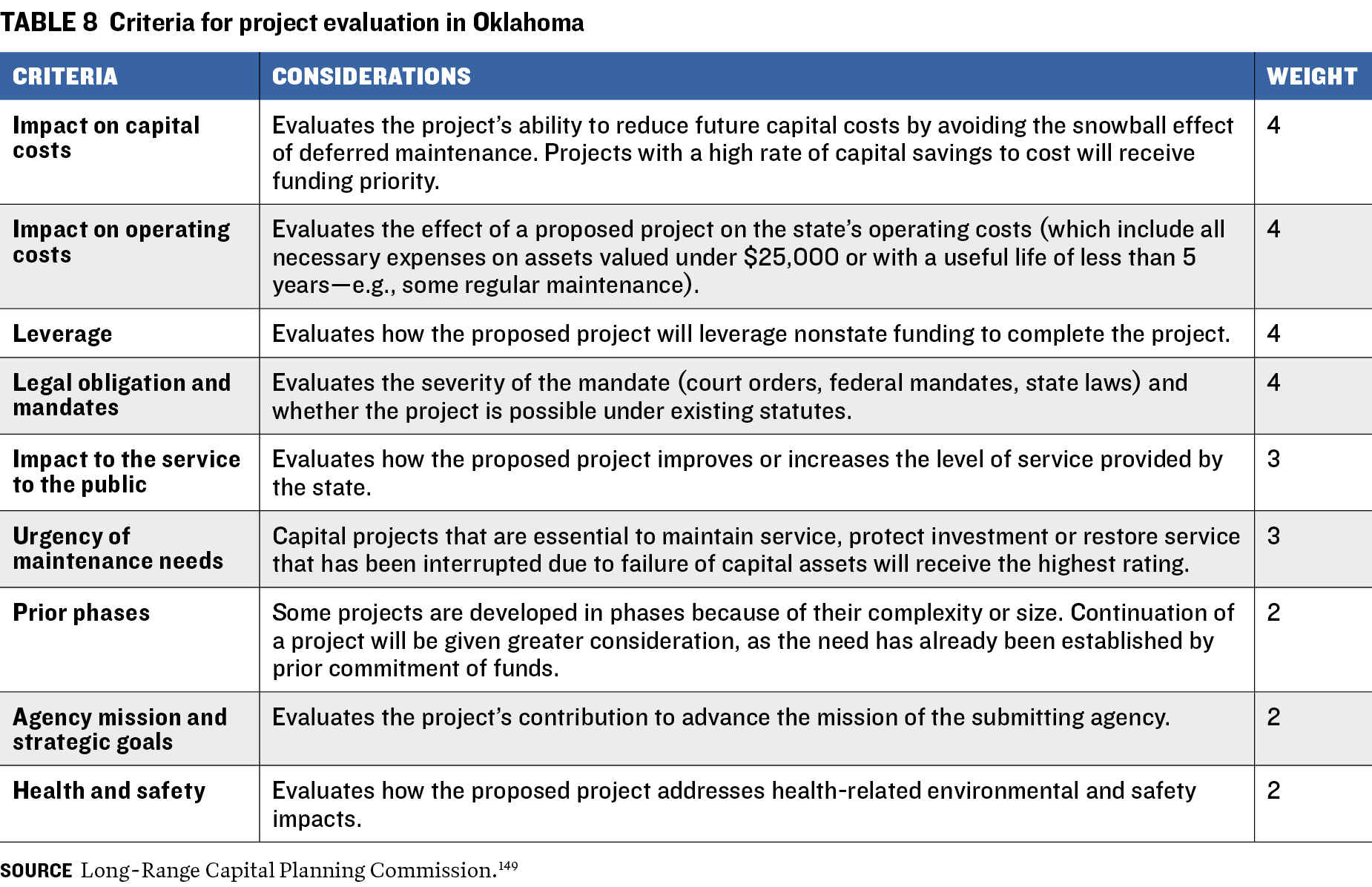
First, state agencies should submit project requests by fiscal year over the eight-year span of the CIP. Projects that are considered higher priority should be included in earlier years and lower priority ones in later years. In addition, agency prioritization should align with its strategic plan.
When submitting projects to the budget request system, state agencies are required to self-score each proposed project using specific criteria (table 8). Agencies are encouraged to submit brief but clear information on all requests so they can be considered in the statewide prioritization process.
After all agencies have submitted their projects, the capital planning staff evaluates them using the same criteria. It reviews and assesses requests for consistency with statewide objectives and prioritizes projects for their inclusion in the CIP. Once the staff has assessed all projects, it ranks them by rating score and develops a list to be recommended to the Long-Range Capital Planning Commission for consideration.
In 2025, the Office of Management and Enterprise Services designed a prioritization process after identifying several issues with multiple state-owned properties.150 Deferred maintenance projects are prioritized by life expectancy, component part availability, impact on building function, and expected life expectancy. All projects are rated in priority and criticality (table 9). 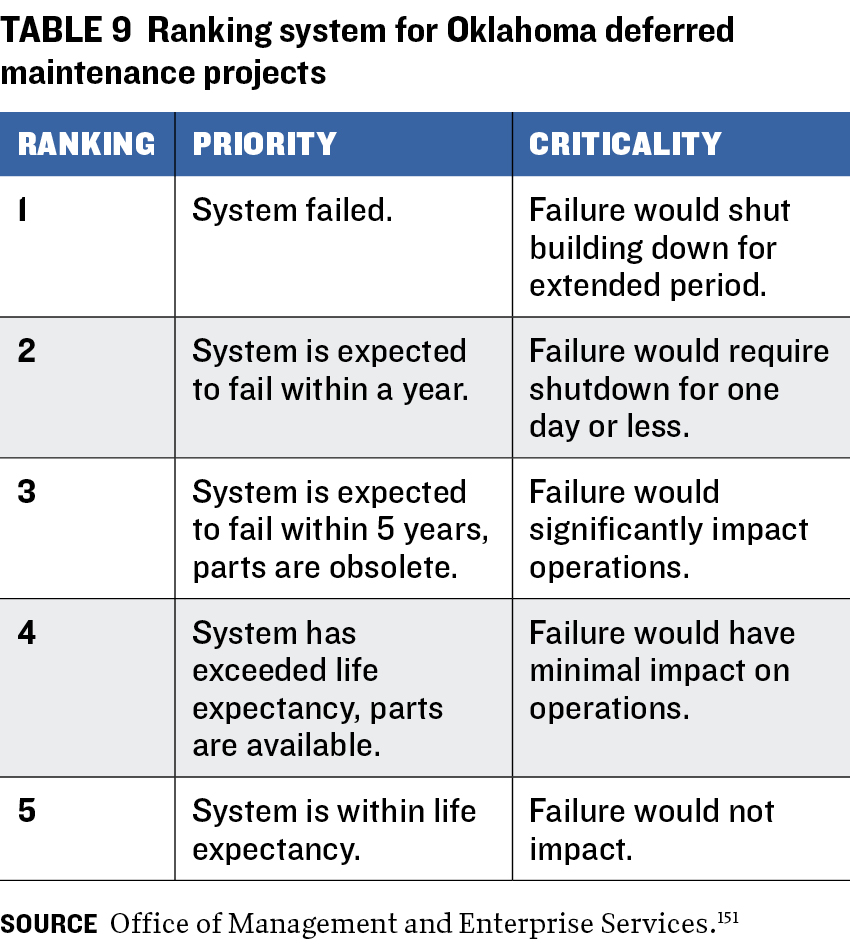
Based on these rankings, the deferred maintenance projects are divided into three phases:
Current AND CRITICAL (IMMEDIATE): Projects classified as high impact and highly likely to fail within 1-5 years
POTENTIALLY CRITICAL: Projects classified as medium impact and highly likely to fail within 1–5 years
NECESSARY, NOT YET CRITICAL: Lower-priority projects that are at the end of their life but do not have a significant impact on operations
Funding Deferred Maintenance Needs
Funding for deferred maintenance needs comes from a variety of sources—the primary ones in the analyzed states being state general funds and special funds. In California and Idaho, most funding comes from the general fund, while special revenue funds provide most of the funding in Alaska, Montana, and Oklahoma. California, Massachusetts, and Oklahoma have also borrowed by selling bonds to address these needs. Bond financing has been discussed in Alaska but has not progressed, while Idaho generally avoids issuing bonds for state facilities.
While most states disclose in budget documents the total amount of funding requested to address deferred maintenance, some, such as Alaska and California, report the total amount of funding actually appropriated. In the analyzed states, funding appropriated for deferred maintenance needs covers less than 4 percent of the total identified needs. Alaska and California maintained relatively constant funding allocations to deferred maintenance for 2015–22; and although the COVID-19 pandemic led to a reduction in allocations in 2020–21, these cuts were offset by increased funding in subsequent years.
The following section provides information on the funding allocations for deferred maintenance needs for each analyzed state, including funding identified to address infrastructure needs in Tennessee.
California
California uses multiple funding sources to address deferred maintenance needs. As part of the annual budget proposal, the governor seeks onetime dollars from the general fund to address critical deferred maintenance for the year. Additional proposed funding includes onetime allocation from the Proposition 98 general fund and bond proceeds. (Proposition 98 funding comes from general fund revenue and local property taxes and provides funds for K–12 schools and community colleges.)
In fiscal 2015-21, California allocated a total of $4.5 billion to address the most critical statewide deferred maintenance projects.152 Of this amount, 78.1 percent came from the general fund, 21.3 percent from the Proposition 98 general fund, 0.7 percent from Proposition 68 general obligation bond funds, earmarked for state and local parks, and 0.4 percent from the motor vehicle account.153 During this period, funding allocations covered an average of 0.5 percent of the state’s deferred maintenance needs (table 10).
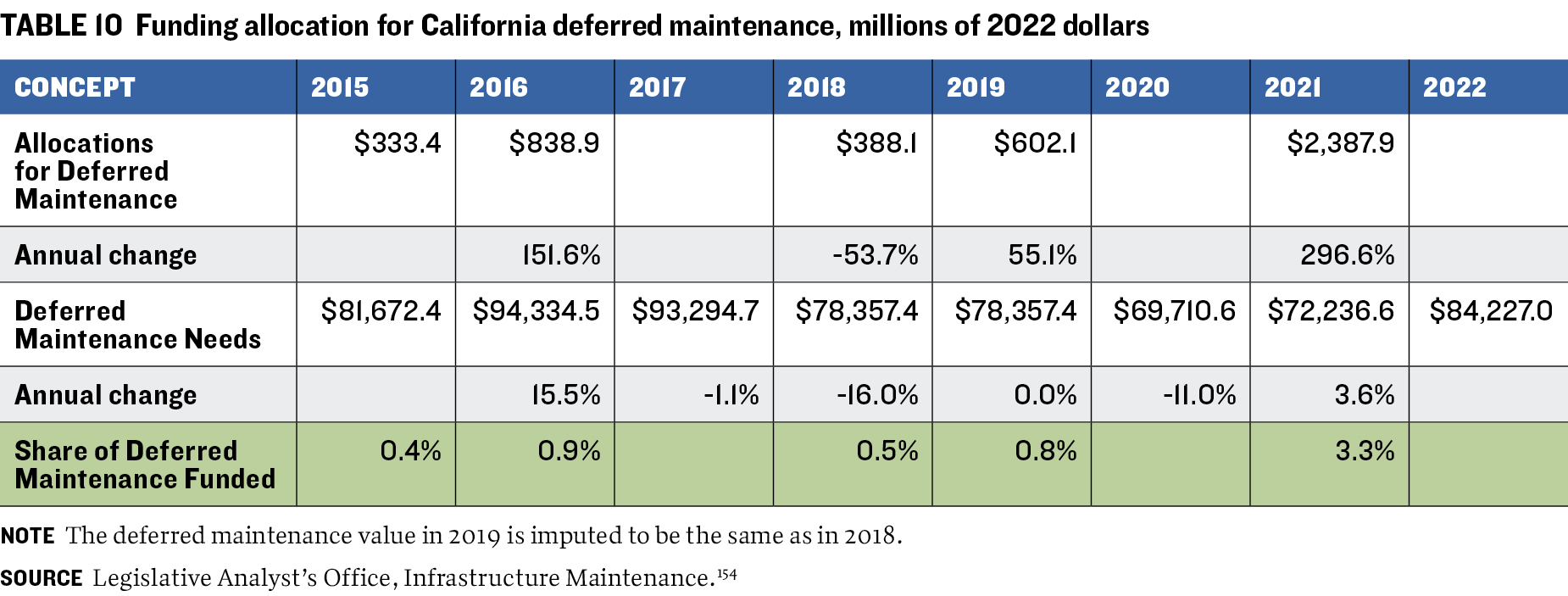
With the creation of the Road Maintenance and Rehabilitation Program to address deferred maintenance for state highways and local roadways, Senate Bill 1 (Chapter 5, Statutes of 2017) also created the Road Maintenance and Rehabilitation Account, funded by motor fuel taxes and registration and other fees, in the State Transportation Fund to provide cash for the program. SB 1 provides an estimated $2 billion in additional funds for roadway maintenance, helping reduce levels of deferred maintenance.155
Similarly, Senate Bill 5 (Chapter 852, Statutes of 2017) established the California Drought, Water, Parks, Climate, Coastal Protection, and Outdoor Access for All Act, which gave first priority to projects that addressed deferred maintenance in parks and waterways and provided bond funds for these projects. SB 5 provided $50 million to the Department of Fish and Wildlife (SB 5—section 80115) and at least $10 million in each of five regions identified for state parks (SB 5—section 80077).
Hawaii
The Department of Budget and Finance prepares the budget request but does not track funding allocated by the legislature for deferred maintenance.156 Funding allocation for deferred maintenance projects may be found as line items scattered throughout the budget act document.
Alaska
The governor implemented a plan for 2009–14 to appropriate $100 million annually in each of the five years starting in fiscal 2010 to reduce the deferred maintenance backlog.157 By focusing on deferred maintenance and providing a consistent funding stream, agencies improved identification and estimation of the cost of projects.
In 2018, the governor signed into law Senate Bill 107, which provided dedicated funds to address maintenance needs.158 The measure corrected a lack of dedicated funding and continual changes in priorities between administrations and legislators.159 Resources from the state’s Capital Income Fund (CIF), established in fiscal 2005, may now be appropriated for preventive or deferred maintenance.160 Before 2018, Alaska tapped unrestricted general funds, the Alaska Public Building Fund, federal dollars, and agency-specific funds to address deferred maintenance needs. Direct capital appropriations may also come from the capital budget for specific projects.
Most statewide deferred maintenance appropriations are currently funded through the CIF. In fiscal 2025, of the $38.3 million appropriated for deferred maintenance, 74 percent came from the CIF, 14 percent from the PBF, 3 percent from federal funds, 3 percent from fish and game receipts, and 6 percent from UGF.161
The CIF is a steady funding source that provides about $30 million per year for deferred maintenance. These appropriations are directed to the governor’s office and then allocated to agencies according to a review of the state Facilities Council prioritization ranking.162 The CIF is traditionally capitalized by an annual appropriation of earnings on a portion of the resources in the permanent fund.163
The Alaska Public Building Fund is a special account in the general fund established in 1999. Its assets may be appropriated to pay for management, operation, maintenance, and depreciation costs related to covered buildings managed under an agreement with the Department of Transportation and Public Facilities. The funding sources are payments made to the department by a private or public occupant of a covered building and appropriations to the funds.
In fiscal 2015–23, Alaska’s funding allocations for deferred maintenance varied widely (table 11). Without considering the University of Alaska’s deferred maintenance backlog (funding for it is excluded from the governor’s budget), allocations have covered an average of 4.7 percent of the state’s deferred maintenance needs. When considering the total amount of deferred maintenance in Alaska (including the university), allocations have covered an average of 1.5 percent of needs. Overall, there was a decrease in funding to address deferred maintenance in fiscal 2016 and an increase in fiscal 2019. The increase is consistent with new funding available to address deferred maintenance. The funding allocated in fiscal 2021 for deferred maintenance decreased because of the COVID-19 pandemic, but the decline was reversed in fiscal 2022.164
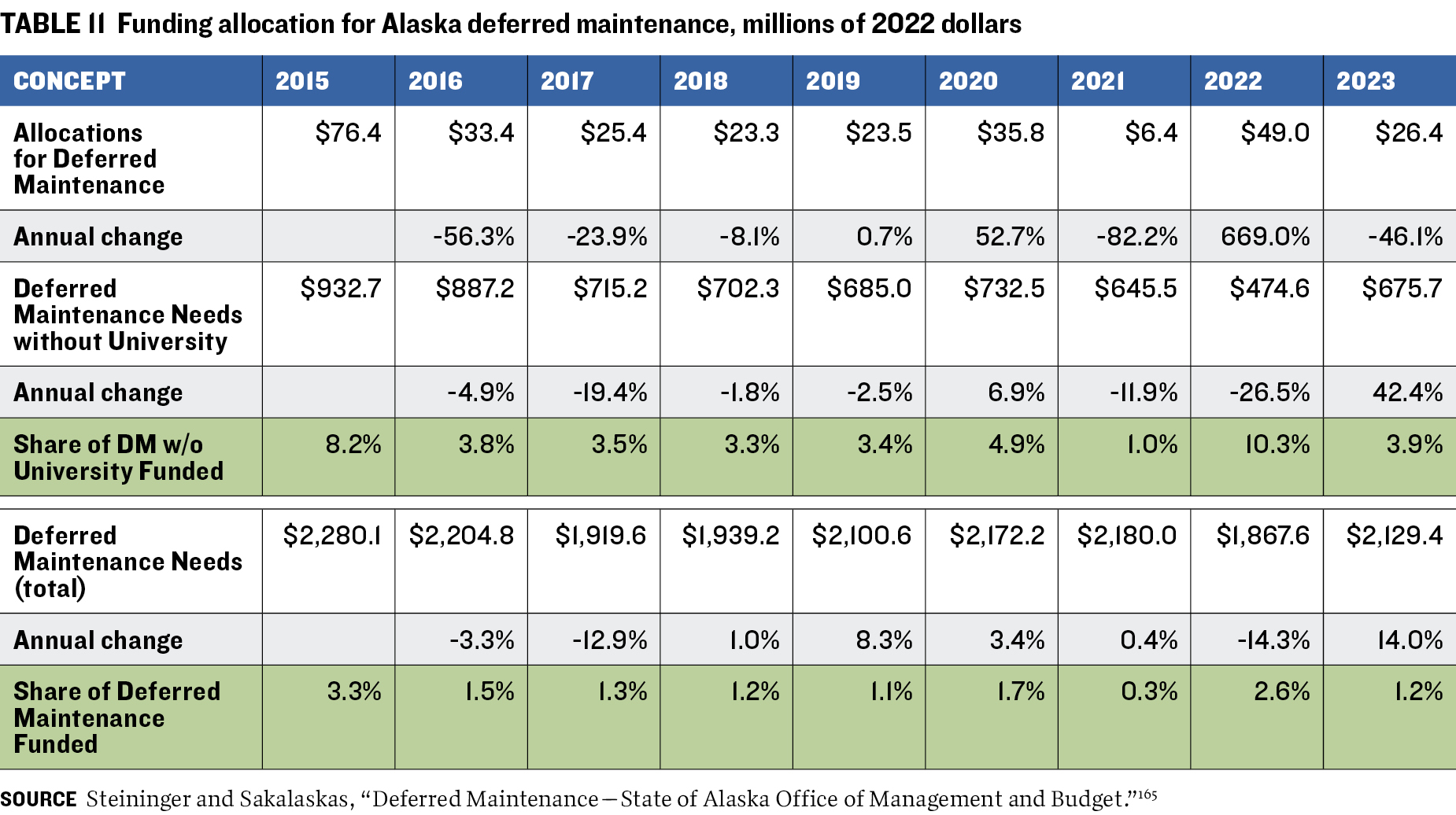
As of October 2024, Alaska had not issued bonds for deferred maintenance projects. Various financing options have been discussed to address deferred maintenance needs but have not advanced through the legislature.166
In addition to state-owned facilities, school facilities and rural water and sewer facilities that receive maintenance funding from the state have substantial deferred maintenance backlogs.167 The Village Safe Water Program funds water and sanitation facility maintenance, while the major maintenance grant fund pays for school district deferred maintenance.
Idaho
Idaho’s appropriations from the Permanent Building Fund (PBF), which receives dollars from tax, lottery, and general fund revenues, among others, cover alteration and repair projects, which typically include deferred maintenance. In fiscal 2011–21, on average, $25 million was applied annually for alteration and repair projects,168 about 2.7 percent of the total deferred maintenance needs estimated in 2021.
With a backlog of $911.9 million in deferred maintenance in 2021, the state increased funding. In fiscal 2022, the governor and legislature approved a onetime transfer of $244 million from the general fund to address the backlog.169 In fiscal 2023, the legislature appropriated an additional $150 million.170
Idaho generally avoids issuing bonds for state facilities.171 In addition, the state paid off outstanding bonds out of the budget surplus available after record federal aid to states to counter the economic impact of COVID-19. This freed up $18 million–$25 million annually that was used to pay debt service that can now be used by the PBF.
Illinois
The Capital Development Board (CDB) receives funding from pay-as-you-go resources and bonds to address deferred maintenance needs in state facilities. Pay-as-you-go resources have been mostly federal and some state funds, while financing has come primarily from general obligation and Build Illinois Bonds.172 The CDB spent $436 million in fiscal 2009-19 on deferred maintenance projects, with some projects funded through about $300 million173 in direct appropriations in Illinois Jobs Now! appropriations, and through state agency funds.174
In recent years, most funding for deferred maintenance has come from Rebuild Illinois, a $45 billion, six-year capital infrastructure program enacted in June 2019.175,176 It focuses on addressing urgent deferred maintenance across the state to reduce operational costs and prevent further damage to facilities. State facilities, universities, pre-K-12 facilities, colleges, and the departments of transportation and military affairs will receive funding from this program to address deferred maintenance.177 Key projects include updating plumbing, mechanical, electrical, and heating and air-conditioning systems, as well as making code-required repairs and fixing damaged building elements such as roofs, windows, and doors.
Under Rebuild Illinois, the CDB collaborates with state agencies to repair and construct facilities.178 As part of this program, the board is responsible for the oversight, administration, and distribution of funding for four grant programs and works with the state Department of Healthcare and Family Services, Department of Public Health, the Board of Education, and the Board of Higher Education to ensure the best use of available funding.179
Overall, more than $2.6 billion of Rebuild Illinois state facility funding for fiscal 2024 was dedicated to deferred maintenance investments to upgrade or replace broken or outdated infrastructure within the state’s assets.180
Massachusetts
Overall, Capital Investment Plans (CIPs) for the periods between fiscal 2017 and 2024 did not disclose the total amount of funding requested and allocated for deferred maintenance needs. However, the plans provided line items of approved critical repairs and deferred maintenance allocations by funding source for each state agency.
Because CIP is financed through bonds, the capital spending is subject to a bond cap.181 The division of Capital Asset Management and Maintenance (DCAMM) and its deferred maintenance program are also subject to a spending cap, which is determined every year by the legislature as part of the budget process. In a given year, projects receive funding until reaching the cap. In the CIP for fiscal 2024–28, $87.3 million (about 14.8 percent) of the total of $588.9 million approved for DCAMM went to pay for deferred maintenance and the remaining for building construction.182 For 2024, a total of $150.6 million was approved for the division, including $18.5 million for deferred maintenance.183
Under the new deferred maintenance allocation strategy for higher education institutions, funding allocations are made according to a formula.184 The total amount of funding allocated for fiscal 2025–29 was determined based on historical deferred maintenance requests that were approved.185 Of the total amount allocated, a base amount is distributed to each institution. Remaining funds are then allocated based on gross square footage, documented deferred maintenance, facility condition assessment, and enrollment.
Montana
For project funding, deferred maintenance projects can be placed in two categories:186 major repair, which includes renovations, alterations, replacements, or repair projects with a total cost of less than $2.5 million; and capital development, which includes renovation, construction, alteration, site, or utility projects with a total cost of $2.5 million or more. Most deferred maintenance projects are categorized as major repair. This distinction determines the Long-Range Building Program (LRBP) account that funds the project.
The major repair account provides consistent resources for prioritized corrective action so that expenses are not deferred to a more expensive future activity.187 This account was created with the passage of HB 553 in 2019 to fund major repairs. Funding sources include revenues from cigarette and coal severance tax interest earnings, project carryover funds, administrative fees, miscellaneous revenues, and transfers from the general fund (Montana Code Ann. § 17-7-221 and § 17-7-222). Of the funding in the account (Montana Code Ann. § 17-7-223) at least 80 percent of the funds that the legislature appropriates for major repair shall be devoted to “projects that address:
any issue that impacts health and safety;
failing building envelopes;
structural deficiencies;
energy, utility, or water savings;
projects that upgrade, repair, or replace mechanical, plumbing, or control systems;
electrical systems; fixed equipment; an essential building component; or
infrastructure, including a utility tunnel, water line, gas line, sewer line, roof, parking lot, or road; or projects that demolish and replace an existing building or facility that is in extensive disrepair and cannot be fixed by repair or maintenance.”
According to the law, in prioritizing major repair projects, no more than 20 percent of the funds that the legislature appropriates for major repair should be allocated to “remodeling and aesthetic upgrades to meet programmatic needs; or [to] construct an addition to an existing building or facility.”

In addition, the account should also have a minimum level of funding for major repair projects equal to 0.6 percent of the replacement cost of existing LRBP-eligible buildings for each fiscal year (Montana Code Ann. § 17-7-222). Table 12 presents the minimum level of funding starting from 2018.
The capital development account may also fund deferred maintenance projects. Funding for this account comes from annual transfers proposed by the governor from the general fund (the transfers are considered present law and must be equal to 1 percent of the amount of the certified unaudited state general fund revenue; Montana Code Ann. § 17-7-209).
The combined funding from the major repair and the capital development accounts may represent 1.0–1.5 percent of the building replacement value.189
In 2019, legislators created a new funding source for capital development projects referred to as the Working-Rainy-Day Fund. Under Montana Code Ann. § 17-7-130, the capital development funds may receive overflow transfers from the Budget Stabilization Reserve Fund (BSRF)190 under specific economic circumstances.191 Transfers to the account will not occur if the governor accesses the BSRF in the immediately preceding eleven months or has made spending reductions. In addition, the state treasurer may temporarily borrow from the account to address balance deficiencies in the general fund so long as a loan would not impair the account from meeting any legal obligations.
In addition to the LRBP funds, other sources could fund deferred maintenance needs. For instance, the Capitol Complex Executive Branch State Special Revenue Account might be used for high-priority projects that reduce the deferred maintenance backlog through the renovation and renewal of existing spaces (Montana Code Ann. § 17-7-226). Similarly, the SMART Deferred Maintenance Program is available for essential repairs and upgrades for the facilities of the Department of Military Affairs; the program provides necessary state matching funds to unlock federal resources.192
Oklahoma
Oklahoma funds its capital needs through two main sources: the Maintenance of State Buildings Revolving Fund (MSBRF) and bond issuance.193 The MSBRF’s revenue sources include sales proceeds of state-owned buildings, as required by the State Government Asset Reduction and Cost Savings Program. The MSBRF also receives funds from recommended annual and one-time legislative appropriations, but the amounts deposited are low and do not provide adequate funding for the state’s capital needs.194 (Proceeds from building sales may decline over time if the legislature continues to exempt agencies from the program, as it did for the Oklahoma Historical Society and the Department of Mental Health and Substance Abuse Services.)
Bond financing is preferred when there is a high repayment cost of pay-as-you-go funding through annual appropriation.195 The Long-Range Capital Planning Commission (LRCPC) identifies projects that are good candidates for funding through bond-indebtedness. The commission uses the following criteria to identify a select number of bond appropriate projects: whether current conditions pose a danger to the health, welfare, and safety of Oklahoma residents; whether imminent failure is probable, if not likely, in the project or facility; and whether failure of the facility would result in loss of critical services or would incur significant costs for the state.
In recent years, the Oklahoma legislature adopted new funding sources to support capital needs, including deferred maintenance needs. In 2023, for instance, the legislature created the Legacy Capital Financing Fund (LCFF) to initiate a loan program for the state’s capital needs (Oklahoma Statute § 73-187B). Loans are interest-free, are required to be repaid over twenty years, and carry lower issuance costs than a bond offer. The fund contains dollars from the Oklahoma Capitol Improvement Authority (which also administers the fund),196 and monies are invested in the state’s OK Invest program, where they earn interest monthly.197 The legislature appropriated $600 million for the LCFF in 2023 and $177 million in 2024. Of the total, $725 million was appropriated toward seventeen capital projects, including deferred maintenance.198 The LCFF had about $98 million available for future projects in December 2024 between unallocated appropriated dollars, recapitalization payments, and interest earnings.
As part of the Oklahoma Capital Assets Maintenance and Protection (OCAMP) Act, the legislature created the OCAMP Fund in 2024, which pays for deferred maintenance needs in the state (Oklahoma Statute § 73-188B). This fund will finance capital projects interest-free.199
For fiscal 2026–28, the board must allocate money from the OCAMP fund to mandated plans in the following proportions:
45 percent for the OCAMP State Five-Year Plan
45 percent for the OCAMP Higher Education Five-Year Plan. Of that, 20 percent must be for comprehensive institutions of higher education within the Oklahoma State System of Higher Education; 50 percent for four-year colleges and universities except the University of Oklahoma in Norman and Oklahoma State University in Stillwater; and 30 percent for two-year institutions of higher education within the Oklahoma State System of Higher Education.
10 percent for the OCAMP Tourism and Recreation Five-Year Plan
Table 13 presents total appropriations for capital projects and deferred maintenance appropriations in Oklahoma since 2017. The amounts provided do not include monies appropriated for higher education’s capital needs. Funding allocated for deferred maintenance has either been expressly indicated as such or highlighted as being for requests meeting the LRCPC’s prioritization criteria in the annual Capital Improvement Plans. The values reported under either category are outlined in table 13.
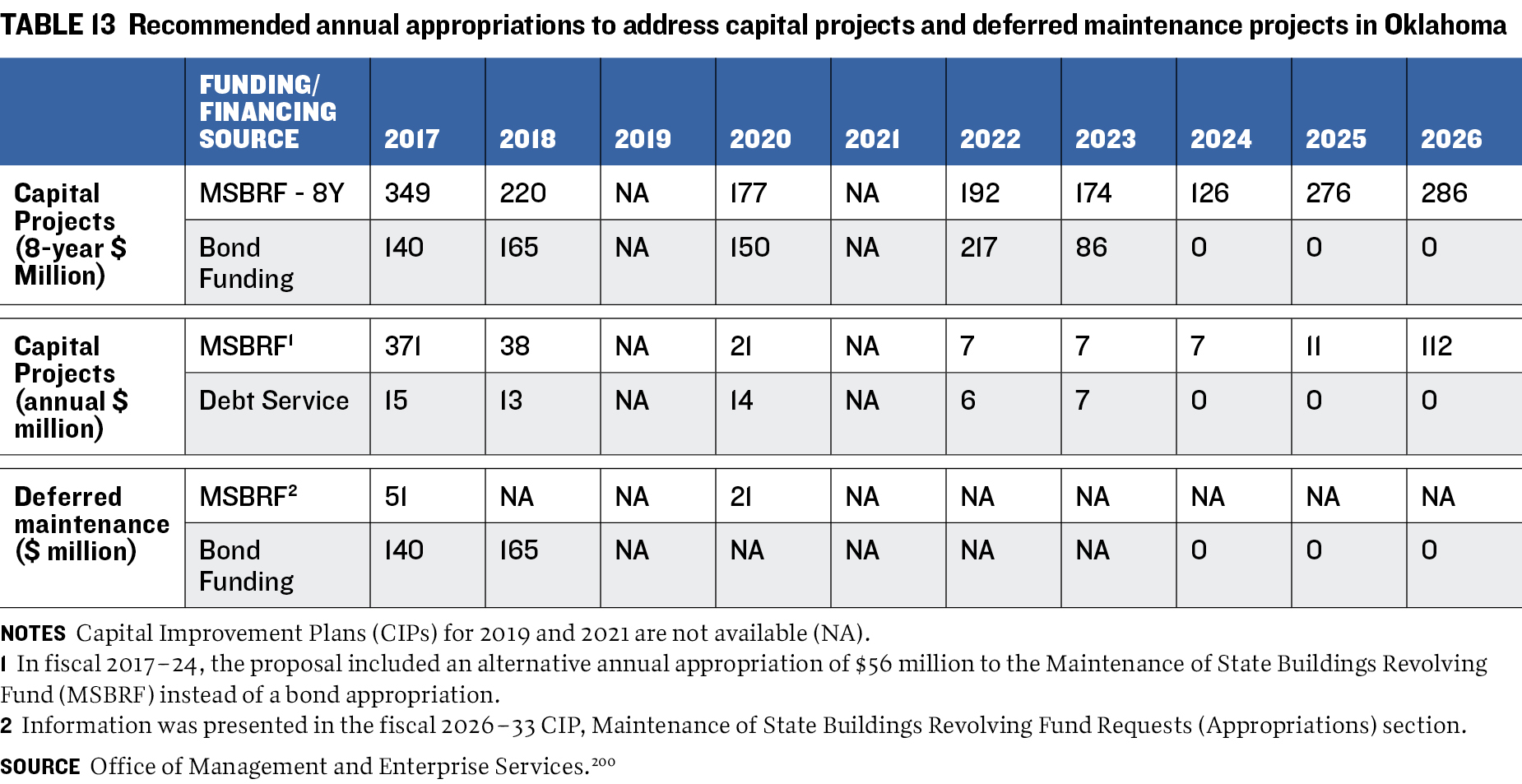
The legislature allocated $56.3 million in 2024 to the Office of Management and Enterprise Services Eight-Year Deferred Maintenance Plan for vital capital improvements to be performed on state-owned buildings in fiscal 2025.201 In addition, $56.1 million was allocated for deferred maintenance in 2025. This information is not included in the table, as the funding source is not explicitly stated in the capital budgeting documents.
According to budget data, other states dedicate funding of 2-3 percent of their building portfolios’ total replacement value to the capital budget. Oklahoma’s state-owned building portfolio was valued at $13 billion in fiscal 2025,202 which would translate to required funding of about $260 million for capital needs, including deferred maintenance.
Tennessee
State law does not require the Tennessee Advisory Committee on Intergovernmental Relations (TACIR) to compile funding information for the state’s infrastructure needs. However, TACIR has been reporting available funding sources and funding gaps that state agencies and localities report. Table 14 presents funding identified for five-year infrastructure needs starting in 2015. For instance, for the $68.3 billion needs identified for the fiscal 2022–27 period, a total of $49.8 billion in funding was reported. Of that amount, $16.6 billion is available and the remaining $33.1 billion is needed. Based on those figures, funding has not been identified for two-thirds of the estimated costs of needed infrastructure.203
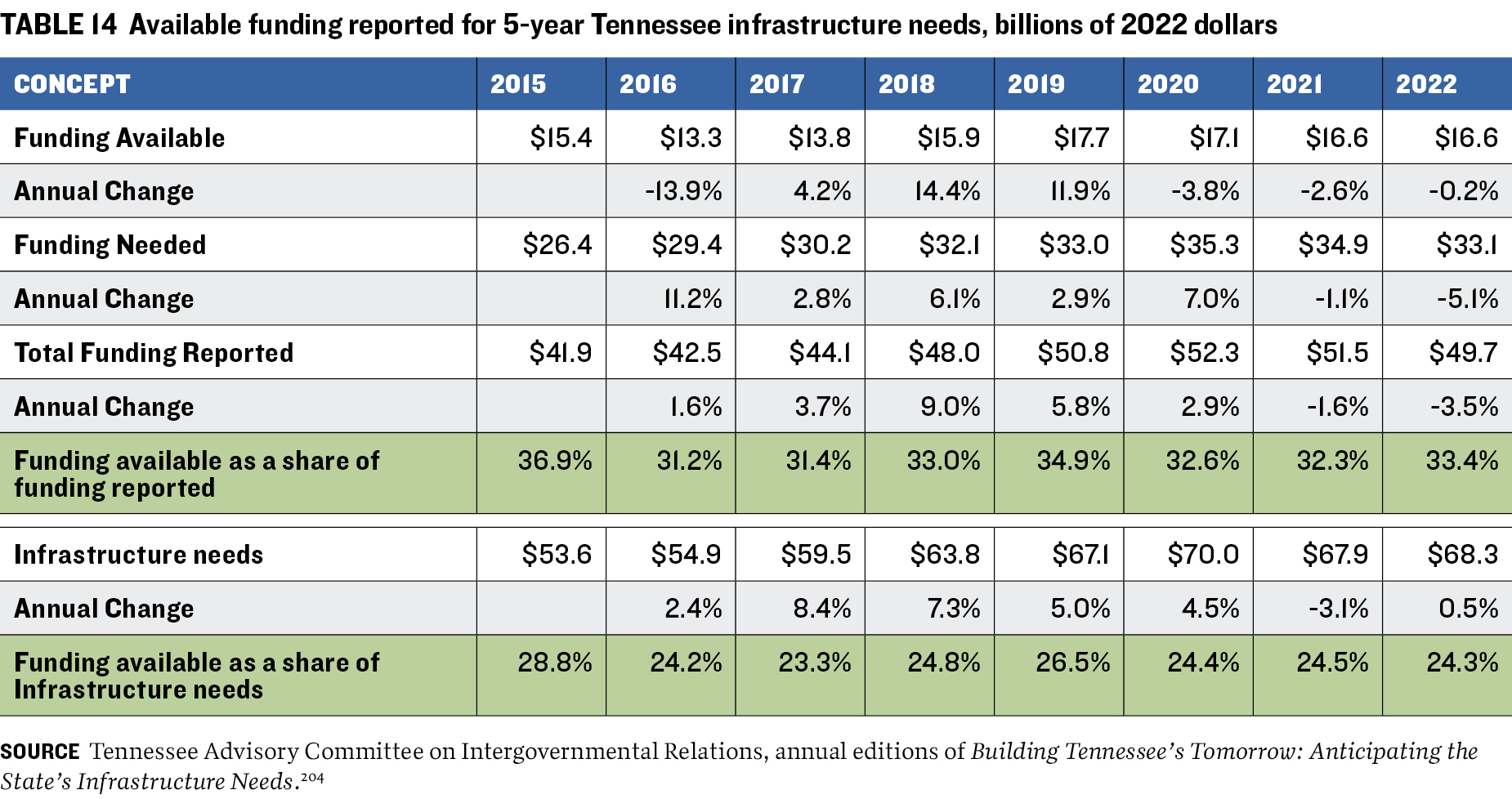
The funding available, which represents an average of 25.3 percent of the infrastructure needs since the fiscal 2015–20 period, comes from a variety of sources. For 2022–27, 33.1 percent comes from county funding sources, 31.0 percent from federal sources, 22.7 percent from cities, 9.6 percent from the state, and the remaining 3.6 percent from other sources.205
Future Plans for Addressing Deferred Maintenance
While all the analyzed states plan to continue their current efforts to address deferred maintenance backlogs, few have identified next steps or areas for improvement in their processes. Key strategies include preventing further accumulation of deferred maintenance by emphasizing early investments, exploring changes in management and budgeting processes to elevate efforts to address existing deferred maintenance backlogs, and temporarily increasing or providing ongoing funding to reduce accumulated deferred maintenance.
Alaska and Idaho, for example, are emphasizing early investments in preventive maintenance as a way to prevent further increased in deferred maintenance backlogs. In Alaska, preventive maintenance has been highlighted within the House Finance Committee to possibly avoid deferred maintenance. Although there is no rule on the level of investment necessary to avoid deferred maintenance, the Office of Management and Budget cites a range from the National Research Council of 2–4 percent of the replacement cost value.206 However, current levels of appropriations for maintenance in the state are about 40 percent of the lower value.207 The Alaska Legislative Finance Division has found that while the state is investing in its maintenance needs, current operating budget expenditures do not meet the needs of state facilities and are widening the deferred maintenance gap. Similarly, Idaho stresses preventive maintenance in an attempt to limit the backlog, but a plan to invest in preventive maintenance may be determined only after an analysis of deferred maintenance assessment.
Idaho is considering and undertaking strategies to better address its deferred maintenance backlog. Under the alteration and repair project section of the capital budget request, the state is creating a category specific to deferred maintenance projects to differentiate them from other alteration and repair projects. The state is also focusing on the need to have state agencies prioritize deferred and preventive maintenance of existing facilities over new capital projects. In particular, Idaho is considering establishing a facility condition index threshold for existing facilities that state agencies need to meet before embarking on new capital projects.
Similarly, California, Idaho, Illinois, Massachusetts, and Oklahoma have temporarily increased or are providing funding beyond 2025 to reduce accumulated deferred maintenance. California, Idaho, and Illinois have introduced new programs and funding initiatives to increase funding to address deferred maintenance backlogs. These states plan to adjust funding levels as progress is made and updated backlog estimates become available. Meanwhile, Massachusetts and Oklahoma have recently established new funding mechanisms designed to ensure ongoing support to tackle deferred maintenance backlogs.
In all analyzed states, budgeting practices typically separate maintenance from deferred maintenance: operating budgets cover maintenance, whereas capital budgets cover deferred maintenance, and explanations of how to address maintenance and prevent deferred maintenance are typically lacking. Efforts to bridge this gap may further contribute to addressing current backlogs.
In addition to having plans to address deferred maintenance, states are considering approaches that might impact deferred maintenance needs. For instance, the Illinois Capital Development Board (CDB) plans to demolish or remediate unused property.208 The capital budget for fiscal 2026 allocates $200 million to the CDB toward a new plan to demolish or remediate the state’s nonsurplus unused property, which includes initiatives to remove dilapidated state-owned structures, remediate sites to make them safe and useful, create new green space, and improve public safety. The budget also allocates $300 million to the Department of Central Management Services toward a “Surplus to Success” program aiming to transform surplus and long-shuttered state-owned facilities into economic development opportunities. Future research should study the impact of these decisions on deferred maintenance needs.
Conclusion
Deferred maintenance presents a $1 trillion—and growing—challenge for state governments as aging infrastructure, increasing weather-related stresses, constrained budgets, and rising service demands converge. Recent cuts in federal aid to states will only make this crisis more acute and may force states to raise more revenue or choose between investing in long-overdue infrastructure investments and the delivery of essential services to their citizens.
To address this challenge, clear definitions of maintenance and deferred maintenance are important for reducing ambiguity and fostering alignment across state agencies. Establishing consistent terminology will lay a foundation for coordinated efforts. A robust governance framework is also essential for managing the multistep process of addressing deferred maintenance needs. Strong policies should guide identification and assessment processes, delineate responsibilities, eliminate ambiguities, and close information gaps that can hinder progress. Policies that explicitly address the topic of deferred maintenance are important to align state agency efforts and to ensure compliance. Commitment by state leadership and sustained funding are equally essential to drive progress.
Deferred maintenance needs are most pronounced in sectors such as transportation and education, in which growth of needs continues to outpace available funding. In states that report appropriations, funding to address these needs represents around 4 percent of the identified backlog. Combined with insufficient investment in preventive maintenance, inadequate deferred maintenance funds have engendered an expanding backlog in most states.
The ten states identified in this study highlight approaches that can serve as models for others that are beginning their efforts. The tool kits that accompany this paper can help policymakers and advocates advance these needed reforms. Without comprehensive, standardized processes for assessing, reporting, and ultimately reducing deferred maintenance backlogs, the physical foundations and fiscal stability of the states and the entire US economy will remain at risk.
ACKNOWLEDGMENTS
The research team extends its gratitude to the state officials in Alaska, California, Hawaii, Idaho, Massachusetts, Montana, and Tennessee who generously shared their time and expertise in responding to questions for the case study, both through interviews and written communications. Their thoughtful contributions were invaluable for our understanding of how they assess deferred maintenance needs in their states and thus for shaping the findings of this study. The research team also extends its gratitude to all state officials and transportation officials who generously shared their time and expertise in responding to questions in the fifty-state survey.
The research team wishes to thank Kaitlyn Freeman and Merlene-Patrice Quispe for their valuable assistance in gathering critical information for several of the case studies, and to Wenqi Zhao for his assistance in gathering information for the fifty-state review. Their support was important to the successful completion of the project.
The research team wishes to thank the staff members at the Volcker Alliance who provided us with invaluable support and advice:
• Noah Winn-Ritzenberg, Senior Director, Public Finance
• William Glasgall, Public Finance Adviser
• Graham Dowd, Program Manager
• Nathalia Trujillo, Associate Director, Public Finance
• Divine Adeniyi, Program Assistant, Public Finance
• Melissa Austin, Chief Operating Officer
• Idalis Foster, Communications Manager
This report was supported by The Pew Charitable Trusts. The findings and recommendations are not necessarily endorsed by the supporting organization(s). The research team would like to extend gratitude to David Draine, Fatima Yousofi, Andrea Wales, Emma Wei, Aleena Oberthur, Mary Murphy, Corryn Hall, and Sara Dube of The Pew Charitable Trusts for their contributions to this report.
© 2025 VOLCKER ALLIANCE INC.
Published October, 2025
The Volcker Alliance Inc. hereby grants a worldwide, royalty-free, non-sublicensable, non-exclusive license to download and distribute the Volcker Alliance paper titled Meeting the Trillion-Dollar Challenge: Deferred Infrastructure Maintenance Practices Across Ten States (the “Paper”) for non-commercial purposes only, provided that the Paper’s copyright notice and this legend are included on all copies.
This paper was published by the Volcker Alliance as part of its Capital Budgeting and State Deferred Maintenance project. The views expressed in this paper are those of the authors and do not necessarily reflect the position of the Volcker Alliance. Any errors or omissions are the responsibility of the authors.
Don Besom, art director; Michele Arboit, copy editor.
ENDNOTES
1. Jerry Zhirong Zhao, Camila Fonseca Sarmiento, and Jie Tan, America’s Trillion-Dollar Repair Bill: Capital Budgeting and the Disclosure of State Infrastructure Needs, Volcker Alliance, November 2019, https://www.volckeralliance.org/sites/default/files/attachments/America….
2. Neil Steininger and Melanie Arnolds, “Deferred Maintenance,” Alaska Office of Management and Budget, February 11, 2022, https://www.akleg.gov/basis/get_documents.asp?session=32&docid=79057.
3. Stephen Nessen, “A New Plan to Fix the Crumbling BQE in Brooklyn Heights,” Gothamist, March 7, 2025, https://gothamist.com/news/a-new-plan-to-fix-the-crumbling-bqe-in-brook…; and American Society of Civil Engineers, Report Card for California’s Infrastructure 2019, May 2019, https://www.infrastructurereportcard.org/wp-content/uploads/2018/10/ASC…—CA2019_FINAL.pdf.
4. America’s Trillion-Dollar Repair Bill: Capital Budgeting and the Disclosure of State Infrastructure Needs.
5. Federal Reserve Bank of St. Louis, “Real Gross Domestic Product,” Version Q1 2025, https://fred.stlouisfed.org/series/GDPC1.
6. Tammy Webber and Michael Phillis, “US Infrastructure Improved with Biden-Era Spending but There’s a Long Way to Go,” Associated Press, March 25, 2025, https://apnews.com/article/infrastructure-report-card-civil-engineers-3….
7. Joseph W. Kane, Adie Toner, and Ben Swedberg, “Four Recent Trends in US Public Infrastructure Spending,” Brookings Institution, March 27, 2025, https://www.brookings.edu/articles/four-recent-trends-in-us-public-infr….
8. America’s Trillion-Dollar Repair Bill: Capital Budgeting and the Disclosure of State Infrastructure Needs.
9. Gabriel Petek, The 2019-20 Budget: Deferred Maintenance, Legislative Analyst’s Office, February 8, 2019, https://lao.ca.gov/reports/2019/3929/deferred-maintenance-020819.pdf; and State of California, California Five-Year Infrastructure Plan 2022-23, https://ebudget.ca.gov/2022-Infrastructure-Plan.pdf.
10. Legislative Financial Division, The Fiscal Year 2019 Budget: Legislative Fiscal Analyst’s Overview of the Governor’s Request, https://legfin.akleg.gov/Overview/Overview2019.pdf.
11. Department of Administration, State of Idaho Capital Assets Deferred Maintenance Liability: Initial Report to the Governor, November 15, 2021, https://dpw.idaho.gov/wp-content/uploads/Home/Initial-Report-to-Governo….
12. Interview by researchers with Hawaii state officials, May 31, 2024.
13. Governor Brad Little, “Executive Order No. 2021-10 Transparency in Budgeting,” June 11, 2021, https://gov.idaho.gov/wp-content/uploads/2021/06/eo-2021-10.pdf.
14. Frances Lippitt, Permanent Building Fund, Base Review LBB 6-25, https://legislature.idaho.gov/wp-content/uploads/budget/JFAC/sessionrec…. (The PBFAC directs the Permanent Building Fund’s capital and maintenance project investments. The fund’s budget includes construction and maintenance costs for state buildings.)
15. State of Idaho Capital Assets Deferred Maintenance Liability.
16. Architecture & Engineering Division, 2024 Statewide Facility Inventory & Condition Assessment Report, August 26, 2024, https://architecture.mt.gov/_docs/FCA/2024-Statewide-FCA-Report.pdf.
17. State of Oklahoma, Division of Capital Assets Management, Office of Management and Enterprise Services (OMES), Capital Planning and Asset Management: A Comprehensive Approach for State Government, December 2012, https://www.ok.gov/DCS/documents/CapitalPlanningAndAssetManagement.pdf.
18. OMES is charged with responsibility for construction, repair, maintenance, insurance and operation of all buildings owned, used or occupied by, or on behalf of the state, including buildings owned by the Oklahoma Capitol Improvement Authority (OK ST §74-63B). OMES is considered the owner and operator of eighteen of the thirty buildings in the State Capitol Complex.
19. The Tennessee Advisory Commission on Intergovernmental Relations (TACIR) was established in July 1978 (Chapter 939, Public Acts of 1978) in response to the need for a permanent intergovernmental body to study and act on questions of organizational patterns, powers, functions, and relationships among federal, state, and local governments. Additional historical information can be found at https://www.tn.gov/tacir/about-tacir/history.html.
20. State of California, California’s Five-Year Infrastructure Plan 2014, https://dof.ca.gov/wp-content/uploads/sites/352/Programs/Capital_Outlay….
21. Mac Taylor, The 2016-17 Budget: Governor’s General Fund Deferred Maintenance Proposal, February 2016, https://lao.ca.gov/reports/2016/3353/deferred-maintenance-021116.pdf.
22. The 2019-20 Budget: Deferred Maintenance.
23 The 2019-20 Budget: Deferred Maintenance.
24. University of California Office of the President, Facilities Manual: Deferred Maintenance Program, Vol. 6, Chap. 2, https://www.ucop.edu/facilities-manual/manual/volume-6/vol-6-chapter-2….
25. Department of Budget and Finance, “Instructions for Form DMC: FB 19-21 Budget Estimated Deferred Maintenance Costs,” https://budget.hawaii.gov/wp-content/uploads/2018/10/Form-DMC-FB-19-21-….
26. Among executive agencies, thirteen reported deferred maintenance costs and five reported none. In addition to the agencies, the Office of the Governor and the Office of the Lieutenant Governor reported no deferred maintenance costs. The Department of Public Safety was redesignated as the Department of Corrections and Rehabilitation and the Department of Law Enforcement, effective January 1, 2024. For additional information see Department of Public Safety, “Web Notice-Department of Public Safety Hawaii,” 2024, https://dps.hawaii.gov.
27. State of Hawaii, Department of Education, Annual Report on Six-Year Program and Financial Plan for School Repair and Maintenance, December 2022, https://www.hawaiipublicschools.org/Reports/DOE_REPORT2023_SixYearPlan….
28. State of Hawaii, Department of Education, “HI-FIT Hawai’i Facilities Inspection Tool,” https://hidoehifit.4dapt.com/index.html.
29. The Gordian Group Inc., University of Hawaii: Facility Renewal Reinvestment Study, 2019 Update, December 2019, https://www.hawaii.edu/oci/forms/FRRM_2019_Sightlines_Report_buildings_….
30. Facility Force, “The State of Alaska: Tackles Statewide Deferred Maintenance,” 2021, https://fac.goassetworks.com/hubfs/Government/New%20Website/Marketing%2…
31. Adam Bryan and Mark Davis, “State of Alaska Deferred Maintenance Update,” Presentation to Alaska Senate Finance Committee, January 26, 2018, https://www.akleg.gov/basis/Meeting/Detail?Meeting=SFIN%202018-01-26%20….
32. State of Alaska Capital Project Summary, “Computerized Maintenance Management System,” July 1, 2021, https://omb.alaska.gov/ombfiles/22_budget/Trans/Enacted/2022proj62693.p….
33. The CMMS software includes modules for asset management, operations and maintenance, space management, lease management, energy management, capital planning and projects, and fixed asset management Implementation of the project is scheduled for 3.5 years, which includes software licensing, software maintenance and support, software upgrades, implementation, training, and hosting.
34. Steininger, video presentation on deferred maintenance to Alaska Senate Finance Committee, January 27, 2023, https://www.akleg.gov/basis/Meeting/Detail?Meeting=SFIN%202023-01-27%20…; Steininger and Jason Sakalaskas, “Deferred Maintenance,” January 27, 2023, https://www.akleg.gov/basis/get_documents.asp?session=33&docid=122.
35. Alaska state officials, email to researchers, “Alaska’s Deferred Maintenance Electronic Communication,” September 18, 2024.
36. Email from Alaska state officials, September 18, 2024.
37. Email from Alaska state officials, September 18, 2024.
38. Email from Alaska state officials, September 18, 2024.
39. State of Idaho Capital Assets Deferred Maintenance Liability.
40. State of Idaho Capital Assets Deferred Maintenance Liability.
41. Based on R.S. Means cost estimate databases, an annual software subscription costs $131,250 (assuming facility condition assessments performed on 25 million square feet of capital assets) and would include unlimited user licenses so each agency would be able to access the system. The cost would include an annual inflation adjustment of 3% after the first year.
42. State of Idaho Capital Assets Deferred Maintenance Liability.
43. Researchers’ interview with Idaho state officials, May 17, 2024.
44. Researchers’ interview with Idaho state officials, May 17, 2024.
45. State of Idaho Capital Assets Deferred Maintenance Liability.
46. State of Idaho, “Executive Branch,” https://idaho.gov/government/executive/.
47. Board is bipartisan and composed of seven members appointed by the governor and confirmed by the Senate. Members serve four-year unpaid terms. Aggertt, “Illinois Capital Development Board, along with the Office of the Architect of the Capitol.”
48. Governor JB Pritzker, Capital Budget Fiscal Year 2025, February 21, 2024, https://budget.illinois.gov/content/dam/soi/en/web/budget/documents/bud….
49. Illinois Capital Development Board, Capital Development Board Book, July 9, 2024, https://cdb.illinois.gov/content/dam/soi/en/web/cdb/about/boardmeetings….
50. Capital Development Board Book.
51. Capital Budget Fiscal Year 2025.
52. Capital Development Board Book and Capital Budget Fiscal Year 2025.
53. While IDOT’s methodology for assessing deferred maintenance needs is not specifically cited in capital budget documents, the department relies on its federally approved Transportation Asset Management Plan to program maintenance and improvement projects for the state’s network of highways and bridges.
54 Commonwealth of Massachusetts Division of Capital Asset Management and Maintenance, “Instructions for Preparing and Submitting a Study for Certification of a Deferred Maintenance Project,” https://www.mass.gov/doc/dsb-22-13-deferred-maintenance-new-study-instr….
55. Includes about 5,000 buildings under DCAMM jurisdiction.
56. Interview with Massachusetts state officials, January 23, 2025.
57. Commonwealth of Massachusetts, Division of Capital Asset Management and Maintenance, “Deferred Maintenance FY23 Process Webinar,” April 18, 2022, https://www.youtube.com/watch?v=ra3gywu42ey; and “Instructions for Preparing and Submitting a Study for Certification of a Deferred Maintenance Project,” https://www.mass.gov/doc/dsb-22-13-deferred-maintenance-new-study-instr….
58. Interview with Massachusetts state officials, January 23, 2025.
59. Interview with Massachusetts state officials, January 23, 2025.
60. Higher Education Capital Working Group, Final Report, January 21, 2025, https://www.mass.gov/doc/higher-education-capital-working-group-final-r….
61. Higher education also receives state capital funding from the Accelerated Building Infrastructure Projects program and the Major Capital Projects program. The Accelerated Building Infrastructure Projects program was introduced in the FY23 capital plan, and addresses horizontal infrastructure needs throughout the higher education system such as electrical, steam, heating, and sewer infrastructure that fall outside the scope of the Critical Repairs Project. The Major Capital Projects program was initiated in FY19 following the Strategic Framework for Massachusetts Public Higher Education and funds larger-scale projects.
62. “Deferred Maintenance FY23 Process Webinar” and “Instructions for Preparing and Submitting a Study for Certification of a Deferred Maintenance Project.”
63. CAMIS is a web based, centralized platform allowing user agencies to request services and report facility issues and that maintains records of corrective and preventive maintenance work associated with facility properties and equipment. The platform also generates reports to track performance for corrective or preventive maintenance by building, campus, agency, or region. CAMIS also can be used to request and track deferred maintenance funding from DCAMM.
64. “Deferred Maintenance FY23 Process Webinar.”
65. Key agencies involved in the CIP are DCAMM and DOT.
66. “Deferred Maintenance FY23 Process Webinar.”
67. Commonwealth of Massachusetts, Division of Capital Asset Management and Maintenance, , “Study for Certification of Deferred Maintenance Project,” https://www.mass.gov/doc/deferred-maintenance-study-template.
68. “Instructions for Preparing and Submitting a Study for Certification of a Deferred Maintenance Project.”
69. “Deferred Maintenance FY23 Process Webinar.”
70. Interview with Massachusetts state officials, January 23, 2025.
71. Commonwealth of Massachusetts, Division of Capital Asset Management and Maintenance, “Deferred Maintenance,” https://www.mass.gov/info-details/deferred-maintenance.
72. Commonwealth of Massachusetts, Fiscal Year 2017-2021 Five Year Capital Investment Plan, May 2016, https://budget.digital.mass.gov/bb/cap/fy2017/dnld/fy17capitalplanma.pdf.
73. Commonwealth of Massachusetts, Fiscal Year 2019-2023 Five Year Capital Investment Plan, May 2018, https://budget.digital.mass.gov/bb/cap/fy2019/dnld/fy19capitalplanma.pdf.
74. Interview with Massachusetts state officials, January 23, 2025.
75. Commonwealth of Massachusetts, Division of Capital Asset Management and Maintenance, Statement of Work (SOW) for Facility Conditions Assessment of Massachusetts Correctional Facilities, April 17, 2019, https://correctionalfunding.com/wp-content/uploads/2019/12/DCAMM-Statem…; “Massachusetts State Police - Facility Condition Assessment,” https://www.mass.gov/info-details/massachusetts-state-police-facility-c…; and HigherGov, “DCAMM Facility Condition Assessment RFR,” June 25, 2019, https://www.highergov.com/sl/contract-opportunity/ma-dcamm-facility-con….
76. FOS, “FCA for Statewide Higher Education System in MA,” December 2022, https://www.foscd.com/higher-ed-case-studies/massachusetts-statewide-fca.
77. 2024 Statewide Facility Inventory & Condition Assessment Report.
78. 2024 Statewide Facility Inventory & Condition Assessment Report.
79. 2024 Statewide Facility Inventory & Condition Assessment Report.
80. 2024 Statewide Facility Inventory & Condition Assessment Report.
81. 2024 Statewide Facility Inventory & Condition Assessment Report.
82. Interview with Montana state officials, February 27, 2025.
83. 2024 Statewide Facility Inventory & Condition Assessment Report.
84. 2024 Statewide Facility Inventory & Condition Assessment Report.
85. Montana Legislative Fiscal Division, FYE 2019 Quarterly Financial Report, Long-Range Planning-Long-Range Building Program, https://archive.legmt.gov/content/Publications/fiscal/2021-Interim/Sept….
86. Montana Department of Administration, Architecture & Engineering Division, ,”Long-Range Building Program,” https://architecture.mt.gov/LRBP.
87. Capital Planning and Asset Management: A Comprehensive Approach for State Government.
88. Capital Planning and Asset Management: A Comprehensive Approach for State Government.
89. HB 2392, introduced in 2012, requires including criteria such as a comprehensive inventory of capital facilities; projection of economic and demographic trends that influence the need for new or expanded capital facilities; an estimate of mandatory, essential, desirable and deferrable repairs, replacement and expansions; estimates of life cycle costs for new and substantially expanded or renovated facilities; recommendations for maintenance of physical properties and equipment of state agencies; and other information related to capital project status, funding and forecasts.
90. State of Oklahoma, State Capital Improvement Plan, Sec. 91, Title 62 established the Long-Range Capital Planning Commission (LRCPC). It is required to prepare an annual capital plan budget and a plan for addressing state capital facility needs for the next eight years. The LRCPC also advises and assists the legislature in providing capital facilities for the state and provides recommendations to fund the state’s capital needs while offering provides policy recommendations on reforming how the state manages real property assets. LRCPC receives administrative support from OMES, with the advice of the State Bond Advisor’s office.
91. Office of Management and Enterprise Services (OMES), FY 2018-2025 Capital Improvements Plan and FY 2018 Capital Budget, https://journalrecord.com/wp-content/blogs.dir/1/files/2017/07/FY2018CI….
92. OMES, 2024 Real Property Asset Report, https://oklahoma.gov/content/dam/ok/en/omes/documents/2024RealPropertyR….
93. OMES, FY 2026-2033 Capital Improvements Plan and FY2026 Capital Budget, https://oklahoma.gov/content/dam/ok/en/omes/documents/2026-33CapitalImp….
94. TACIR, Building Tennessee’s Tomorrow: Anticipating the State’s Infrastructure Needs, July 2022 through June 2027, January 2024, https://www.tn.gov/content/dam/tn/tacir/infrastructure/2024infra2022-20….
95. Interview with Tennessee state officials, July 11, 2024.
96. Interview with Tennessee state officials, July 11, 2024.
97. Infrastructure needs were reported by 22 of 23 state agencies, 95 of 96 counties, 344 of 346 municipalities, and 372 school systems and other public entities, according to TACIR. Further information is available at https://www.tn.gov/content/dam/tn/tacir/commission-meetings/20024may/20….
98. Interview with Tennessee state officials, July 11, 2024.
99. Building Tennessee’s Tomorrow.
100. Building Tennessee’s Tomorrow.
101. Legislative Analyst’s Office, “Infrastructure Maintenance,” https://www.lao.ca.gov/Infrastructure/Maintenance.
102. “Infrastructure Maintenance”; State of California, 2015 California’s Five-Year Infrastructure Plan, https://ebudget.ca.gov/2015-Infrastructure-Plan.pdf; State of California, California Five-Year Infrastructure Plan 2016, https://ebudget.ca.gov/2016-Infrastructure-Plan.pdf; State of California, 2017 California Five-Year Infrastructure Plan, https://dof.ca.gov/wp-content/uploads/sites/352/Programs/Capital_Outlay…; State of California, Governor’s Budget Summary 2020-21, https://ebudget.ca.gov/2020-21/pdf/BudgetSummary/FullBudgetSummary.pdf; State of California, California Five-Year Infrastructure Plan 2021-22, https://ebudget.ca.gov/2021-Infrastructure-Plan.pdf; and California Five-Year Infrastructure Plan 2022-23.
103. California State Controller’s Office, “(SB1) Road Maintenance and Rehabilitation Program FAQs,” https://sco.ca.gov/aud_road_maintenance_sb1.html.
104. California Five-Year Infrastructure Plan 2021-22.
105. This section contains estimates of deferred maintenance costs contained in appendixes to the State of Hawaii’s Executive Biennium Budgets and Executive Supplemental Budgets for fiscal years 2017-25. The biennium budgets, including appendixes, can be found at https://budget.hawaii.gov/budget/executive-biennium-budget-fiscal-budge…. The supplemental budgets are available at https://budget.hawaii.gov/budget/executive-supplemental-budget-fiscal-y….
106. This section contains estimates of deferred maintenance costs contained in the Alaska Legislative Finance Division’s annual budget analyses for fiscal years 2018-25. The analyses can be found at https://www.legfin.akleg.gov/BudgetReports/LY2025/Operating/SelectBudge…;
107. Legislative Financial Division, The Fiscal Year 2021 Budget: Legislative Fiscal Analyst’s Overview of the Governor’s Request, https://legfin.akleg.gov/Overview/Overview2021.pdf.
108. Some bids for deferred maintenance projects exceed estimates by 65-113 percent, according to testimony to the Alaska Senate Finance Committee on January 27, 2023, by Jason Sakalaskas, Director, Facilities Services, Department of Transportation and Public Facilities. A video of the testimony can be found at https://www.akleg.gov/basis/Meeting/Detail?Meeting=SFIN%202023-01-27%20….
109. Email from Alaska state officials, September 18, 2024.
110. Alaska Legislative Financial Division, The Fiscal Year 2025 Budget: Legislative Fiscal Analyst’s Overview of the Governor’s Request, https://legfin.akleg.gov/Overview/Overview2025.pdf.
111. The Fiscal Year 2025 Budget: Legislative Fiscal Analyst’s Overview of the Governor’s Request.
112. Email from Alaska state officials, September 18, 2024.
113. DOA, State of Idaho Capital Assets Deferred Maintenance Liability; Office of the Governor, “JFAC Advances Governor’s Building Maintenance Budget Recommendation,” March 14, 2023, https://gov.idaho.gov/pressrelease/jfac-advances-governors-building-mai….
114. State of Idaho Capital Assets Deferred Maintenance Liability.
115. Interview with Idaho state officials, May 17, 2024.
116. This section is based on information contained in annual Illinois state capital budget documents for fiscal years 2017-26. These documents can be found at https://budget.illinois.gov/budget-books.html.
117. Capital Budget Fiscal Year 2025.
118. Capital Budget Fiscal Year 2025.
119. State of Illinois, Rebuild Illinois: Investing in Infrastructure for a Better Illinois, June 28, 2019, https://capitalmarkets.illinois.gov/content/dam/soi/en/web/capitalmarke….
120. This section contains information from Illinois capital budgets for fiscal years 2017-26. It also references Illinois State Board of Education, 2024 Capital Needs Assessment Survey Report, December 30, 2024, https://www.isbe.net/Documents/2024-Capital-Needs-Assessment-Survey-Rep….
121. University of Massachusetts, “FY24-FY28 Capital Plan,” September 20, 2023, https://www.umassp.edu/sites/default/files/document-archive/fy24-28-cap….
122. Interview with Massachusetts state officials, January 23, 2025.
123. According to the report, deferred maintenance refers to the “backlog of repairs and upkeep required to address wear and tear on and deterioration of campus buildings and infrastructure. Normal obsolescence as building components reach the end of their useful lives is compounded by frequent deferral of preventative maintenance due to budget constraints, resulting in aging and deteriorating facilities that may no longer meet basic functional or safety standards… This category also includes work needed to bring buildings up to contemporary life safety, accessibility, energy, and other code requirements adopted after the facilities’ initial construction.”
124. Final Report.
125. 2024 Statewide Facility Inventory & Condition Assessment Report.
126. Montana Department of Administration, Architecture & Engineering Division, 2022 Statewide Facility Inventory & Condition Assessment Report, August 26, 2022, https://architecture.mt.gov/_docs/LRBP/2022-Statewide-Facility-Inventor….
127. Oklahoma State Regents for Higher Education, “Capital and Maintenance Funding in the Oklahoma Higher Education System,” October 17, 2023, https://former.okhouse.gov/Documents/InterimStudies/2023/23-077_Capital….
128. Email from Tennessee state officials, July 19, 2024.
129. This section references the 2017-23 editions of the annual report series published by TACIR, Building Tennessee’s Tomorrow: Anticipating the State’s Infrastructure Needs. The reports can be found at https://www.tn.gov/tacir/infrastructure/infrastructure-reports-/buildin….
130. The 2019-20 Budget: Deferred Maintenance.
131. Facilities Manual: Deferred Maintenance Program.
132. Interview with Hawaii state officials, May 31, 2024.
133. Annual Report on Six-Year Program and Financial Plan for School Repair and Maintenance.
134. University of Hawaii: Facility Renewal Reinvestment Study, 2019 Update.
135. University of Hawaii: Facility Renewal Reinvestment Study, 2019 Update.
136. “Deferred Maintenance.”
137. “Deferred Maintenance.”
138. State of Idaho Capital Assets Deferred Maintenance Liability.
139. State of Idaho Capital Assets Deferred Maintenance Liability.
140. Deferred Maintenance FY23 Process Webinar; “Instructions for Preparing and Submitting a Study for Certification of a Deferred Maintenance Project”; and interview with Massachusetts state officials, January 23, 2025.
141. Interview with Massachusetts state officials, January 23, 2025.
142. Deferred Maintenance FY23 Process Webinar.
143. Commonwealth of Massachusetts, Fiscal Year FY2022-2026 Five-Year Capital Investment Plan, June 14, 2021, https://budget.digital.mass.gov/capital/fy22/static/fy22capitalplanma-1…; and Commonwealth of Massachusetts, “MA Decarbonization Roadmap,” https://www.mass.gov/info-details/ma-decarbonization-roadmap.
144. Interview with Massachusetts state officials, January 23, 2025.
145. Interview with Montana state officials, February 27, 2025.
146. Architecture and Engineering Division, “Long-Range Building Program Overview,” https://architecture.mt.gov/_docs/LRBP/LRBP-Program-Overview.pdf.
147. “Long-Range Building Program Overview.”
148. Long-Range Capital Planning Commission, Capital Improvements Plan: Capital Outlay Requests Project Submittal and Evaluation Guidelines, https://oklahoma.gov/content/dam/ok/en/omes/documents/CIPProjectGuideli….
149. Capital Improvements Plan: Capital Outlay Requests Project Submittal and Evaluation Guidelines.
150. Oklahoma Office of Management & Enterprise Services (OMES), “State of Oklahoma Deferred Maintenance Plan,” https://oklahoma.gov/content/dam/ok/en/omes/documents/DeferredMaintence….
151. “State of Oklahoma Deferred Maintenance Plan.”
152. “Infrastructure Maintenance.”
153. California Five-Year Infrastructure Plan 2022-23.
154. “Infrastructure Maintenance.”
155. California Five-Year Infrastructure Plan 2021-22.
156. Interview with Hawaii state officials, May 31, 2024.
157. Legislative Financial Division, The Fiscal Year 2019 Budget: Legislative Fiscal Analyst’s Overview of the Governor’s Request, https://www.legfin.state.ak.us/Overview/Overview2019.pdf.
158. Alaska Senate, Alaska Capital Income Fund, 30th Legislature, SB 107, https://legiscan.com/AK/text/SB107/id/1793424.
159. Email from Alaska state officials, September 18, 2024.
160. The Fiscal Year 2021 Budget: Legislative Fiscal Analyst’s Overview of the Governor’s Request and SB 107.
161. Email from Alaska state officials, September 18, 2024.
162. Email from Alaska state officials, September 18, 2024.
163. Office of Governor Mike Dunleavy, Office of Management and Budget, “Budget Terminology,” https://omb.alaska.gov/information/budget-terminology/.
164. Steininger, video presentation on deferred maintenance to Alaska Senate Finance Committee.
165. Steininger, “Deferred Maintenance Update: State of Alaska Office of Management and Budget,” Presentation to Senate Finance Committee, April 5, 2019, https://www.akleg.gov/basis/get_documents.asp?session=31&docid=34494; Steininger and Sakalaskas, presentation to Senate Finance Committee, January 27, 2023.
166. Email from Alaska state officials, September 18, 2024.
167. The Fiscal Year 2021 Budget: Legislative Fiscal Analyst’s Overview of the Governor’s Request; The Fiscal Year 2025 Budget: Legislative Fiscal Analyst’s Overview of the Governor’s Request.
168. State of Idaho Capital Assets Deferred Maintenance Liability.
169. Idaho House of Representatives, 66th Legislature, Second Regular Session-2022, House Bill No. 779, https://legislature.idaho.gov/wp-content/uploads/sessioninfo/2022/legis…; “JFAC Advances Governor’s Building Maintenance Budget Recommendation”; and “Legislative Budget Book FY2024.”
170. “Legislative Budget Book FY2024.”
171. Interview with Idaho state officials, May 17, 2024.
172. This section references Illinois capital budgets for fiscal year 2022-25.
173. The IJN plan was a $31 billion economic recovery initiative passed in 2009 aimed at addressing infrastructure needs across Illinois. The plan included capital investments and deferred maintenance investments in railroads, roads, schools, community facilities, and higher education.
174. State of Illinois, Capital Budget FY 2018, https://budget.illinois.gov/budget-books.html.
175. Illinois Economic Policy Institute, “Rebuild Illinois Overview,” https://illinoisepi.org/rebuild-illinois/overview/.
176. Total funding allocated in the six-year plan includes $25.4 billion for roads and bridges, $7.9 billion for mass transit and other transportation, $4.4 billion for state facilities, $2.9 billion for higher education, $1.8 billion for economic and community development, $1 billion for environmental and conservation activities, and $1.4 billion for other categories.
177. Rebuild Illinois: Investing in Infrastructure for a Better Illinois.
178. State of Illinois, Capital Budget FY 2025, https://budget.illinois.gov/budget-books.html.
179. Capital Development Board, “Rebuild Illinois Grant Programs,” https://cdb.illinois.gov/professionalgrowth/grants.html.
180. State of Illinois, Capital Budget FY 2024, https://budget.illinois.gov/budget-books.html.
181. The Massachusetts bond cap refers to a statutory limit on the amount of new capital spending that can be supported by issuance of general obligation bonds. Also known as a debt limit, this determines how much the state can borrow each year for infrastructure projects. More information can be found at Massachusetts Taxpayers Foundation, MTF Legislative Session Preview 2025-2026, https://www.masstaxpayers.org/sites/default/files/publications/2025-01/….
182. Commonwealth of Massachusetts, “Capital Investment Plan by Policy Area FY2024-2028,” 2023, https://budget.digital.mass.gov/capital/fy24/policy-area/; interview with Massachusetts state officials, January 23, 2025.
183. “Capital Investment Plan by Policy Area FY2024-2028.”
184. Commonwealth of Massachusetts, Five-Year Capital investment Plan 2024-2028, https://www.mma.org/wp-content/uploads/2023/06/FY24-FY28CapitalInvestme…; Final Report; and interview with Massachusetts State Officials, January 23, 2025.
185. Interview with Massachusetts State Officials, January 23, 2025.
186. “Long-Range Building Program Overview.”
187. 2024 Statewide Facility Inventory & Condition Assessment Report.
188. Montana Department of Administration, Architecture & Engineering Division, 2020 Facility Inventory & Condition Assessment Report, August 28, 2020, https://architecture.mt.gov/_docs/LRBP/2020-Statewide-Facility-Inventor…; A&E Division, 2022 Statewide Facility Inventory & Condition Assessment Report; and 2024 Statewide Facility Inventory & Condition Assessment Report.
189. Interview with Montana state officials, February 27, 2025.
190. The BSRF receives on August 15 each year 0.5 percent of unexpended and unencumbered general fund dollars for the most recent fiscal year. Once the general fund balance is at the operating reserve level, 75 percent of remaining excess revenue is transferred, first to the BSRF until full and then to the Capital Development account until full. If both are full, the BSRF and the Capital Development account are no longer eligible for excess revenues and any remaining excess is split, with 75 percent allocated to a special pension account and 25 percent to the General Fund.
191. Joint Subcommittee of House Appropriations and Senate Finance and Claims Committees, Long-Range Planning Overview Section F, https://archive.legmt.gov/content/Publications/fiscal/2027-Biennium/Bud….
192. Architecture & Engineering Division, Long-Range Building Program: Governor’s Executive Budget Fiscal Years 2026-2027, 2027 Biennium, December 27, 2024, https://architecture.mt.gov/_docs/LRBP/LRBP-26-27-Book-Digital.pdf.
193. OMES, FY 2022-2029 Capital Improvements Plan and FY 2022 Capital Budget, https://oklahoma.gov/content/dam/ok/en/omes/documents/2022-29CapitalImp….
194. OMES, FY 2025-2032 Capital Improvements Plan and FY 2025 Capital Budget, https://oklahoma.gov/content/dam/ok/en/omes/documents/2025-32CapitalImp….
195. FY 2018-2025 Capital Improvements Plan and FY 2018 Capital Budget.
196. Oklahoma House of Representatives, Legacy Capital Financing Act, First Special Session, 2023, HB 1002, https://legiscan.com/OK/text/HB1002/2023/X1.
197. Office of the State Treasurer, Debt Management Division, State Debt: Overview and Affordability 2023, https://oklahoma.gov/content/dam/ok/en/bonds/documents/annual-reports/2….
198. Oklahoma Capitol Improvement Authority, Legacy Capital Financing Fund 2024 Impact Report, https://oklahoma.gov/content/dam/ok/en/ocia/documents/impact-report/202….
199. FY 2026-2033 Capital Improvements Plan.
200. FY 2018-2025 Capital Improvements Plan and FY 2018 Capital Budget; FY 2022-2029 Capital Improvements Plan and FY 2022 Capital Budget; FY 2025-2032 Capital Improvements Plan and FY 2025 Capital Budget; FY 2026-2033 Capital Improvements Plan and FY2026 Capital Budget.
201. OMES, “About Facilities Management,” March 6, 2025, https://oklahoma.gov/omes/divisions/capital-assets-management/facilitie….
202. FY 2025-2032 Capital Improvements Plan and FY 2025 Capital Budget.
203. TACIR, Building Tennessee’s Tomorrow: Anticipating the State’s Infrastructure Needs-July 2022 through June 2027, https://www.tn.gov/tacir/infrastructure/infrastructure-reports-/buildin….
204. This section references annual editions of TACIR, Building Tennessee’s Tomorrow: Anticipating the State’s Infrastructure Needs from July 2015-June 2020 to July 2022-June 2027.
205. Building Tennessee’s Tomorrow: Anticipating the State’s Infrastructure Needs-July 2022 through June 2027.
206. Steininger and Arnolds, “Deferred Maintenance.”
207. The estimated amount that should be appropriated for deferred maintenance in the state is about $194 million annually, compared to an estimated $76 million in operating budget spending for maintenance.
208. State of Illinois, Capital Budget FY 2026, https://budget.illinois.gov/budget-books.html.
